Laws Impacting Amazon in Australia and US
VerifiedAdded on 2023/06/14
|35
|12251
|131
AI Summary
This article discusses the laws impacting Amazon's business in Australia and the US, including contract, property, tort, insolvency, consumer, competition, labour, and taxation laws. It also covers the legal systems of both countries and the different business structures available in Australia.
Contribute Materials
Your contribution can guide someone’s learning journey. Share your
documents today.

qwertyuiopasdfghjklzxcvbnmqwertyui
opasdfghjklzxcvbnmqwertyuiopasdfgh
jklzxcvbnmqwertyuiopasdfghjklzxcvb
nmqwertyuiopasdfghjklzxcvbnmqwer
tyuiopasdfghjklzxcvbnmqwertyuiopas
dfghjklzxcvbnmqwertyuiopasdfghjklzx
cvbnmqwertyuiopasdfghjklzxcvbnmq
wertyuiopasdfghjklzxcvbnmqwertyuio
pasdfghjklzxcvbnmqwertyuiopasdfghj
Contemporary Business Law
Laws which impact Amazon in Australia and US
10-Apr-18
(Student Details: )
opasdfghjklzxcvbnmqwertyuiopasdfgh
jklzxcvbnmqwertyuiopasdfghjklzxcvb
nmqwertyuiopasdfghjklzxcvbnmqwer
tyuiopasdfghjklzxcvbnmqwertyuiopas
dfghjklzxcvbnmqwertyuiopasdfghjklzx
cvbnmqwertyuiopasdfghjklzxcvbnmq
wertyuiopasdfghjklzxcvbnmqwertyuio
pasdfghjklzxcvbnmqwertyuiopasdfghj
Contemporary Business Law
Laws which impact Amazon in Australia and US
10-Apr-18
(Student Details: )
Secure Best Marks with AI Grader
Need help grading? Try our AI Grader for instant feedback on your assignments.
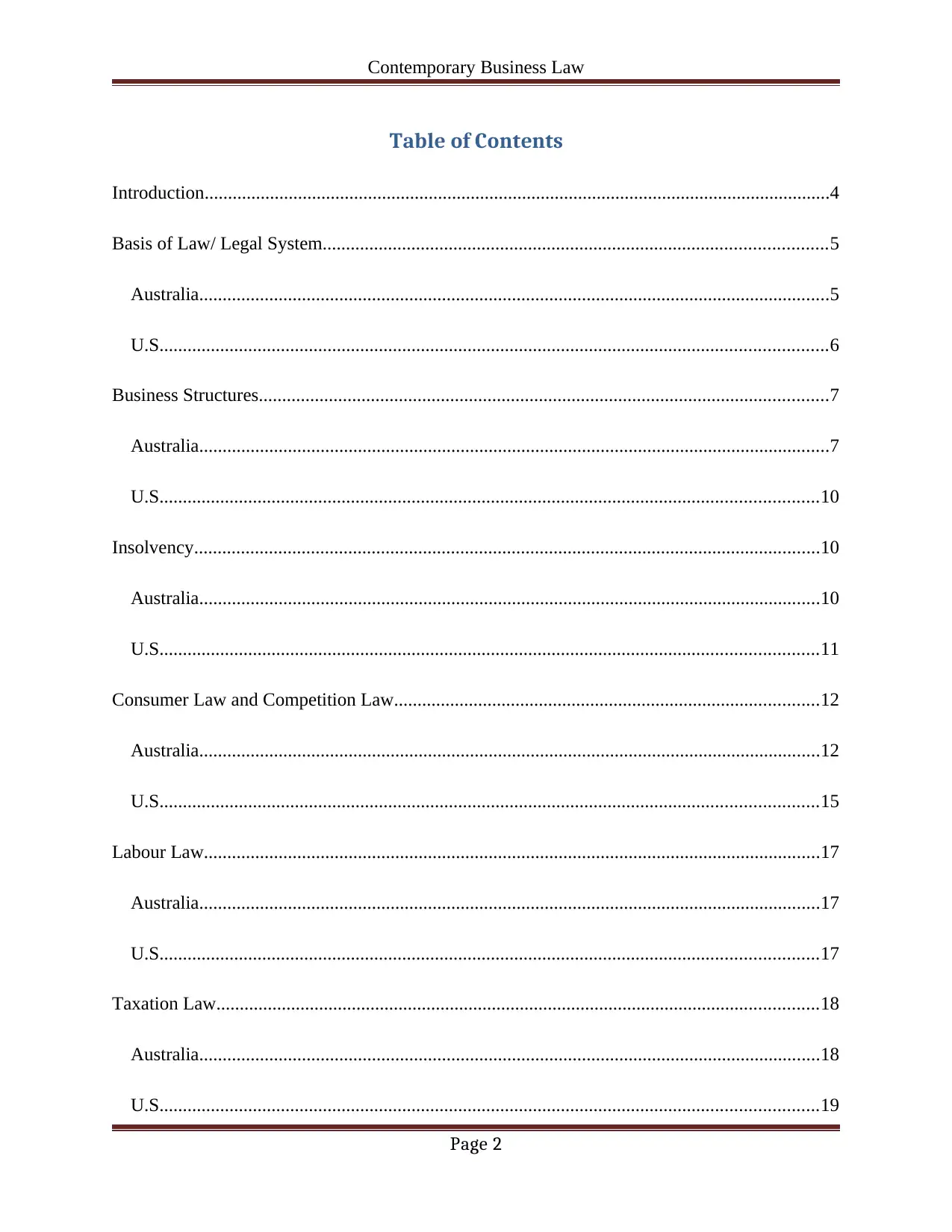
Contemporary Business Law
Table of Contents
Introduction......................................................................................................................................4
Basis of Law/ Legal System............................................................................................................5
Australia.......................................................................................................................................5
U.S...............................................................................................................................................6
Business Structures..........................................................................................................................7
Australia.......................................................................................................................................7
U.S.............................................................................................................................................10
Insolvency......................................................................................................................................10
Australia.....................................................................................................................................10
U.S.............................................................................................................................................11
Consumer Law and Competition Law...........................................................................................12
Australia.....................................................................................................................................12
U.S.............................................................................................................................................15
Labour Law....................................................................................................................................17
Australia.....................................................................................................................................17
U.S.............................................................................................................................................17
Taxation Law.................................................................................................................................18
Australia.....................................................................................................................................18
U.S.............................................................................................................................................19
Page 2
Table of Contents
Introduction......................................................................................................................................4
Basis of Law/ Legal System............................................................................................................5
Australia.......................................................................................................................................5
U.S...............................................................................................................................................6
Business Structures..........................................................................................................................7
Australia.......................................................................................................................................7
U.S.............................................................................................................................................10
Insolvency......................................................................................................................................10
Australia.....................................................................................................................................10
U.S.............................................................................................................................................11
Consumer Law and Competition Law...........................................................................................12
Australia.....................................................................................................................................12
U.S.............................................................................................................................................15
Labour Law....................................................................................................................................17
Australia.....................................................................................................................................17
U.S.............................................................................................................................................17
Taxation Law.................................................................................................................................18
Australia.....................................................................................................................................18
U.S.............................................................................................................................................19
Page 2
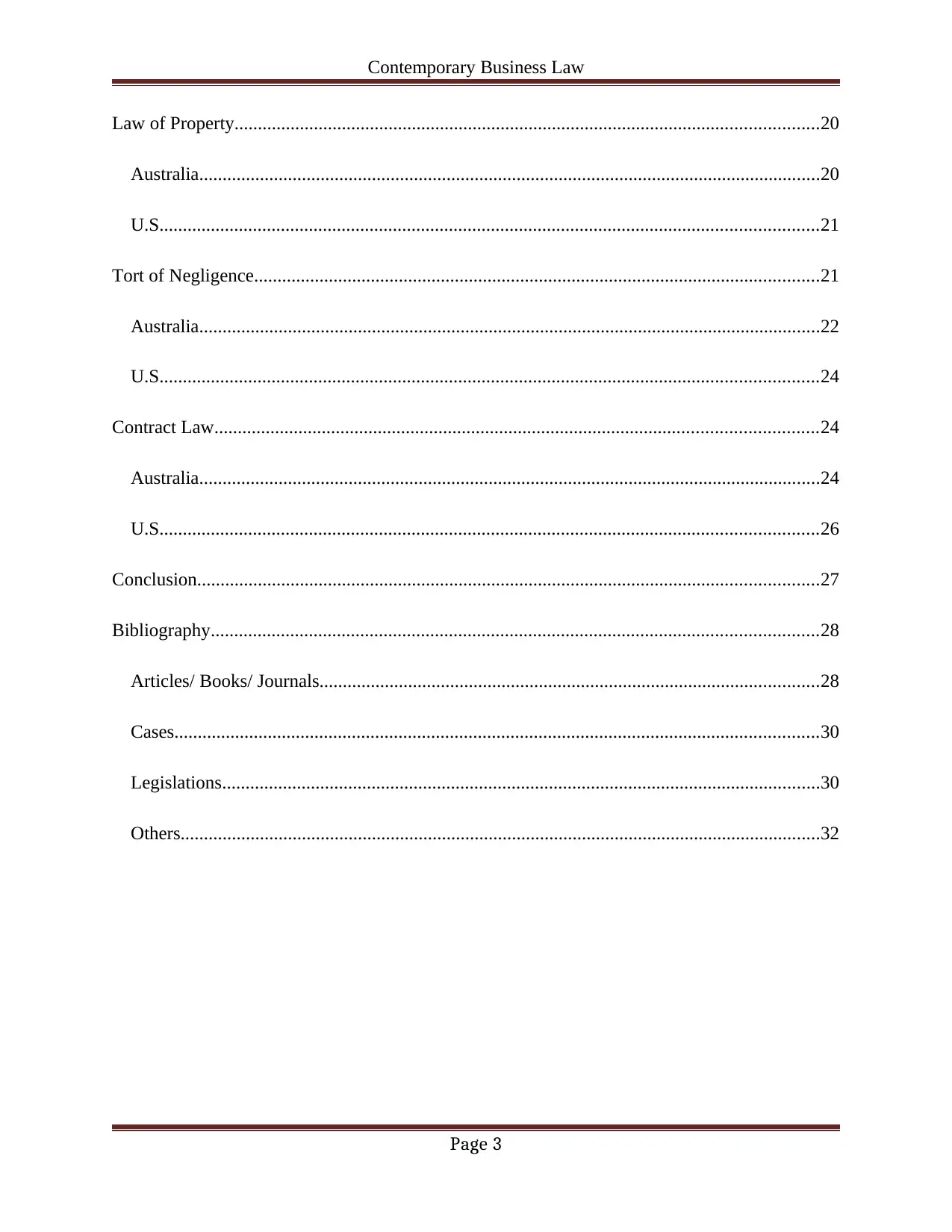
Contemporary Business Law
Law of Property.............................................................................................................................20
Australia.....................................................................................................................................20
U.S.............................................................................................................................................21
Tort of Negligence.........................................................................................................................21
Australia.....................................................................................................................................22
U.S.............................................................................................................................................24
Contract Law.................................................................................................................................24
Australia.....................................................................................................................................24
U.S.............................................................................................................................................26
Conclusion.....................................................................................................................................27
Bibliography..................................................................................................................................28
Articles/ Books/ Journals...........................................................................................................28
Cases..........................................................................................................................................30
Legislations................................................................................................................................30
Others.........................................................................................................................................32
Page 3
Law of Property.............................................................................................................................20
Australia.....................................................................................................................................20
U.S.............................................................................................................................................21
Tort of Negligence.........................................................................................................................21
Australia.....................................................................................................................................22
U.S.............................................................................................................................................24
Contract Law.................................................................................................................................24
Australia.....................................................................................................................................24
U.S.............................................................................................................................................26
Conclusion.....................................................................................................................................27
Bibliography..................................................................................................................................28
Articles/ Books/ Journals...........................................................................................................28
Cases..........................................................................................................................................30
Legislations................................................................................................................................30
Others.........................................................................................................................................32
Page 3
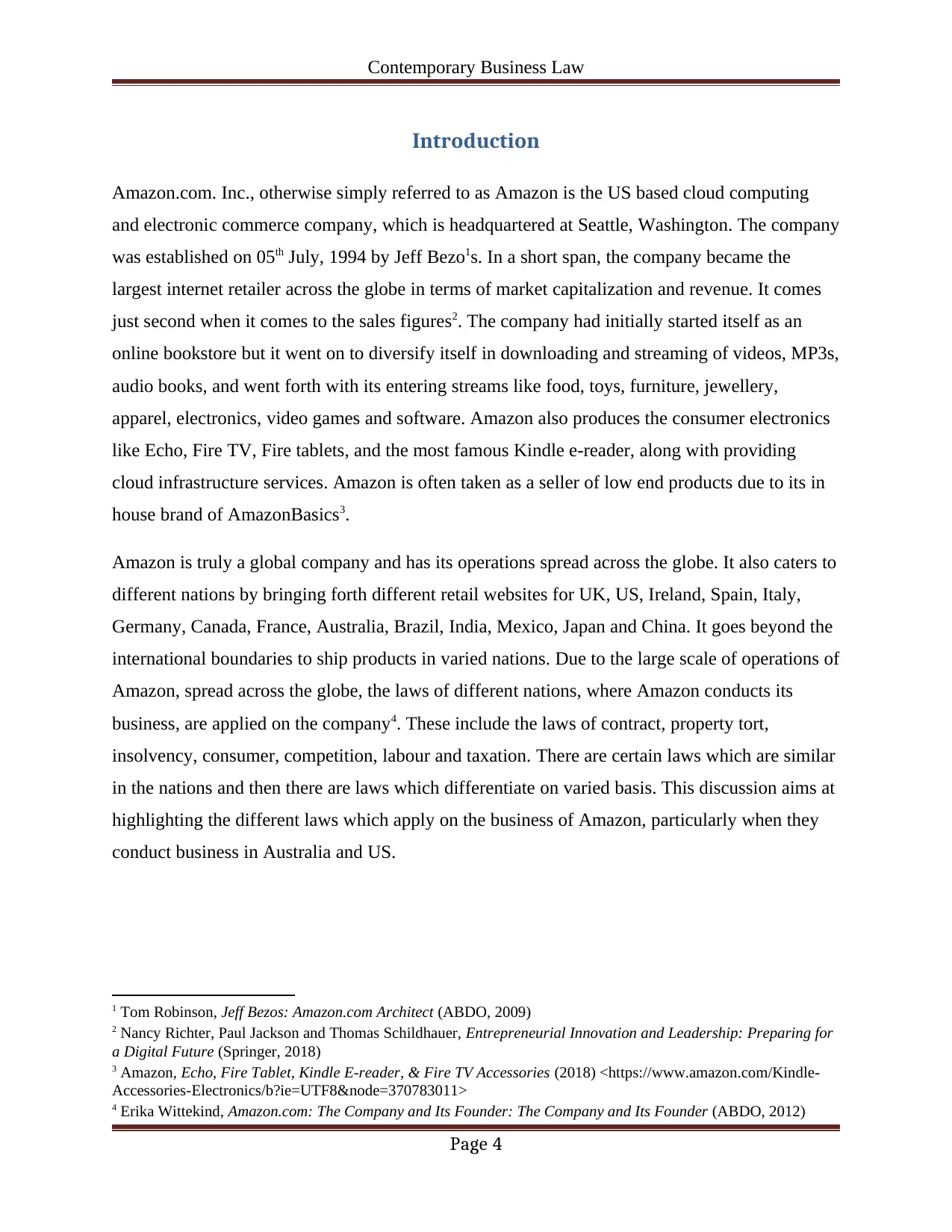
Contemporary Business Law
Introduction
Amazon.com. Inc., otherwise simply referred to as Amazon is the US based cloud computing
and electronic commerce company, which is headquartered at Seattle, Washington. The company
was established on 05th July, 1994 by Jeff Bezo1s. In a short span, the company became the
largest internet retailer across the globe in terms of market capitalization and revenue. It comes
just second when it comes to the sales figures2. The company had initially started itself as an
online bookstore but it went on to diversify itself in downloading and streaming of videos, MP3s,
audio books, and went forth with its entering streams like food, toys, furniture, jewellery,
apparel, electronics, video games and software. Amazon also produces the consumer electronics
like Echo, Fire TV, Fire tablets, and the most famous Kindle e-reader, along with providing
cloud infrastructure services. Amazon is often taken as a seller of low end products due to its in
house brand of AmazonBasics3.
Amazon is truly a global company and has its operations spread across the globe. It also caters to
different nations by bringing forth different retail websites for UK, US, Ireland, Spain, Italy,
Germany, Canada, France, Australia, Brazil, India, Mexico, Japan and China. It goes beyond the
international boundaries to ship products in varied nations. Due to the large scale of operations of
Amazon, spread across the globe, the laws of different nations, where Amazon conducts its
business, are applied on the company4. These include the laws of contract, property tort,
insolvency, consumer, competition, labour and taxation. There are certain laws which are similar
in the nations and then there are laws which differentiate on varied basis. This discussion aims at
highlighting the different laws which apply on the business of Amazon, particularly when they
conduct business in Australia and US.
1 Tom Robinson, Jeff Bezos: Amazon.com Architect (ABDO, 2009)
2 Nancy Richter, Paul Jackson and Thomas Schildhauer, Entrepreneurial Innovation and Leadership: Preparing for
a Digital Future (Springer, 2018)
3 Amazon, Echo, Fire Tablet, Kindle E-reader, & Fire TV Accessories (2018) <https://www.amazon.com/Kindle-
Accessories-Electronics/b?ie=UTF8&node=370783011>
4 Erika Wittekind, Amazon.com: The Company and Its Founder: The Company and Its Founder (ABDO, 2012)
Page 4
Introduction
Amazon.com. Inc., otherwise simply referred to as Amazon is the US based cloud computing
and electronic commerce company, which is headquartered at Seattle, Washington. The company
was established on 05th July, 1994 by Jeff Bezo1s. In a short span, the company became the
largest internet retailer across the globe in terms of market capitalization and revenue. It comes
just second when it comes to the sales figures2. The company had initially started itself as an
online bookstore but it went on to diversify itself in downloading and streaming of videos, MP3s,
audio books, and went forth with its entering streams like food, toys, furniture, jewellery,
apparel, electronics, video games and software. Amazon also produces the consumer electronics
like Echo, Fire TV, Fire tablets, and the most famous Kindle e-reader, along with providing
cloud infrastructure services. Amazon is often taken as a seller of low end products due to its in
house brand of AmazonBasics3.
Amazon is truly a global company and has its operations spread across the globe. It also caters to
different nations by bringing forth different retail websites for UK, US, Ireland, Spain, Italy,
Germany, Canada, France, Australia, Brazil, India, Mexico, Japan and China. It goes beyond the
international boundaries to ship products in varied nations. Due to the large scale of operations of
Amazon, spread across the globe, the laws of different nations, where Amazon conducts its
business, are applied on the company4. These include the laws of contract, property tort,
insolvency, consumer, competition, labour and taxation. There are certain laws which are similar
in the nations and then there are laws which differentiate on varied basis. This discussion aims at
highlighting the different laws which apply on the business of Amazon, particularly when they
conduct business in Australia and US.
1 Tom Robinson, Jeff Bezos: Amazon.com Architect (ABDO, 2009)
2 Nancy Richter, Paul Jackson and Thomas Schildhauer, Entrepreneurial Innovation and Leadership: Preparing for
a Digital Future (Springer, 2018)
3 Amazon, Echo, Fire Tablet, Kindle E-reader, & Fire TV Accessories (2018) <https://www.amazon.com/Kindle-
Accessories-Electronics/b?ie=UTF8&node=370783011>
4 Erika Wittekind, Amazon.com: The Company and Its Founder: The Company and Its Founder (ABDO, 2012)
Page 4
Secure Best Marks with AI Grader
Need help grading? Try our AI Grader for instant feedback on your assignments.
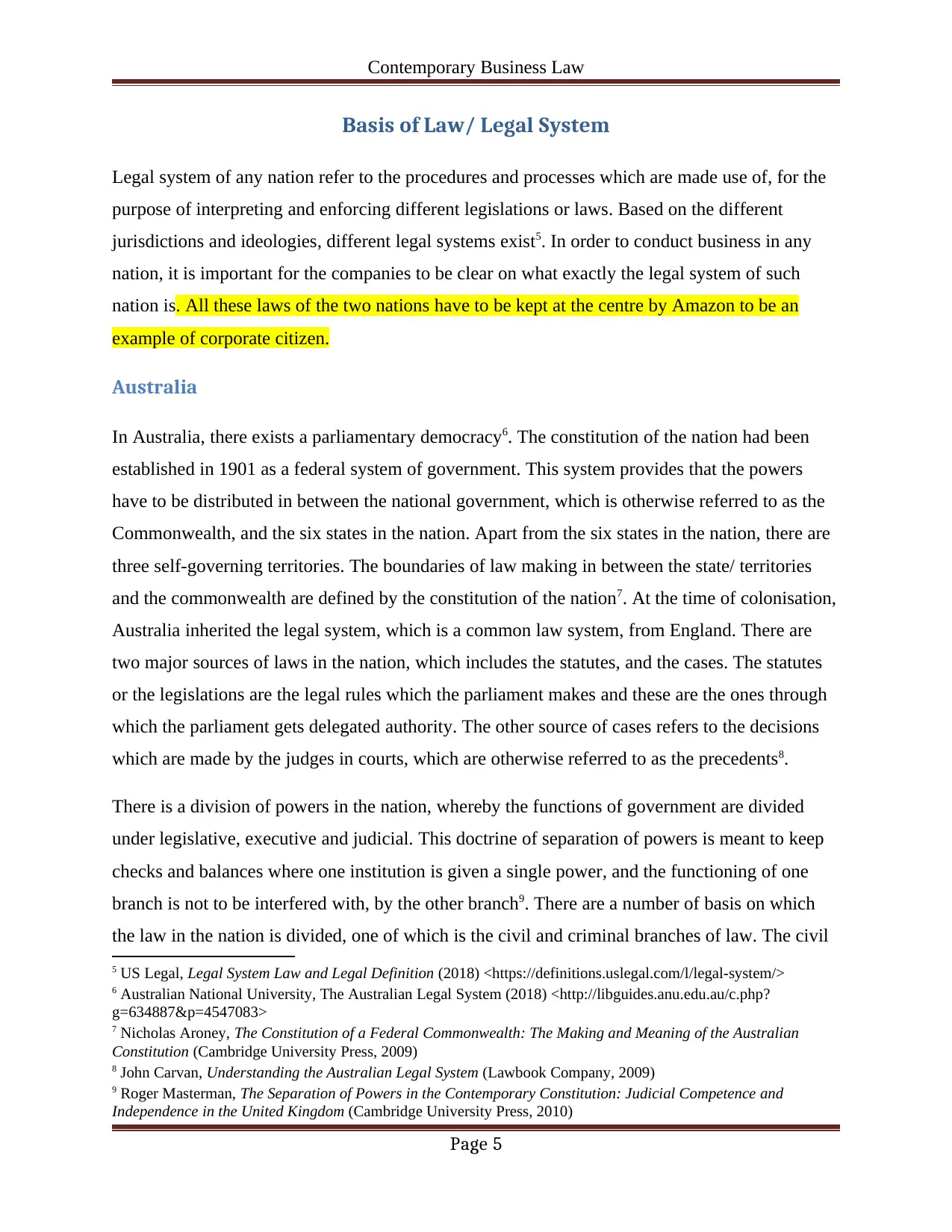
Contemporary Business Law
Basis of Law/ Legal System
Legal system of any nation refer to the procedures and processes which are made use of, for the
purpose of interpreting and enforcing different legislations or laws. Based on the different
jurisdictions and ideologies, different legal systems exist5. In order to conduct business in any
nation, it is important for the companies to be clear on what exactly the legal system of such
nation is. All these laws of the two nations have to be kept at the centre by Amazon to be an
example of corporate citizen.
Australia
In Australia, there exists a parliamentary democracy6. The constitution of the nation had been
established in 1901 as a federal system of government. This system provides that the powers
have to be distributed in between the national government, which is otherwise referred to as the
Commonwealth, and the six states in the nation. Apart from the six states in the nation, there are
three self-governing territories. The boundaries of law making in between the state/ territories
and the commonwealth are defined by the constitution of the nation7. At the time of colonisation,
Australia inherited the legal system, which is a common law system, from England. There are
two major sources of laws in the nation, which includes the statutes, and the cases. The statutes
or the legislations are the legal rules which the parliament makes and these are the ones through
which the parliament gets delegated authority. The other source of cases refers to the decisions
which are made by the judges in courts, which are otherwise referred to as the precedents8.
There is a division of powers in the nation, whereby the functions of government are divided
under legislative, executive and judicial. This doctrine of separation of powers is meant to keep
checks and balances where one institution is given a single power, and the functioning of one
branch is not to be interfered with, by the other branch9. There are a number of basis on which
the law in the nation is divided, one of which is the civil and criminal branches of law. The civil
5 US Legal, Legal System Law and Legal Definition (2018) <https://definitions.uslegal.com/l/legal-system/>
6 Australian National University, The Australian Legal System (2018) <http://libguides.anu.edu.au/c.php?
g=634887&p=4547083>
7 Nicholas Aroney, The Constitution of a Federal Commonwealth: The Making and Meaning of the Australian
Constitution (Cambridge University Press, 2009)
8 John Carvan, Understanding the Australian Legal System (Lawbook Company, 2009)
9 Roger Masterman, The Separation of Powers in the Contemporary Constitution: Judicial Competence and
Independence in the United Kingdom (Cambridge University Press, 2010)
Page 5
Basis of Law/ Legal System
Legal system of any nation refer to the procedures and processes which are made use of, for the
purpose of interpreting and enforcing different legislations or laws. Based on the different
jurisdictions and ideologies, different legal systems exist5. In order to conduct business in any
nation, it is important for the companies to be clear on what exactly the legal system of such
nation is. All these laws of the two nations have to be kept at the centre by Amazon to be an
example of corporate citizen.
Australia
In Australia, there exists a parliamentary democracy6. The constitution of the nation had been
established in 1901 as a federal system of government. This system provides that the powers
have to be distributed in between the national government, which is otherwise referred to as the
Commonwealth, and the six states in the nation. Apart from the six states in the nation, there are
three self-governing territories. The boundaries of law making in between the state/ territories
and the commonwealth are defined by the constitution of the nation7. At the time of colonisation,
Australia inherited the legal system, which is a common law system, from England. There are
two major sources of laws in the nation, which includes the statutes, and the cases. The statutes
or the legislations are the legal rules which the parliament makes and these are the ones through
which the parliament gets delegated authority. The other source of cases refers to the decisions
which are made by the judges in courts, which are otherwise referred to as the precedents8.
There is a division of powers in the nation, whereby the functions of government are divided
under legislative, executive and judicial. This doctrine of separation of powers is meant to keep
checks and balances where one institution is given a single power, and the functioning of one
branch is not to be interfered with, by the other branch9. There are a number of basis on which
the law in the nation is divided, one of which is the civil and criminal branches of law. The civil
5 US Legal, Legal System Law and Legal Definition (2018) <https://definitions.uslegal.com/l/legal-system/>
6 Australian National University, The Australian Legal System (2018) <http://libguides.anu.edu.au/c.php?
g=634887&p=4547083>
7 Nicholas Aroney, The Constitution of a Federal Commonwealth: The Making and Meaning of the Australian
Constitution (Cambridge University Press, 2009)
8 John Carvan, Understanding the Australian Legal System (Lawbook Company, 2009)
9 Roger Masterman, The Separation of Powers in the Contemporary Constitution: Judicial Competence and
Independence in the United Kingdom (Cambridge University Press, 2010)
Page 5
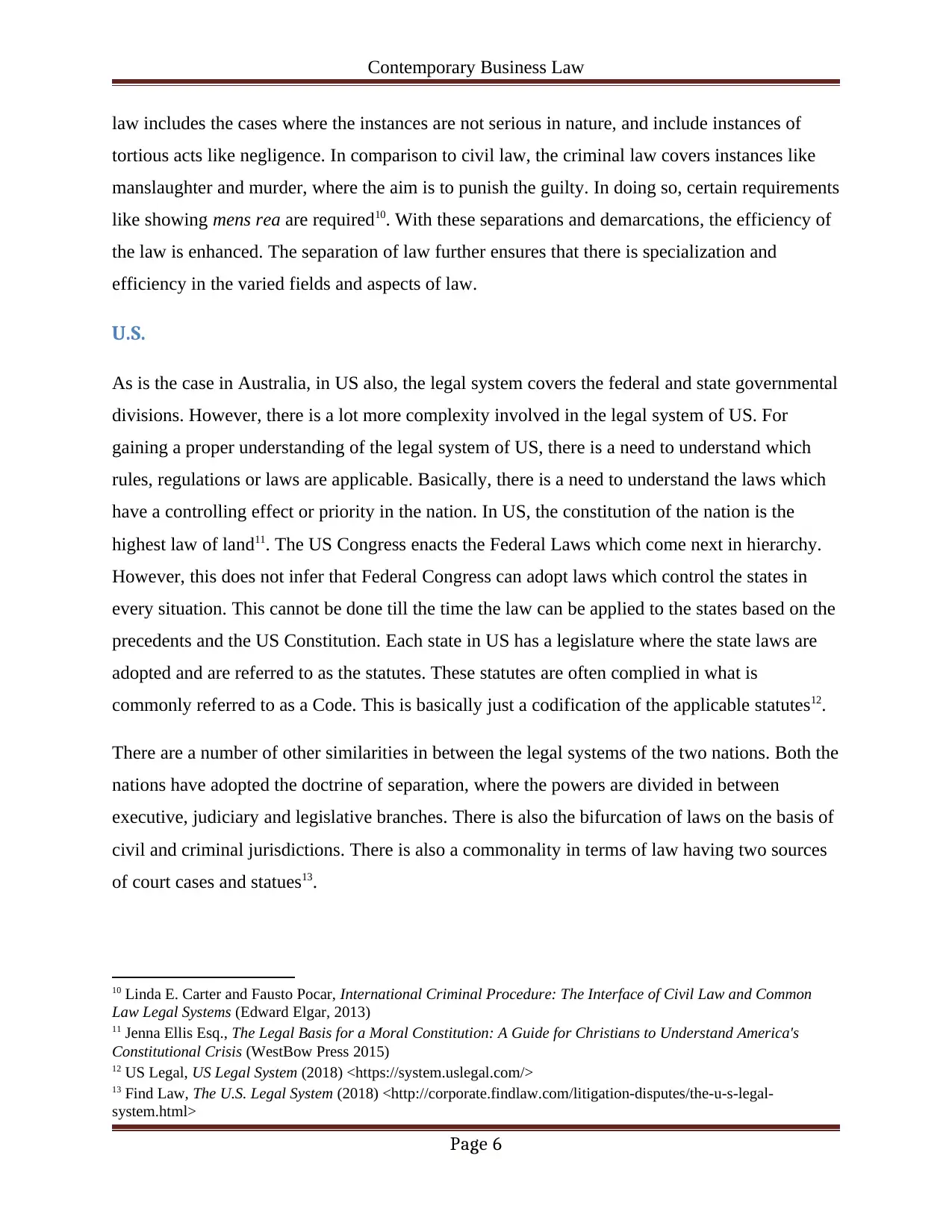
Contemporary Business Law
law includes the cases where the instances are not serious in nature, and include instances of
tortious acts like negligence. In comparison to civil law, the criminal law covers instances like
manslaughter and murder, where the aim is to punish the guilty. In doing so, certain requirements
like showing mens rea are required10. With these separations and demarcations, the efficiency of
the law is enhanced. The separation of law further ensures that there is specialization and
efficiency in the varied fields and aspects of law.
U.S.
As is the case in Australia, in US also, the legal system covers the federal and state governmental
divisions. However, there is a lot more complexity involved in the legal system of US. For
gaining a proper understanding of the legal system of US, there is a need to understand which
rules, regulations or laws are applicable. Basically, there is a need to understand the laws which
have a controlling effect or priority in the nation. In US, the constitution of the nation is the
highest law of land11. The US Congress enacts the Federal Laws which come next in hierarchy.
However, this does not infer that Federal Congress can adopt laws which control the states in
every situation. This cannot be done till the time the law can be applied to the states based on the
precedents and the US Constitution. Each state in US has a legislature where the state laws are
adopted and are referred to as the statutes. These statutes are often complied in what is
commonly referred to as a Code. This is basically just a codification of the applicable statutes12.
There are a number of other similarities in between the legal systems of the two nations. Both the
nations have adopted the doctrine of separation, where the powers are divided in between
executive, judiciary and legislative branches. There is also the bifurcation of laws on the basis of
civil and criminal jurisdictions. There is also a commonality in terms of law having two sources
of court cases and statues13.
10 Linda E. Carter and Fausto Pocar, International Criminal Procedure: The Interface of Civil Law and Common
Law Legal Systems (Edward Elgar, 2013)
11 Jenna Ellis Esq., The Legal Basis for a Moral Constitution: A Guide for Christians to Understand America's
Constitutional Crisis (WestBow Press 2015)
12 US Legal, US Legal System (2018) <https://system.uslegal.com/>
13 Find Law, The U.S. Legal System (2018) <http://corporate.findlaw.com/litigation-disputes/the-u-s-legal-
system.html>
Page 6
law includes the cases where the instances are not serious in nature, and include instances of
tortious acts like negligence. In comparison to civil law, the criminal law covers instances like
manslaughter and murder, where the aim is to punish the guilty. In doing so, certain requirements
like showing mens rea are required10. With these separations and demarcations, the efficiency of
the law is enhanced. The separation of law further ensures that there is specialization and
efficiency in the varied fields and aspects of law.
U.S.
As is the case in Australia, in US also, the legal system covers the federal and state governmental
divisions. However, there is a lot more complexity involved in the legal system of US. For
gaining a proper understanding of the legal system of US, there is a need to understand which
rules, regulations or laws are applicable. Basically, there is a need to understand the laws which
have a controlling effect or priority in the nation. In US, the constitution of the nation is the
highest law of land11. The US Congress enacts the Federal Laws which come next in hierarchy.
However, this does not infer that Federal Congress can adopt laws which control the states in
every situation. This cannot be done till the time the law can be applied to the states based on the
precedents and the US Constitution. Each state in US has a legislature where the state laws are
adopted and are referred to as the statutes. These statutes are often complied in what is
commonly referred to as a Code. This is basically just a codification of the applicable statutes12.
There are a number of other similarities in between the legal systems of the two nations. Both the
nations have adopted the doctrine of separation, where the powers are divided in between
executive, judiciary and legislative branches. There is also the bifurcation of laws on the basis of
civil and criminal jurisdictions. There is also a commonality in terms of law having two sources
of court cases and statues13.
10 Linda E. Carter and Fausto Pocar, International Criminal Procedure: The Interface of Civil Law and Common
Law Legal Systems (Edward Elgar, 2013)
11 Jenna Ellis Esq., The Legal Basis for a Moral Constitution: A Guide for Christians to Understand America's
Constitutional Crisis (WestBow Press 2015)
12 US Legal, US Legal System (2018) <https://system.uslegal.com/>
13 Find Law, The U.S. Legal System (2018) <http://corporate.findlaw.com/litigation-disputes/the-u-s-legal-
system.html>
Page 6
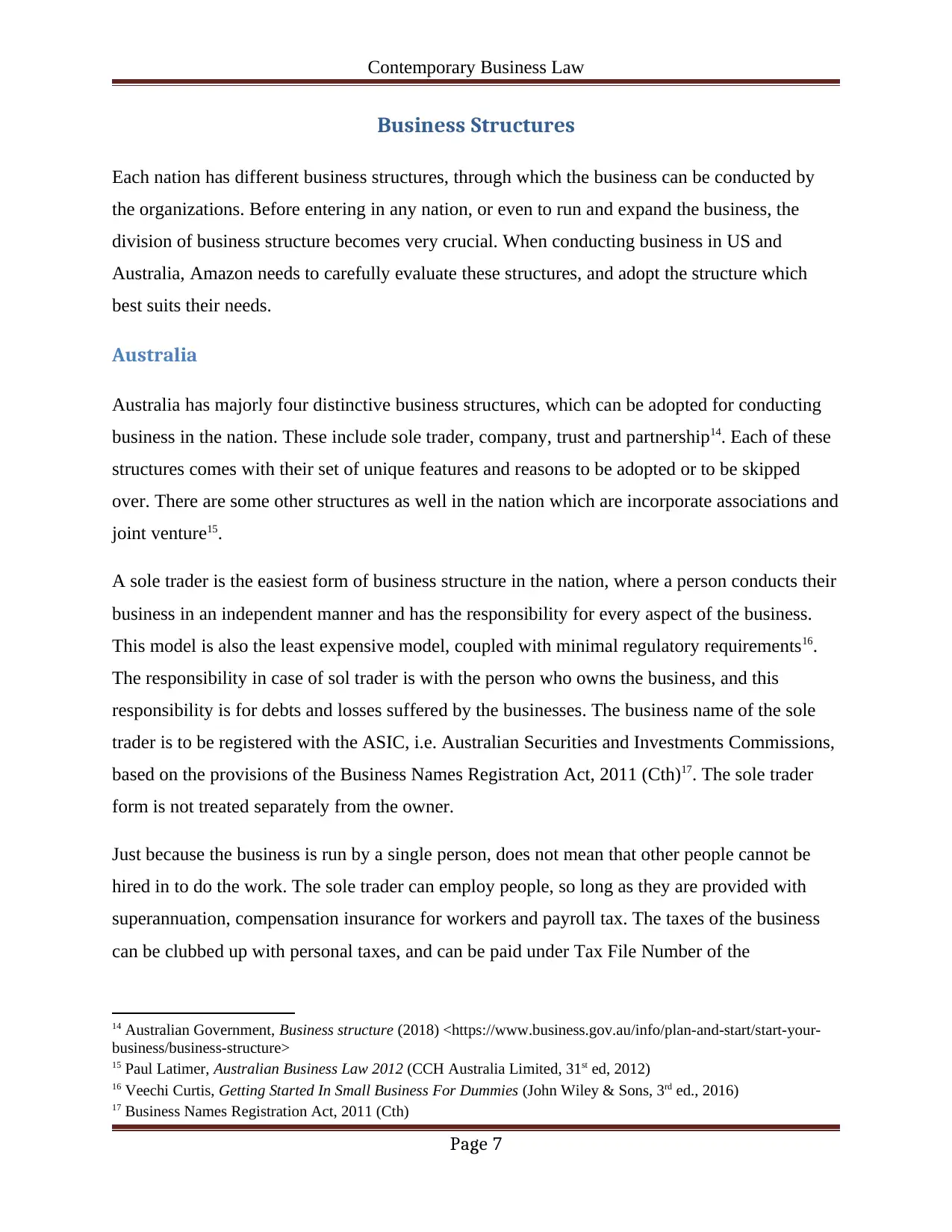
Contemporary Business Law
Business Structures
Each nation has different business structures, through which the business can be conducted by
the organizations. Before entering in any nation, or even to run and expand the business, the
division of business structure becomes very crucial. When conducting business in US and
Australia, Amazon needs to carefully evaluate these structures, and adopt the structure which
best suits their needs.
Australia
Australia has majorly four distinctive business structures, which can be adopted for conducting
business in the nation. These include sole trader, company, trust and partnership14. Each of these
structures comes with their set of unique features and reasons to be adopted or to be skipped
over. There are some other structures as well in the nation which are incorporate associations and
joint venture15.
A sole trader is the easiest form of business structure in the nation, where a person conducts their
business in an independent manner and has the responsibility for every aspect of the business.
This model is also the least expensive model, coupled with minimal regulatory requirements16.
The responsibility in case of sol trader is with the person who owns the business, and this
responsibility is for debts and losses suffered by the businesses. The business name of the sole
trader is to be registered with the ASIC, i.e. Australian Securities and Investments Commissions,
based on the provisions of the Business Names Registration Act, 2011 (Cth)17. The sole trader
form is not treated separately from the owner.
Just because the business is run by a single person, does not mean that other people cannot be
hired in to do the work. The sole trader can employ people, so long as they are provided with
superannuation, compensation insurance for workers and payroll tax. The taxes of the business
can be clubbed up with personal taxes, and can be paid under Tax File Number of the
14 Australian Government, Business structure (2018) <https://www.business.gov.au/info/plan-and-start/start-your-
business/business-structure>
15 Paul Latimer, Australian Business Law 2012 (CCH Australia Limited, 31st ed, 2012)
16 Veechi Curtis, Getting Started In Small Business For Dummies (John Wiley & Sons, 3rd ed., 2016)
17 Business Names Registration Act, 2011 (Cth)
Page 7
Business Structures
Each nation has different business structures, through which the business can be conducted by
the organizations. Before entering in any nation, or even to run and expand the business, the
division of business structure becomes very crucial. When conducting business in US and
Australia, Amazon needs to carefully evaluate these structures, and adopt the structure which
best suits their needs.
Australia
Australia has majorly four distinctive business structures, which can be adopted for conducting
business in the nation. These include sole trader, company, trust and partnership14. Each of these
structures comes with their set of unique features and reasons to be adopted or to be skipped
over. There are some other structures as well in the nation which are incorporate associations and
joint venture15.
A sole trader is the easiest form of business structure in the nation, where a person conducts their
business in an independent manner and has the responsibility for every aspect of the business.
This model is also the least expensive model, coupled with minimal regulatory requirements16.
The responsibility in case of sol trader is with the person who owns the business, and this
responsibility is for debts and losses suffered by the businesses. The business name of the sole
trader is to be registered with the ASIC, i.e. Australian Securities and Investments Commissions,
based on the provisions of the Business Names Registration Act, 2011 (Cth)17. The sole trader
form is not treated separately from the owner.
Just because the business is run by a single person, does not mean that other people cannot be
hired in to do the work. The sole trader can employ people, so long as they are provided with
superannuation, compensation insurance for workers and payroll tax. The taxes of the business
can be clubbed up with personal taxes, and can be paid under Tax File Number of the
14 Australian Government, Business structure (2018) <https://www.business.gov.au/info/plan-and-start/start-your-
business/business-structure>
15 Paul Latimer, Australian Business Law 2012 (CCH Australia Limited, 31st ed, 2012)
16 Veechi Curtis, Getting Started In Small Business For Dummies (John Wiley & Sons, 3rd ed., 2016)
17 Business Names Registration Act, 2011 (Cth)
Page 7
Paraphrase This Document
Need a fresh take? Get an instant paraphrase of this document with our AI Paraphraser

Contemporary Business Law
individual18. However, the sole traders have unlimited liability. This means that for the debts of
the sole trader, the personal assets of the sole trader can be attached. But this form brings with it
a level of simplicity and flexibility which makes it as the structure of choice for a number of
businesses19.
The next business structure form is partnership. A partnership can be created when two or more
individuals, up to a limit of twenty people, come together to run a business with common
purpose, for earning profits. The partnership can be formed where the features of a partnership
are met, even when the same are not reduced into writing in a partnership deed, as it is not an
obligatory document20. Each jurisdiction in Australia has a different partnership act. For instance,
in New South Wales, the Partnership Act, 189221 is applicable. There is equal responsibility
under the partnership, whereby the partners are jointly and severally liable for the debts of the
firm. There is applicability of agency law on partnership, which make all the partners binding to
one another. Again, this is a relatively easier and inexpensive mode of setting up a business.
However, instances like quarrels and fights can run in partnership ending. There is also the con
of unlimited liability amongst the partners22.
The most common form of running business in Australia is the corporations form. Under this
form, the business is run by the management on behalf of the shareholders. The companies in
Australia are governed by the Corporations Act, 200123 and are regulated by the ASIC. As
against the business structures of partnership and sole trader, the company is deemed as a
separate legal entity. This means that for the debts of the company, the shareholders cannot be
made liable. They can only be made liable in the event of company being wound up, where they
have any unpaid amount left on the shares. Beyond that, they cannot be made liable. The
directors of the company run the daily operations24.
18 Department of Industry, Innovation and Science, Sole trader (7 June 2017)
<https://www.business.gov.au/info/plan-and-start/start-your-business/business-structure/business-structures-and-
types/sole-trader>
19 Roger Vickery and MaryAnne Flood, Australian business law: compliance and practice (Pearson Australia, 2012)
20 Joseph Story, Commentaries on the Law of Partnership, as a Branch of Commercial and Maritime Jurisprudence,
with Occasional Illustrations from the Civil and Foreign Law (The Lawbook Exchange, Ltd., 2007)
21 Partnership Act, 1892 (NSW)
22 Andy Gibson and Douglas Fraser, Business Law (Pearson Higher Education AU, 2013)
23 Corporations Act, 2001 (Cth)
24 Phillip Lipton, Abe Herzberg, and Michelle Welsh, Understanding Company Law (Thomson Reuters, 18th ed,
2016)
Page 8
individual18. However, the sole traders have unlimited liability. This means that for the debts of
the sole trader, the personal assets of the sole trader can be attached. But this form brings with it
a level of simplicity and flexibility which makes it as the structure of choice for a number of
businesses19.
The next business structure form is partnership. A partnership can be created when two or more
individuals, up to a limit of twenty people, come together to run a business with common
purpose, for earning profits. The partnership can be formed where the features of a partnership
are met, even when the same are not reduced into writing in a partnership deed, as it is not an
obligatory document20. Each jurisdiction in Australia has a different partnership act. For instance,
in New South Wales, the Partnership Act, 189221 is applicable. There is equal responsibility
under the partnership, whereby the partners are jointly and severally liable for the debts of the
firm. There is applicability of agency law on partnership, which make all the partners binding to
one another. Again, this is a relatively easier and inexpensive mode of setting up a business.
However, instances like quarrels and fights can run in partnership ending. There is also the con
of unlimited liability amongst the partners22.
The most common form of running business in Australia is the corporations form. Under this
form, the business is run by the management on behalf of the shareholders. The companies in
Australia are governed by the Corporations Act, 200123 and are regulated by the ASIC. As
against the business structures of partnership and sole trader, the company is deemed as a
separate legal entity. This means that for the debts of the company, the shareholders cannot be
made liable. They can only be made liable in the event of company being wound up, where they
have any unpaid amount left on the shares. Beyond that, they cannot be made liable. The
directors of the company run the daily operations24.
18 Department of Industry, Innovation and Science, Sole trader (7 June 2017)
<https://www.business.gov.au/info/plan-and-start/start-your-business/business-structure/business-structures-and-
types/sole-trader>
19 Roger Vickery and MaryAnne Flood, Australian business law: compliance and practice (Pearson Australia, 2012)
20 Joseph Story, Commentaries on the Law of Partnership, as a Branch of Commercial and Maritime Jurisprudence,
with Occasional Illustrations from the Civil and Foreign Law (The Lawbook Exchange, Ltd., 2007)
21 Partnership Act, 1892 (NSW)
22 Andy Gibson and Douglas Fraser, Business Law (Pearson Higher Education AU, 2013)
23 Corporations Act, 2001 (Cth)
24 Phillip Lipton, Abe Herzberg, and Michelle Welsh, Understanding Company Law (Thomson Reuters, 18th ed,
2016)
Page 8
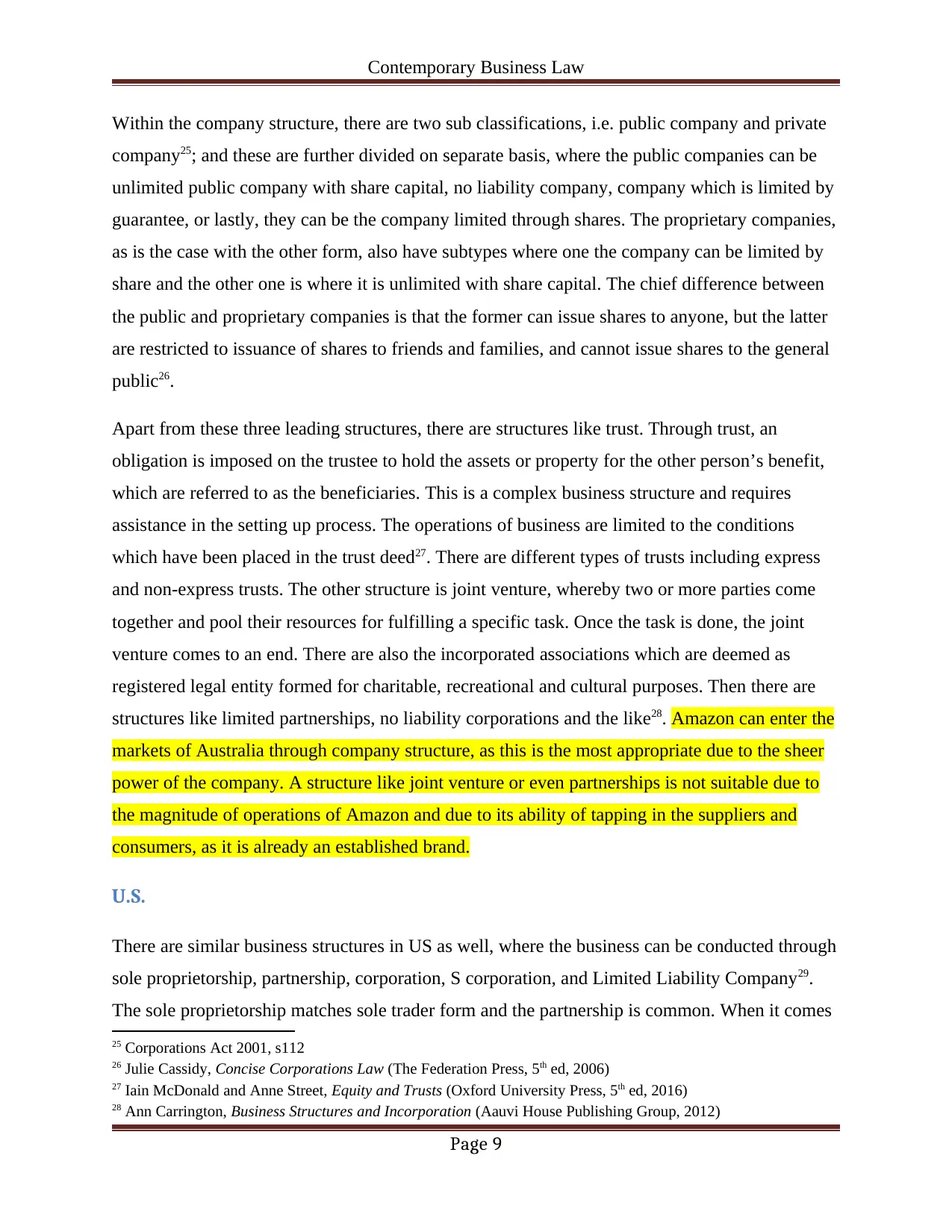
Contemporary Business Law
Within the company structure, there are two sub classifications, i.e. public company and private
company25; and these are further divided on separate basis, where the public companies can be
unlimited public company with share capital, no liability company, company which is limited by
guarantee, or lastly, they can be the company limited through shares. The proprietary companies,
as is the case with the other form, also have subtypes where one the company can be limited by
share and the other one is where it is unlimited with share capital. The chief difference between
the public and proprietary companies is that the former can issue shares to anyone, but the latter
are restricted to issuance of shares to friends and families, and cannot issue shares to the general
public26.
Apart from these three leading structures, there are structures like trust. Through trust, an
obligation is imposed on the trustee to hold the assets or property for the other person’s benefit,
which are referred to as the beneficiaries. This is a complex business structure and requires
assistance in the setting up process. The operations of business are limited to the conditions
which have been placed in the trust deed27. There are different types of trusts including express
and non-express trusts. The other structure is joint venture, whereby two or more parties come
together and pool their resources for fulfilling a specific task. Once the task is done, the joint
venture comes to an end. There are also the incorporated associations which are deemed as
registered legal entity formed for charitable, recreational and cultural purposes. Then there are
structures like limited partnerships, no liability corporations and the like28. Amazon can enter the
markets of Australia through company structure, as this is the most appropriate due to the sheer
power of the company. A structure like joint venture or even partnerships is not suitable due to
the magnitude of operations of Amazon and due to its ability of tapping in the suppliers and
consumers, as it is already an established brand.
U.S.
There are similar business structures in US as well, where the business can be conducted through
sole proprietorship, partnership, corporation, S corporation, and Limited Liability Company29.
The sole proprietorship matches sole trader form and the partnership is common. When it comes
25 Corporations Act 2001, s112
26 Julie Cassidy, Concise Corporations Law (The Federation Press, 5th ed, 2006)
27 Iain McDonald and Anne Street, Equity and Trusts (Oxford University Press, 5th ed, 2016)
28 Ann Carrington, Business Structures and Incorporation (Aauvi House Publishing Group, 2012)
Page 9
Within the company structure, there are two sub classifications, i.e. public company and private
company25; and these are further divided on separate basis, where the public companies can be
unlimited public company with share capital, no liability company, company which is limited by
guarantee, or lastly, they can be the company limited through shares. The proprietary companies,
as is the case with the other form, also have subtypes where one the company can be limited by
share and the other one is where it is unlimited with share capital. The chief difference between
the public and proprietary companies is that the former can issue shares to anyone, but the latter
are restricted to issuance of shares to friends and families, and cannot issue shares to the general
public26.
Apart from these three leading structures, there are structures like trust. Through trust, an
obligation is imposed on the trustee to hold the assets or property for the other person’s benefit,
which are referred to as the beneficiaries. This is a complex business structure and requires
assistance in the setting up process. The operations of business are limited to the conditions
which have been placed in the trust deed27. There are different types of trusts including express
and non-express trusts. The other structure is joint venture, whereby two or more parties come
together and pool their resources for fulfilling a specific task. Once the task is done, the joint
venture comes to an end. There are also the incorporated associations which are deemed as
registered legal entity formed for charitable, recreational and cultural purposes. Then there are
structures like limited partnerships, no liability corporations and the like28. Amazon can enter the
markets of Australia through company structure, as this is the most appropriate due to the sheer
power of the company. A structure like joint venture or even partnerships is not suitable due to
the magnitude of operations of Amazon and due to its ability of tapping in the suppliers and
consumers, as it is already an established brand.
U.S.
There are similar business structures in US as well, where the business can be conducted through
sole proprietorship, partnership, corporation, S corporation, and Limited Liability Company29.
The sole proprietorship matches sole trader form and the partnership is common. When it comes
25 Corporations Act 2001, s112
26 Julie Cassidy, Concise Corporations Law (The Federation Press, 5th ed, 2006)
27 Iain McDonald and Anne Street, Equity and Trusts (Oxford University Press, 5th ed, 2016)
28 Ann Carrington, Business Structures and Incorporation (Aauvi House Publishing Group, 2012)
Page 9
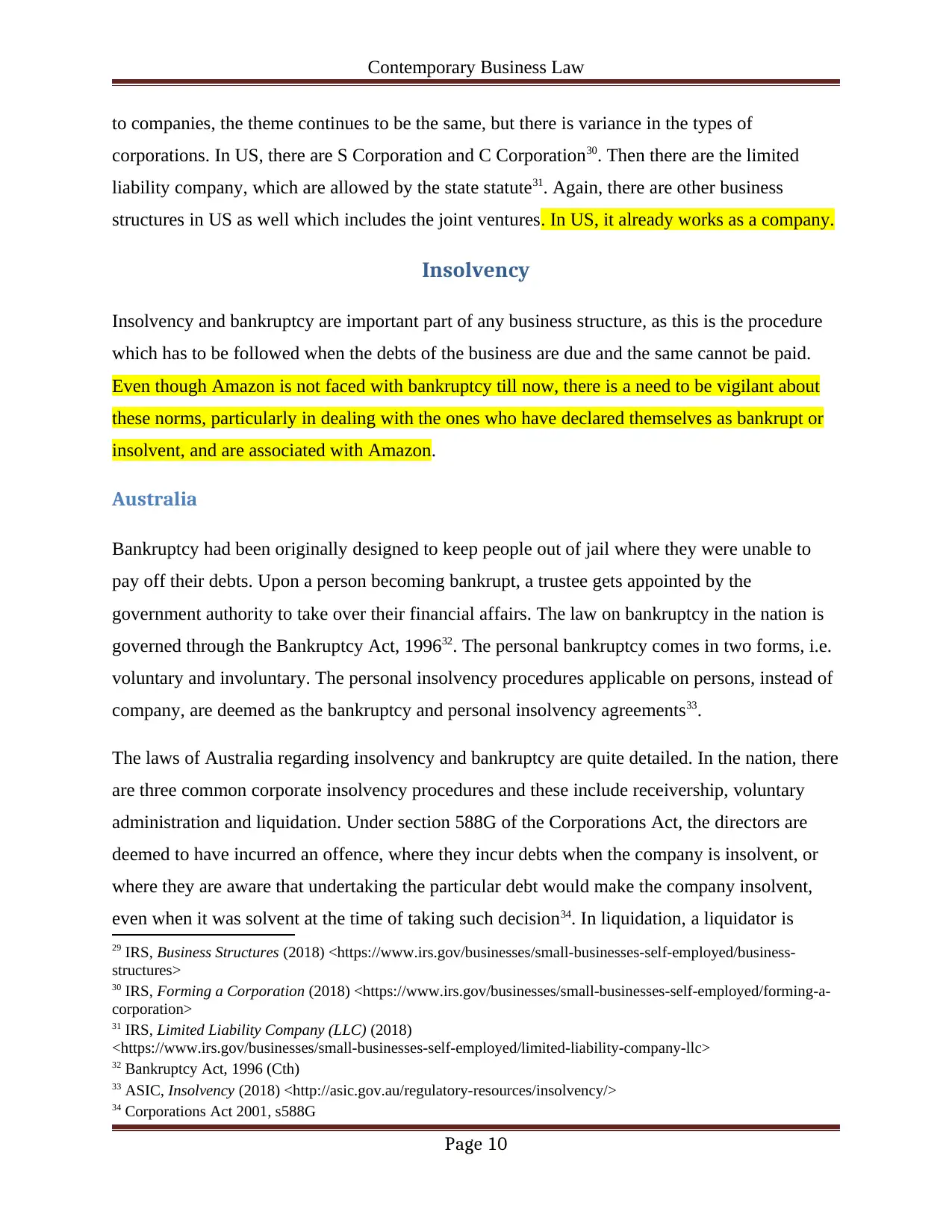
Contemporary Business Law
to companies, the theme continues to be the same, but there is variance in the types of
corporations. In US, there are S Corporation and C Corporation30. Then there are the limited
liability company, which are allowed by the state statute31. Again, there are other business
structures in US as well which includes the joint ventures. In US, it already works as a company.
Insolvency
Insolvency and bankruptcy are important part of any business structure, as this is the procedure
which has to be followed when the debts of the business are due and the same cannot be paid.
Even though Amazon is not faced with bankruptcy till now, there is a need to be vigilant about
these norms, particularly in dealing with the ones who have declared themselves as bankrupt or
insolvent, and are associated with Amazon.
Australia
Bankruptcy had been originally designed to keep people out of jail where they were unable to
pay off their debts. Upon a person becoming bankrupt, a trustee gets appointed by the
government authority to take over their financial affairs. The law on bankruptcy in the nation is
governed through the Bankruptcy Act, 199632. The personal bankruptcy comes in two forms, i.e.
voluntary and involuntary. The personal insolvency procedures applicable on persons, instead of
company, are deemed as the bankruptcy and personal insolvency agreements33.
The laws of Australia regarding insolvency and bankruptcy are quite detailed. In the nation, there
are three common corporate insolvency procedures and these include receivership, voluntary
administration and liquidation. Under section 588G of the Corporations Act, the directors are
deemed to have incurred an offence, where they incur debts when the company is insolvent, or
where they are aware that undertaking the particular debt would make the company insolvent,
even when it was solvent at the time of taking such decision34. In liquidation, a liquidator is
29 IRS, Business Structures (2018) <https://www.irs.gov/businesses/small-businesses-self-employed/business-
structures>
30 IRS, Forming a Corporation (2018) <https://www.irs.gov/businesses/small-businesses-self-employed/forming-a-
corporation>
31 IRS, Limited Liability Company (LLC) (2018)
<https://www.irs.gov/businesses/small-businesses-self-employed/limited-liability-company-llc>
32 Bankruptcy Act, 1996 (Cth)
33 ASIC, Insolvency (2018) <http://asic.gov.au/regulatory-resources/insolvency/>
34 Corporations Act 2001, s588G
Page 10
to companies, the theme continues to be the same, but there is variance in the types of
corporations. In US, there are S Corporation and C Corporation30. Then there are the limited
liability company, which are allowed by the state statute31. Again, there are other business
structures in US as well which includes the joint ventures. In US, it already works as a company.
Insolvency
Insolvency and bankruptcy are important part of any business structure, as this is the procedure
which has to be followed when the debts of the business are due and the same cannot be paid.
Even though Amazon is not faced with bankruptcy till now, there is a need to be vigilant about
these norms, particularly in dealing with the ones who have declared themselves as bankrupt or
insolvent, and are associated with Amazon.
Australia
Bankruptcy had been originally designed to keep people out of jail where they were unable to
pay off their debts. Upon a person becoming bankrupt, a trustee gets appointed by the
government authority to take over their financial affairs. The law on bankruptcy in the nation is
governed through the Bankruptcy Act, 199632. The personal bankruptcy comes in two forms, i.e.
voluntary and involuntary. The personal insolvency procedures applicable on persons, instead of
company, are deemed as the bankruptcy and personal insolvency agreements33.
The laws of Australia regarding insolvency and bankruptcy are quite detailed. In the nation, there
are three common corporate insolvency procedures and these include receivership, voluntary
administration and liquidation. Under section 588G of the Corporations Act, the directors are
deemed to have incurred an offence, where they incur debts when the company is insolvent, or
where they are aware that undertaking the particular debt would make the company insolvent,
even when it was solvent at the time of taking such decision34. In liquidation, a liquidator is
29 IRS, Business Structures (2018) <https://www.irs.gov/businesses/small-businesses-self-employed/business-
structures>
30 IRS, Forming a Corporation (2018) <https://www.irs.gov/businesses/small-businesses-self-employed/forming-a-
corporation>
31 IRS, Limited Liability Company (LLC) (2018)
<https://www.irs.gov/businesses/small-businesses-self-employed/limited-liability-company-llc>
32 Bankruptcy Act, 1996 (Cth)
33 ASIC, Insolvency (2018) <http://asic.gov.au/regulatory-resources/insolvency/>
34 Corporations Act 2001, s588G
Page 10
Secure Best Marks with AI Grader
Need help grading? Try our AI Grader for instant feedback on your assignments.
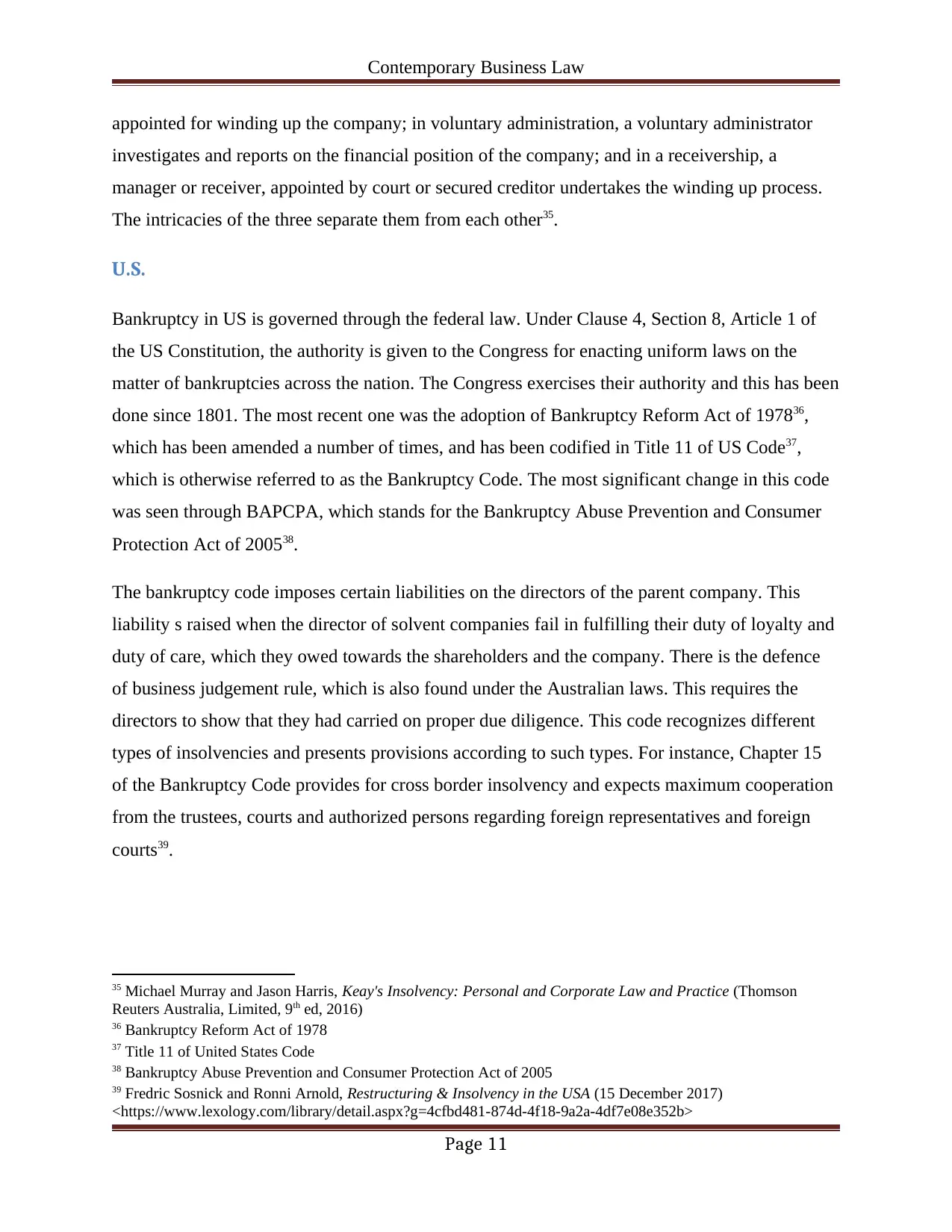
Contemporary Business Law
appointed for winding up the company; in voluntary administration, a voluntary administrator
investigates and reports on the financial position of the company; and in a receivership, a
manager or receiver, appointed by court or secured creditor undertakes the winding up process.
The intricacies of the three separate them from each other35.
U.S.
Bankruptcy in US is governed through the federal law. Under Clause 4, Section 8, Article 1 of
the US Constitution, the authority is given to the Congress for enacting uniform laws on the
matter of bankruptcies across the nation. The Congress exercises their authority and this has been
done since 1801. The most recent one was the adoption of Bankruptcy Reform Act of 197836,
which has been amended a number of times, and has been codified in Title 11 of US Code37,
which is otherwise referred to as the Bankruptcy Code. The most significant change in this code
was seen through BAPCPA, which stands for the Bankruptcy Abuse Prevention and Consumer
Protection Act of 200538.
The bankruptcy code imposes certain liabilities on the directors of the parent company. This
liability s raised when the director of solvent companies fail in fulfilling their duty of loyalty and
duty of care, which they owed towards the shareholders and the company. There is the defence
of business judgement rule, which is also found under the Australian laws. This requires the
directors to show that they had carried on proper due diligence. This code recognizes different
types of insolvencies and presents provisions according to such types. For instance, Chapter 15
of the Bankruptcy Code provides for cross border insolvency and expects maximum cooperation
from the trustees, courts and authorized persons regarding foreign representatives and foreign
courts39.
35 Michael Murray and Jason Harris, Keay's Insolvency: Personal and Corporate Law and Practice (Thomson
Reuters Australia, Limited, 9th ed, 2016)
36 Bankruptcy Reform Act of 1978
37 Title 11 of United States Code
38 Bankruptcy Abuse Prevention and Consumer Protection Act of 2005
39 Fredric Sosnick and Ronni Arnold, Restructuring & Insolvency in the USA (15 December 2017)
<https://www.lexology.com/library/detail.aspx?g=4cfbd481-874d-4f18-9a2a-4df7e08e352b>
Page 11
appointed for winding up the company; in voluntary administration, a voluntary administrator
investigates and reports on the financial position of the company; and in a receivership, a
manager or receiver, appointed by court or secured creditor undertakes the winding up process.
The intricacies of the three separate them from each other35.
U.S.
Bankruptcy in US is governed through the federal law. Under Clause 4, Section 8, Article 1 of
the US Constitution, the authority is given to the Congress for enacting uniform laws on the
matter of bankruptcies across the nation. The Congress exercises their authority and this has been
done since 1801. The most recent one was the adoption of Bankruptcy Reform Act of 197836,
which has been amended a number of times, and has been codified in Title 11 of US Code37,
which is otherwise referred to as the Bankruptcy Code. The most significant change in this code
was seen through BAPCPA, which stands for the Bankruptcy Abuse Prevention and Consumer
Protection Act of 200538.
The bankruptcy code imposes certain liabilities on the directors of the parent company. This
liability s raised when the director of solvent companies fail in fulfilling their duty of loyalty and
duty of care, which they owed towards the shareholders and the company. There is the defence
of business judgement rule, which is also found under the Australian laws. This requires the
directors to show that they had carried on proper due diligence. This code recognizes different
types of insolvencies and presents provisions according to such types. For instance, Chapter 15
of the Bankruptcy Code provides for cross border insolvency and expects maximum cooperation
from the trustees, courts and authorized persons regarding foreign representatives and foreign
courts39.
35 Michael Murray and Jason Harris, Keay's Insolvency: Personal and Corporate Law and Practice (Thomson
Reuters Australia, Limited, 9th ed, 2016)
36 Bankruptcy Reform Act of 1978
37 Title 11 of United States Code
38 Bankruptcy Abuse Prevention and Consumer Protection Act of 2005
39 Fredric Sosnick and Ronni Arnold, Restructuring & Insolvency in the USA (15 December 2017)
<https://www.lexology.com/library/detail.aspx?g=4cfbd481-874d-4f18-9a2a-4df7e08e352b>
Page 11
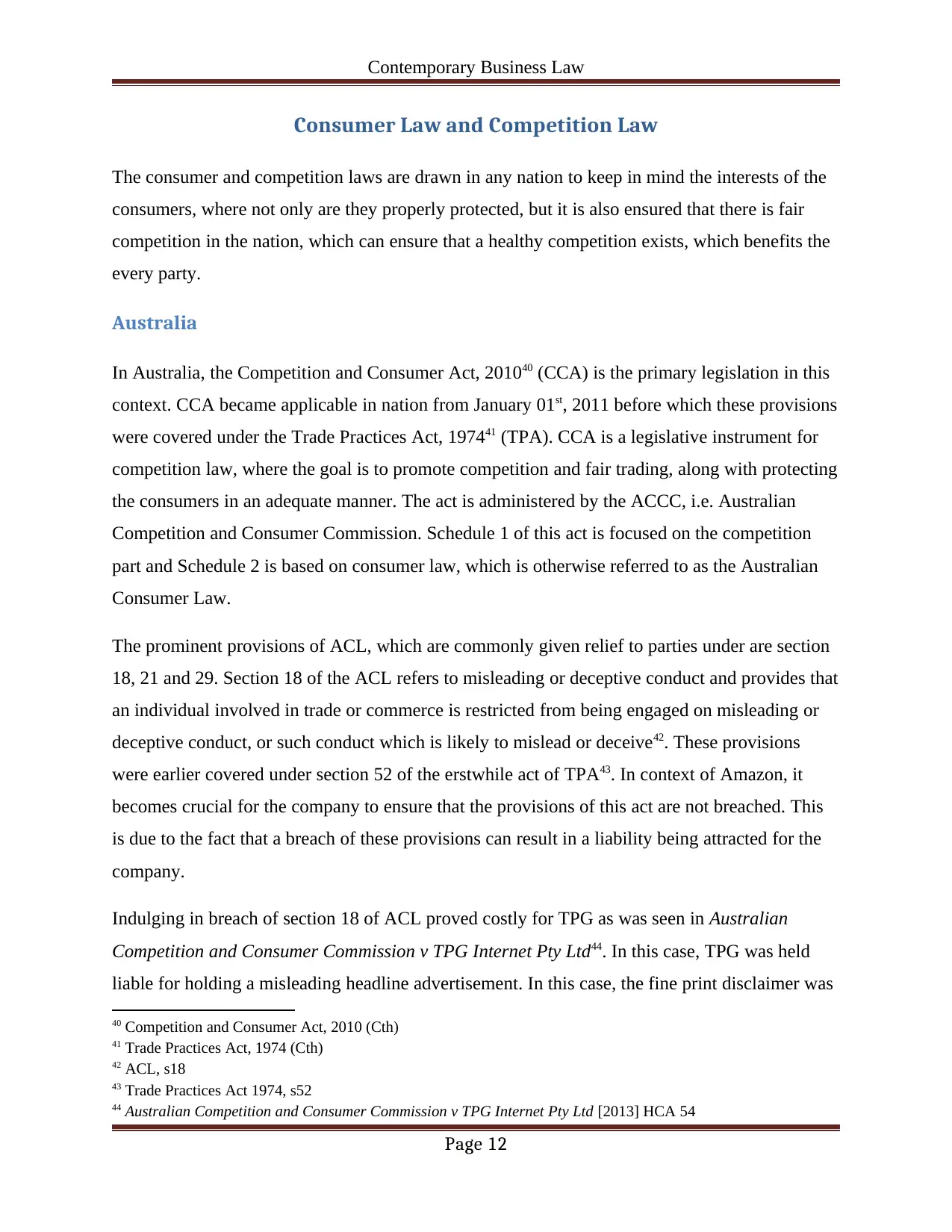
Contemporary Business Law
Consumer Law and Competition Law
The consumer and competition laws are drawn in any nation to keep in mind the interests of the
consumers, where not only are they properly protected, but it is also ensured that there is fair
competition in the nation, which can ensure that a healthy competition exists, which benefits the
every party.
Australia
In Australia, the Competition and Consumer Act, 201040 (CCA) is the primary legislation in this
context. CCA became applicable in nation from January 01st, 2011 before which these provisions
were covered under the Trade Practices Act, 197441 (TPA). CCA is a legislative instrument for
competition law, where the goal is to promote competition and fair trading, along with protecting
the consumers in an adequate manner. The act is administered by the ACCC, i.e. Australian
Competition and Consumer Commission. Schedule 1 of this act is focused on the competition
part and Schedule 2 is based on consumer law, which is otherwise referred to as the Australian
Consumer Law.
The prominent provisions of ACL, which are commonly given relief to parties under are section
18, 21 and 29. Section 18 of the ACL refers to misleading or deceptive conduct and provides that
an individual involved in trade or commerce is restricted from being engaged on misleading or
deceptive conduct, or such conduct which is likely to mislead or deceive42. These provisions
were earlier covered under section 52 of the erstwhile act of TPA43. In context of Amazon, it
becomes crucial for the company to ensure that the provisions of this act are not breached. This
is due to the fact that a breach of these provisions can result in a liability being attracted for the
company.
Indulging in breach of section 18 of ACL proved costly for TPG as was seen in Australian
Competition and Consumer Commission v TPG Internet Pty Ltd44. In this case, TPG was held
liable for holding a misleading headline advertisement. In this case, the fine print disclaimer was
40 Competition and Consumer Act, 2010 (Cth)
41 Trade Practices Act, 1974 (Cth)
42 ACL, s18
43 Trade Practices Act 1974, s52
44 Australian Competition and Consumer Commission v TPG Internet Pty Ltd [2013] HCA 54
Page 12
Consumer Law and Competition Law
The consumer and competition laws are drawn in any nation to keep in mind the interests of the
consumers, where not only are they properly protected, but it is also ensured that there is fair
competition in the nation, which can ensure that a healthy competition exists, which benefits the
every party.
Australia
In Australia, the Competition and Consumer Act, 201040 (CCA) is the primary legislation in this
context. CCA became applicable in nation from January 01st, 2011 before which these provisions
were covered under the Trade Practices Act, 197441 (TPA). CCA is a legislative instrument for
competition law, where the goal is to promote competition and fair trading, along with protecting
the consumers in an adequate manner. The act is administered by the ACCC, i.e. Australian
Competition and Consumer Commission. Schedule 1 of this act is focused on the competition
part and Schedule 2 is based on consumer law, which is otherwise referred to as the Australian
Consumer Law.
The prominent provisions of ACL, which are commonly given relief to parties under are section
18, 21 and 29. Section 18 of the ACL refers to misleading or deceptive conduct and provides that
an individual involved in trade or commerce is restricted from being engaged on misleading or
deceptive conduct, or such conduct which is likely to mislead or deceive42. These provisions
were earlier covered under section 52 of the erstwhile act of TPA43. In context of Amazon, it
becomes crucial for the company to ensure that the provisions of this act are not breached. This
is due to the fact that a breach of these provisions can result in a liability being attracted for the
company.
Indulging in breach of section 18 of ACL proved costly for TPG as was seen in Australian
Competition and Consumer Commission v TPG Internet Pty Ltd44. In this case, TPG was held
liable for holding a misleading headline advertisement. In this case, the fine print disclaimer was
40 Competition and Consumer Act, 2010 (Cth)
41 Trade Practices Act, 1974 (Cth)
42 ACL, s18
43 Trade Practices Act 1974, s52
44 Australian Competition and Consumer Commission v TPG Internet Pty Ltd [2013] HCA 54
Page 12
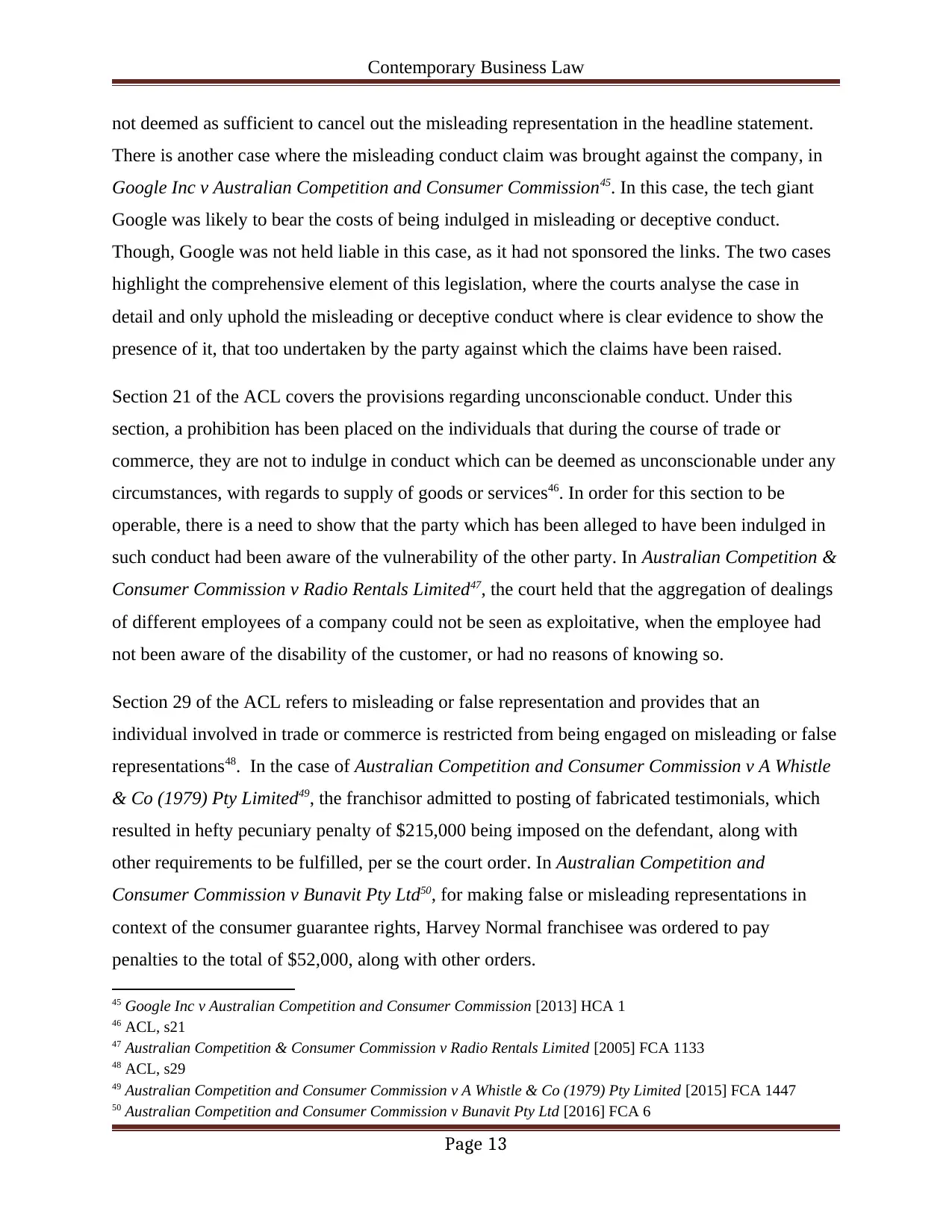
Contemporary Business Law
not deemed as sufficient to cancel out the misleading representation in the headline statement.
There is another case where the misleading conduct claim was brought against the company, in
Google Inc v Australian Competition and Consumer Commission45. In this case, the tech giant
Google was likely to bear the costs of being indulged in misleading or deceptive conduct.
Though, Google was not held liable in this case, as it had not sponsored the links. The two cases
highlight the comprehensive element of this legislation, where the courts analyse the case in
detail and only uphold the misleading or deceptive conduct where is clear evidence to show the
presence of it, that too undertaken by the party against which the claims have been raised.
Section 21 of the ACL covers the provisions regarding unconscionable conduct. Under this
section, a prohibition has been placed on the individuals that during the course of trade or
commerce, they are not to indulge in conduct which can be deemed as unconscionable under any
circumstances, with regards to supply of goods or services46. In order for this section to be
operable, there is a need to show that the party which has been alleged to have been indulged in
such conduct had been aware of the vulnerability of the other party. In Australian Competition &
Consumer Commission v Radio Rentals Limited47, the court held that the aggregation of dealings
of different employees of a company could not be seen as exploitative, when the employee had
not been aware of the disability of the customer, or had no reasons of knowing so.
Section 29 of the ACL refers to misleading or false representation and provides that an
individual involved in trade or commerce is restricted from being engaged on misleading or false
representations48. In the case of Australian Competition and Consumer Commission v A Whistle
& Co (1979) Pty Limited49, the franchisor admitted to posting of fabricated testimonials, which
resulted in hefty pecuniary penalty of $215,000 being imposed on the defendant, along with
other requirements to be fulfilled, per se the court order. In Australian Competition and
Consumer Commission v Bunavit Pty Ltd50, for making false or misleading representations in
context of the consumer guarantee rights, Harvey Normal franchisee was ordered to pay
penalties to the total of $52,000, along with other orders.
45 Google Inc v Australian Competition and Consumer Commission [2013] HCA 1
46 ACL, s21
47 Australian Competition & Consumer Commission v Radio Rentals Limited [2005] FCA 1133
48 ACL, s29
49 Australian Competition and Consumer Commission v A Whistle & Co (1979) Pty Limited [2015] FCA 1447
50 Australian Competition and Consumer Commission v Bunavit Pty Ltd [2016] FCA 6
Page 13
not deemed as sufficient to cancel out the misleading representation in the headline statement.
There is another case where the misleading conduct claim was brought against the company, in
Google Inc v Australian Competition and Consumer Commission45. In this case, the tech giant
Google was likely to bear the costs of being indulged in misleading or deceptive conduct.
Though, Google was not held liable in this case, as it had not sponsored the links. The two cases
highlight the comprehensive element of this legislation, where the courts analyse the case in
detail and only uphold the misleading or deceptive conduct where is clear evidence to show the
presence of it, that too undertaken by the party against which the claims have been raised.
Section 21 of the ACL covers the provisions regarding unconscionable conduct. Under this
section, a prohibition has been placed on the individuals that during the course of trade or
commerce, they are not to indulge in conduct which can be deemed as unconscionable under any
circumstances, with regards to supply of goods or services46. In order for this section to be
operable, there is a need to show that the party which has been alleged to have been indulged in
such conduct had been aware of the vulnerability of the other party. In Australian Competition &
Consumer Commission v Radio Rentals Limited47, the court held that the aggregation of dealings
of different employees of a company could not be seen as exploitative, when the employee had
not been aware of the disability of the customer, or had no reasons of knowing so.
Section 29 of the ACL refers to misleading or false representation and provides that an
individual involved in trade or commerce is restricted from being engaged on misleading or false
representations48. In the case of Australian Competition and Consumer Commission v A Whistle
& Co (1979) Pty Limited49, the franchisor admitted to posting of fabricated testimonials, which
resulted in hefty pecuniary penalty of $215,000 being imposed on the defendant, along with
other requirements to be fulfilled, per se the court order. In Australian Competition and
Consumer Commission v Bunavit Pty Ltd50, for making false or misleading representations in
context of the consumer guarantee rights, Harvey Normal franchisee was ordered to pay
penalties to the total of $52,000, along with other orders.
45 Google Inc v Australian Competition and Consumer Commission [2013] HCA 1
46 ACL, s21
47 Australian Competition & Consumer Commission v Radio Rentals Limited [2005] FCA 1133
48 ACL, s29
49 Australian Competition and Consumer Commission v A Whistle & Co (1979) Pty Limited [2015] FCA 1447
50 Australian Competition and Consumer Commission v Bunavit Pty Ltd [2016] FCA 6
Page 13
Paraphrase This Document
Need a fresh take? Get an instant paraphrase of this document with our AI Paraphraser
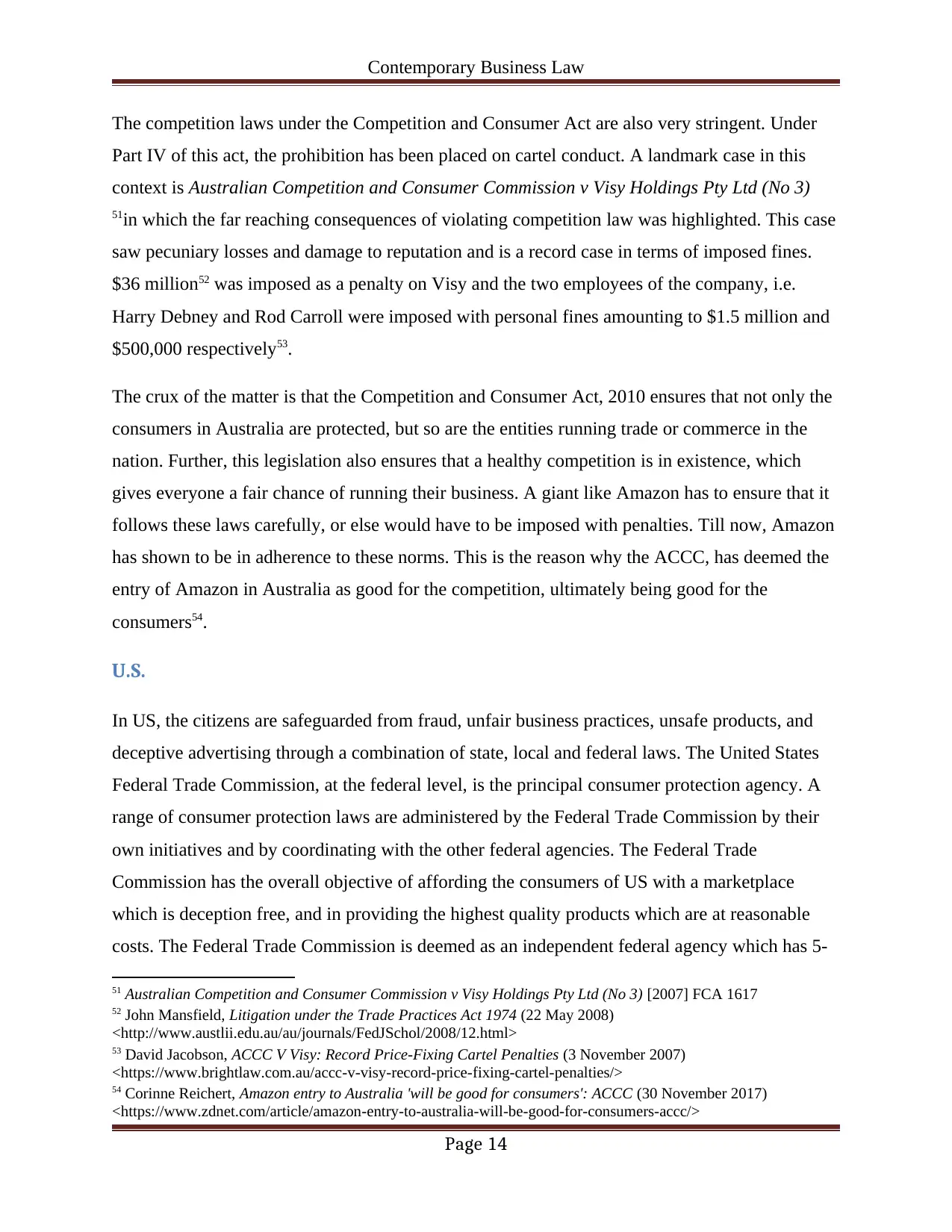
Contemporary Business Law
The competition laws under the Competition and Consumer Act are also very stringent. Under
Part IV of this act, the prohibition has been placed on cartel conduct. A landmark case in this
context is Australian Competition and Consumer Commission v Visy Holdings Pty Ltd (No 3)
51in which the far reaching consequences of violating competition law was highlighted. This case
saw pecuniary losses and damage to reputation and is a record case in terms of imposed fines.
$36 million52 was imposed as a penalty on Visy and the two employees of the company, i.e.
Harry Debney and Rod Carroll were imposed with personal fines amounting to $1.5 million and
$500,000 respectively53.
The crux of the matter is that the Competition and Consumer Act, 2010 ensures that not only the
consumers in Australia are protected, but so are the entities running trade or commerce in the
nation. Further, this legislation also ensures that a healthy competition is in existence, which
gives everyone a fair chance of running their business. A giant like Amazon has to ensure that it
follows these laws carefully, or else would have to be imposed with penalties. Till now, Amazon
has shown to be in adherence to these norms. This is the reason why the ACCC, has deemed the
entry of Amazon in Australia as good for the competition, ultimately being good for the
consumers54.
U.S.
In US, the citizens are safeguarded from fraud, unfair business practices, unsafe products, and
deceptive advertising through a combination of state, local and federal laws. The United States
Federal Trade Commission, at the federal level, is the principal consumer protection agency. A
range of consumer protection laws are administered by the Federal Trade Commission by their
own initiatives and by coordinating with the other federal agencies. The Federal Trade
Commission has the overall objective of affording the consumers of US with a marketplace
which is deception free, and in providing the highest quality products which are at reasonable
costs. The Federal Trade Commission is deemed as an independent federal agency which has 5-
51 Australian Competition and Consumer Commission v Visy Holdings Pty Ltd (No 3) [2007] FCA 1617
52 John Mansfield, Litigation under the Trade Practices Act 1974 (22 May 2008)
<http://www.austlii.edu.au/au/journals/FedJSchol/2008/12.html>
53 David Jacobson, ACCC V Visy: Record Price-Fixing Cartel Penalties (3 November 2007)
<https://www.brightlaw.com.au/accc-v-visy-record-price-fixing-cartel-penalties/>
54 Corinne Reichert, Amazon entry to Australia 'will be good for consumers': ACCC (30 November 2017)
<https://www.zdnet.com/article/amazon-entry-to-australia-will-be-good-for-consumers-accc/>
Page 14
The competition laws under the Competition and Consumer Act are also very stringent. Under
Part IV of this act, the prohibition has been placed on cartel conduct. A landmark case in this
context is Australian Competition and Consumer Commission v Visy Holdings Pty Ltd (No 3)
51in which the far reaching consequences of violating competition law was highlighted. This case
saw pecuniary losses and damage to reputation and is a record case in terms of imposed fines.
$36 million52 was imposed as a penalty on Visy and the two employees of the company, i.e.
Harry Debney and Rod Carroll were imposed with personal fines amounting to $1.5 million and
$500,000 respectively53.
The crux of the matter is that the Competition and Consumer Act, 2010 ensures that not only the
consumers in Australia are protected, but so are the entities running trade or commerce in the
nation. Further, this legislation also ensures that a healthy competition is in existence, which
gives everyone a fair chance of running their business. A giant like Amazon has to ensure that it
follows these laws carefully, or else would have to be imposed with penalties. Till now, Amazon
has shown to be in adherence to these norms. This is the reason why the ACCC, has deemed the
entry of Amazon in Australia as good for the competition, ultimately being good for the
consumers54.
U.S.
In US, the citizens are safeguarded from fraud, unfair business practices, unsafe products, and
deceptive advertising through a combination of state, local and federal laws. The United States
Federal Trade Commission, at the federal level, is the principal consumer protection agency. A
range of consumer protection laws are administered by the Federal Trade Commission by their
own initiatives and by coordinating with the other federal agencies. The Federal Trade
Commission has the overall objective of affording the consumers of US with a marketplace
which is deception free, and in providing the highest quality products which are at reasonable
costs. The Federal Trade Commission is deemed as an independent federal agency which has 5-
51 Australian Competition and Consumer Commission v Visy Holdings Pty Ltd (No 3) [2007] FCA 1617
52 John Mansfield, Litigation under the Trade Practices Act 1974 (22 May 2008)
<http://www.austlii.edu.au/au/journals/FedJSchol/2008/12.html>
53 David Jacobson, ACCC V Visy: Record Price-Fixing Cartel Penalties (3 November 2007)
<https://www.brightlaw.com.au/accc-v-visy-record-price-fixing-cartel-penalties/>
54 Corinne Reichert, Amazon entry to Australia 'will be good for consumers': ACCC (30 November 2017)
<https://www.zdnet.com/article/amazon-entry-to-australia-will-be-good-for-consumers-accc/>
Page 14
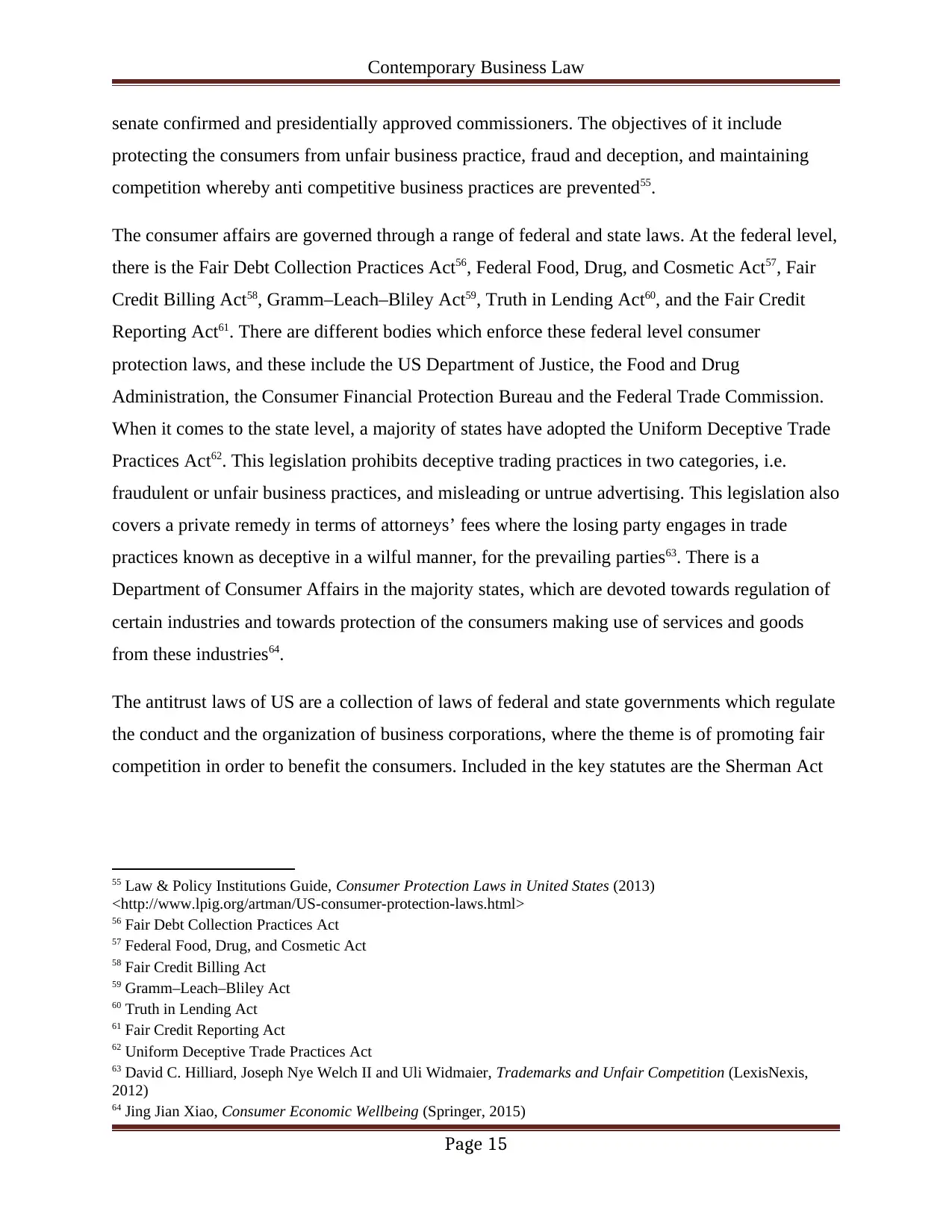
Contemporary Business Law
senate confirmed and presidentially approved commissioners. The objectives of it include
protecting the consumers from unfair business practice, fraud and deception, and maintaining
competition whereby anti competitive business practices are prevented55.
The consumer affairs are governed through a range of federal and state laws. At the federal level,
there is the Fair Debt Collection Practices Act56, Federal Food, Drug, and Cosmetic Act57, Fair
Credit Billing Act58, Gramm–Leach–Bliley Act59, Truth in Lending Act60, and the Fair Credit
Reporting Act61. There are different bodies which enforce these federal level consumer
protection laws, and these include the US Department of Justice, the Food and Drug
Administration, the Consumer Financial Protection Bureau and the Federal Trade Commission.
When it comes to the state level, a majority of states have adopted the Uniform Deceptive Trade
Practices Act62. This legislation prohibits deceptive trading practices in two categories, i.e.
fraudulent or unfair business practices, and misleading or untrue advertising. This legislation also
covers a private remedy in terms of attorneys’ fees where the losing party engages in trade
practices known as deceptive in a wilful manner, for the prevailing parties63. There is a
Department of Consumer Affairs in the majority states, which are devoted towards regulation of
certain industries and towards protection of the consumers making use of services and goods
from these industries64.
The antitrust laws of US are a collection of laws of federal and state governments which regulate
the conduct and the organization of business corporations, where the theme is of promoting fair
competition in order to benefit the consumers. Included in the key statutes are the Sherman Act
55 Law & Policy Institutions Guide, Consumer Protection Laws in United States (2013)
<http://www.lpig.org/artman/US-consumer-protection-laws.html>
56 Fair Debt Collection Practices Act
57 Federal Food, Drug, and Cosmetic Act
58 Fair Credit Billing Act
59 Gramm–Leach–Bliley Act
60 Truth in Lending Act
61 Fair Credit Reporting Act
62 Uniform Deceptive Trade Practices Act
63 David C. Hilliard, Joseph Nye Welch II and Uli Widmaier, Trademarks and Unfair Competition (LexisNexis,
2012)
64 Jing Jian Xiao, Consumer Economic Wellbeing (Springer, 2015)
Page 15
senate confirmed and presidentially approved commissioners. The objectives of it include
protecting the consumers from unfair business practice, fraud and deception, and maintaining
competition whereby anti competitive business practices are prevented55.
The consumer affairs are governed through a range of federal and state laws. At the federal level,
there is the Fair Debt Collection Practices Act56, Federal Food, Drug, and Cosmetic Act57, Fair
Credit Billing Act58, Gramm–Leach–Bliley Act59, Truth in Lending Act60, and the Fair Credit
Reporting Act61. There are different bodies which enforce these federal level consumer
protection laws, and these include the US Department of Justice, the Food and Drug
Administration, the Consumer Financial Protection Bureau and the Federal Trade Commission.
When it comes to the state level, a majority of states have adopted the Uniform Deceptive Trade
Practices Act62. This legislation prohibits deceptive trading practices in two categories, i.e.
fraudulent or unfair business practices, and misleading or untrue advertising. This legislation also
covers a private remedy in terms of attorneys’ fees where the losing party engages in trade
practices known as deceptive in a wilful manner, for the prevailing parties63. There is a
Department of Consumer Affairs in the majority states, which are devoted towards regulation of
certain industries and towards protection of the consumers making use of services and goods
from these industries64.
The antitrust laws of US are a collection of laws of federal and state governments which regulate
the conduct and the organization of business corporations, where the theme is of promoting fair
competition in order to benefit the consumers. Included in the key statutes are the Sherman Act
55 Law & Policy Institutions Guide, Consumer Protection Laws in United States (2013)
<http://www.lpig.org/artman/US-consumer-protection-laws.html>
56 Fair Debt Collection Practices Act
57 Federal Food, Drug, and Cosmetic Act
58 Fair Credit Billing Act
59 Gramm–Leach–Bliley Act
60 Truth in Lending Act
61 Fair Credit Reporting Act
62 Uniform Deceptive Trade Practices Act
63 David C. Hilliard, Joseph Nye Welch II and Uli Widmaier, Trademarks and Unfair Competition (LexisNexis,
2012)
64 Jing Jian Xiao, Consumer Economic Wellbeing (Springer, 2015)
Page 15
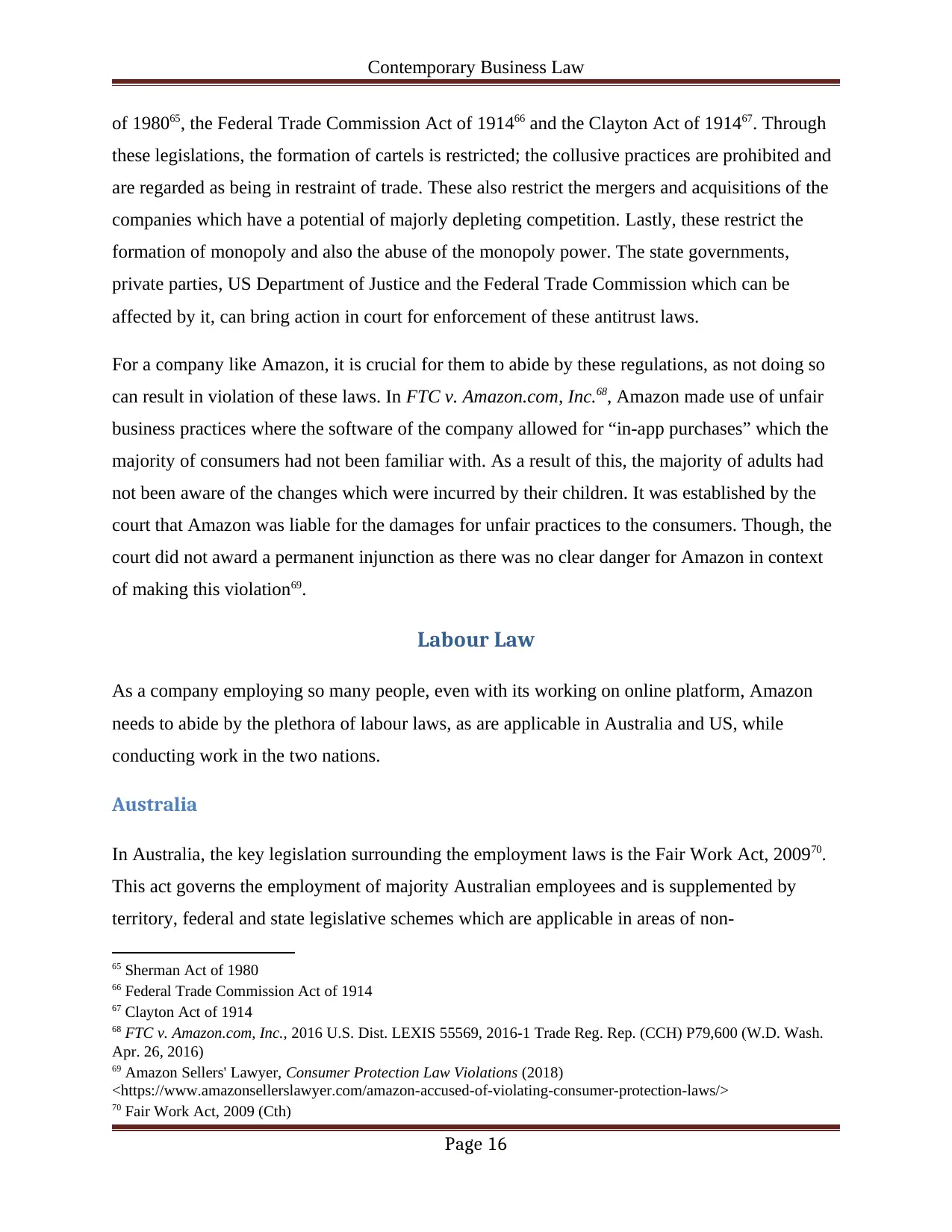
Contemporary Business Law
of 198065, the Federal Trade Commission Act of 191466 and the Clayton Act of 191467. Through
these legislations, the formation of cartels is restricted; the collusive practices are prohibited and
are regarded as being in restraint of trade. These also restrict the mergers and acquisitions of the
companies which have a potential of majorly depleting competition. Lastly, these restrict the
formation of monopoly and also the abuse of the monopoly power. The state governments,
private parties, US Department of Justice and the Federal Trade Commission which can be
affected by it, can bring action in court for enforcement of these antitrust laws.
For a company like Amazon, it is crucial for them to abide by these regulations, as not doing so
can result in violation of these laws. In FTC v. Amazon.com, Inc.68, Amazon made use of unfair
business practices where the software of the company allowed for “in-app purchases” which the
majority of consumers had not been familiar with. As a result of this, the majority of adults had
not been aware of the changes which were incurred by their children. It was established by the
court that Amazon was liable for the damages for unfair practices to the consumers. Though, the
court did not award a permanent injunction as there was no clear danger for Amazon in context
of making this violation69.
Labour Law
As a company employing so many people, even with its working on online platform, Amazon
needs to abide by the plethora of labour laws, as are applicable in Australia and US, while
conducting work in the two nations.
Australia
In Australia, the key legislation surrounding the employment laws is the Fair Work Act, 200970.
This act governs the employment of majority Australian employees and is supplemented by
territory, federal and state legislative schemes which are applicable in areas of non-
65 Sherman Act of 1980
66 Federal Trade Commission Act of 1914
67 Clayton Act of 1914
68 FTC v. Amazon.com, Inc., 2016 U.S. Dist. LEXIS 55569, 2016-1 Trade Reg. Rep. (CCH) P79,600 (W.D. Wash.
Apr. 26, 2016)
69 Amazon Sellers' Lawyer, Consumer Protection Law Violations (2018)
<https://www.amazonsellerslawyer.com/amazon-accused-of-violating-consumer-protection-laws/>
70 Fair Work Act, 2009 (Cth)
Page 16
of 198065, the Federal Trade Commission Act of 191466 and the Clayton Act of 191467. Through
these legislations, the formation of cartels is restricted; the collusive practices are prohibited and
are regarded as being in restraint of trade. These also restrict the mergers and acquisitions of the
companies which have a potential of majorly depleting competition. Lastly, these restrict the
formation of monopoly and also the abuse of the monopoly power. The state governments,
private parties, US Department of Justice and the Federal Trade Commission which can be
affected by it, can bring action in court for enforcement of these antitrust laws.
For a company like Amazon, it is crucial for them to abide by these regulations, as not doing so
can result in violation of these laws. In FTC v. Amazon.com, Inc.68, Amazon made use of unfair
business practices where the software of the company allowed for “in-app purchases” which the
majority of consumers had not been familiar with. As a result of this, the majority of adults had
not been aware of the changes which were incurred by their children. It was established by the
court that Amazon was liable for the damages for unfair practices to the consumers. Though, the
court did not award a permanent injunction as there was no clear danger for Amazon in context
of making this violation69.
Labour Law
As a company employing so many people, even with its working on online platform, Amazon
needs to abide by the plethora of labour laws, as are applicable in Australia and US, while
conducting work in the two nations.
Australia
In Australia, the key legislation surrounding the employment laws is the Fair Work Act, 200970.
This act governs the employment of majority Australian employees and is supplemented by
territory, federal and state legislative schemes which are applicable in areas of non-
65 Sherman Act of 1980
66 Federal Trade Commission Act of 1914
67 Clayton Act of 1914
68 FTC v. Amazon.com, Inc., 2016 U.S. Dist. LEXIS 55569, 2016-1 Trade Reg. Rep. (CCH) P79,600 (W.D. Wash.
Apr. 26, 2016)
69 Amazon Sellers' Lawyer, Consumer Protection Law Violations (2018)
<https://www.amazonsellerslawyer.com/amazon-accused-of-violating-consumer-protection-laws/>
70 Fair Work Act, 2009 (Cth)
Page 16
Secure Best Marks with AI Grader
Need help grading? Try our AI Grader for instant feedback on your assignments.

Contemporary Business Law
discrimination and healthy and safety. There is also the Workplace Health and Safety Act,
201171, which specifically works towards ensuring, that there is safety at workplace and that the
health of the people at workplace is not put in danger. There are also the National Employment
Standards, which provide the ten areas where minimum standards of employment have to be
followed72. For attracting talent and for retaining talent, it is important for Amazon to follow all
these laws when it employs people in Australia.
U.S.
The employment laws in US are governed by a mix of state, local and state laws and these vary
based on the jurisdiction. The chief or the primary source of federal employment law includes
Civil Rights Act of 186673, Age Discrimination in Employment Act74, Fair Labor Standards
Act75, Americans with Disabilities Act76, Title II of the Genetic Information Nondiscrimination
Act77, Occupational Safety and Health Administration Act78, Uniformed Services Employment
and Reemployment Rights Act79, National Labor Relations Act80, Worker Adjustment and
Retraining Notification Act81, Title VII of the Civil Rights Act of 196482. The employers have
been prohibited from retaliating against their employees while they exercise rights in these laws.
The whistleblowers are also protected in the nation whereby they can raise complaints where the
laws are violated83.
Amazon has had its fair share of allegations regarding being in contravention of the labour laws.
In 2016, Amazon had been sued by three people who had worked as drivers of the company,
where they claimed that they were employees, instead of being contractors, and that they had
71 Workplace Health and Safety Act, 2011 (Cth)
72 ICLG, Employment & Labour Law 2017|Australia (24 March 2017) <https://iclg.com/practice-areas/employment-
and-labour-law/employment-and-labour-law-2017/australia>
73 Civil Rights Act of 1866
74 Age Discrimination in Employment Act
75 Fair Labor Standards Act
76 Americans with Disabilities Act
77 Title II of the Genetic Information Nondiscrimination Act
78 Occupational Safety and Health Administration Act
79 Uniformed Services Employment and Reemployment Rights Act
80 National Labor Relations Act
81 Worker Adjustment and Retraining Notification Act
82 Title VII of the Civil Rights Act of 1964
83 ICLG, Employment & Labour Law 2017|USA (24 March 2017) <https://iclg.com/practice-areas/employment-and-
labour-law/employment-and-labour-law-2017/usa>
Page 17
discrimination and healthy and safety. There is also the Workplace Health and Safety Act,
201171, which specifically works towards ensuring, that there is safety at workplace and that the
health of the people at workplace is not put in danger. There are also the National Employment
Standards, which provide the ten areas where minimum standards of employment have to be
followed72. For attracting talent and for retaining talent, it is important for Amazon to follow all
these laws when it employs people in Australia.
U.S.
The employment laws in US are governed by a mix of state, local and state laws and these vary
based on the jurisdiction. The chief or the primary source of federal employment law includes
Civil Rights Act of 186673, Age Discrimination in Employment Act74, Fair Labor Standards
Act75, Americans with Disabilities Act76, Title II of the Genetic Information Nondiscrimination
Act77, Occupational Safety and Health Administration Act78, Uniformed Services Employment
and Reemployment Rights Act79, National Labor Relations Act80, Worker Adjustment and
Retraining Notification Act81, Title VII of the Civil Rights Act of 196482. The employers have
been prohibited from retaliating against their employees while they exercise rights in these laws.
The whistleblowers are also protected in the nation whereby they can raise complaints where the
laws are violated83.
Amazon has had its fair share of allegations regarding being in contravention of the labour laws.
In 2016, Amazon had been sued by three people who had worked as drivers of the company,
where they claimed that they were employees, instead of being contractors, and that they had
71 Workplace Health and Safety Act, 2011 (Cth)
72 ICLG, Employment & Labour Law 2017|Australia (24 March 2017) <https://iclg.com/practice-areas/employment-
and-labour-law/employment-and-labour-law-2017/australia>
73 Civil Rights Act of 1866
74 Age Discrimination in Employment Act
75 Fair Labor Standards Act
76 Americans with Disabilities Act
77 Title II of the Genetic Information Nondiscrimination Act
78 Occupational Safety and Health Administration Act
79 Uniformed Services Employment and Reemployment Rights Act
80 National Labor Relations Act
81 Worker Adjustment and Retraining Notification Act
82 Title VII of the Civil Rights Act of 1964
83 ICLG, Employment & Labour Law 2017|USA (24 March 2017) <https://iclg.com/practice-areas/employment-and-
labour-law/employment-and-labour-law-2017/usa>
Page 17
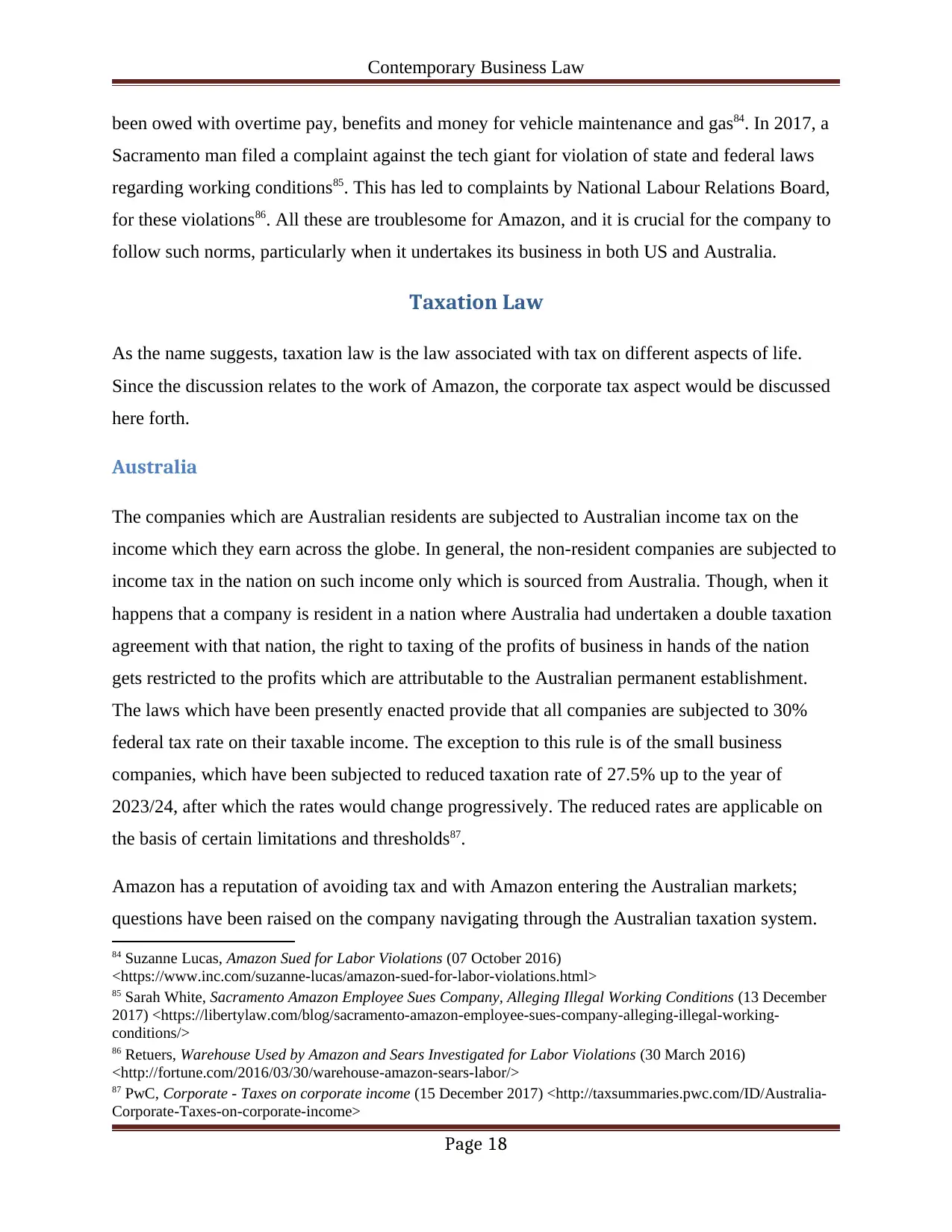
Contemporary Business Law
been owed with overtime pay, benefits and money for vehicle maintenance and gas84. In 2017, a
Sacramento man filed a complaint against the tech giant for violation of state and federal laws
regarding working conditions85. This has led to complaints by National Labour Relations Board,
for these violations86. All these are troublesome for Amazon, and it is crucial for the company to
follow such norms, particularly when it undertakes its business in both US and Australia.
Taxation Law
As the name suggests, taxation law is the law associated with tax on different aspects of life.
Since the discussion relates to the work of Amazon, the corporate tax aspect would be discussed
here forth.
Australia
The companies which are Australian residents are subjected to Australian income tax on the
income which they earn across the globe. In general, the non-resident companies are subjected to
income tax in the nation on such income only which is sourced from Australia. Though, when it
happens that a company is resident in a nation where Australia had undertaken a double taxation
agreement with that nation, the right to taxing of the profits of business in hands of the nation
gets restricted to the profits which are attributable to the Australian permanent establishment.
The laws which have been presently enacted provide that all companies are subjected to 30%
federal tax rate on their taxable income. The exception to this rule is of the small business
companies, which have been subjected to reduced taxation rate of 27.5% up to the year of
2023/24, after which the rates would change progressively. The reduced rates are applicable on
the basis of certain limitations and thresholds87.
Amazon has a reputation of avoiding tax and with Amazon entering the Australian markets;
questions have been raised on the company navigating through the Australian taxation system.
84 Suzanne Lucas, Amazon Sued for Labor Violations (07 October 2016)
<https://www.inc.com/suzanne-lucas/amazon-sued-for-labor-violations.html>
85 Sarah White, Sacramento Amazon Employee Sues Company, Alleging Illegal Working Conditions (13 December
2017) <https://libertylaw.com/blog/sacramento-amazon-employee-sues-company-alleging-illegal-working-
conditions/>
86 Retuers, Warehouse Used by Amazon and Sears Investigated for Labor Violations (30 March 2016)
<http://fortune.com/2016/03/30/warehouse-amazon-sears-labor/>
87 PwC, Corporate - Taxes on corporate income (15 December 2017) <http://taxsummaries.pwc.com/ID/Australia-
Corporate-Taxes-on-corporate-income>
Page 18
been owed with overtime pay, benefits and money for vehicle maintenance and gas84. In 2017, a
Sacramento man filed a complaint against the tech giant for violation of state and federal laws
regarding working conditions85. This has led to complaints by National Labour Relations Board,
for these violations86. All these are troublesome for Amazon, and it is crucial for the company to
follow such norms, particularly when it undertakes its business in both US and Australia.
Taxation Law
As the name suggests, taxation law is the law associated with tax on different aspects of life.
Since the discussion relates to the work of Amazon, the corporate tax aspect would be discussed
here forth.
Australia
The companies which are Australian residents are subjected to Australian income tax on the
income which they earn across the globe. In general, the non-resident companies are subjected to
income tax in the nation on such income only which is sourced from Australia. Though, when it
happens that a company is resident in a nation where Australia had undertaken a double taxation
agreement with that nation, the right to taxing of the profits of business in hands of the nation
gets restricted to the profits which are attributable to the Australian permanent establishment.
The laws which have been presently enacted provide that all companies are subjected to 30%
federal tax rate on their taxable income. The exception to this rule is of the small business
companies, which have been subjected to reduced taxation rate of 27.5% up to the year of
2023/24, after which the rates would change progressively. The reduced rates are applicable on
the basis of certain limitations and thresholds87.
Amazon has a reputation of avoiding tax and with Amazon entering the Australian markets;
questions have been raised on the company navigating through the Australian taxation system.
84 Suzanne Lucas, Amazon Sued for Labor Violations (07 October 2016)
<https://www.inc.com/suzanne-lucas/amazon-sued-for-labor-violations.html>
85 Sarah White, Sacramento Amazon Employee Sues Company, Alleging Illegal Working Conditions (13 December
2017) <https://libertylaw.com/blog/sacramento-amazon-employee-sues-company-alleging-illegal-working-
conditions/>
86 Retuers, Warehouse Used by Amazon and Sears Investigated for Labor Violations (30 March 2016)
<http://fortune.com/2016/03/30/warehouse-amazon-sears-labor/>
87 PwC, Corporate - Taxes on corporate income (15 December 2017) <http://taxsummaries.pwc.com/ID/Australia-
Corporate-Taxes-on-corporate-income>
Page 18
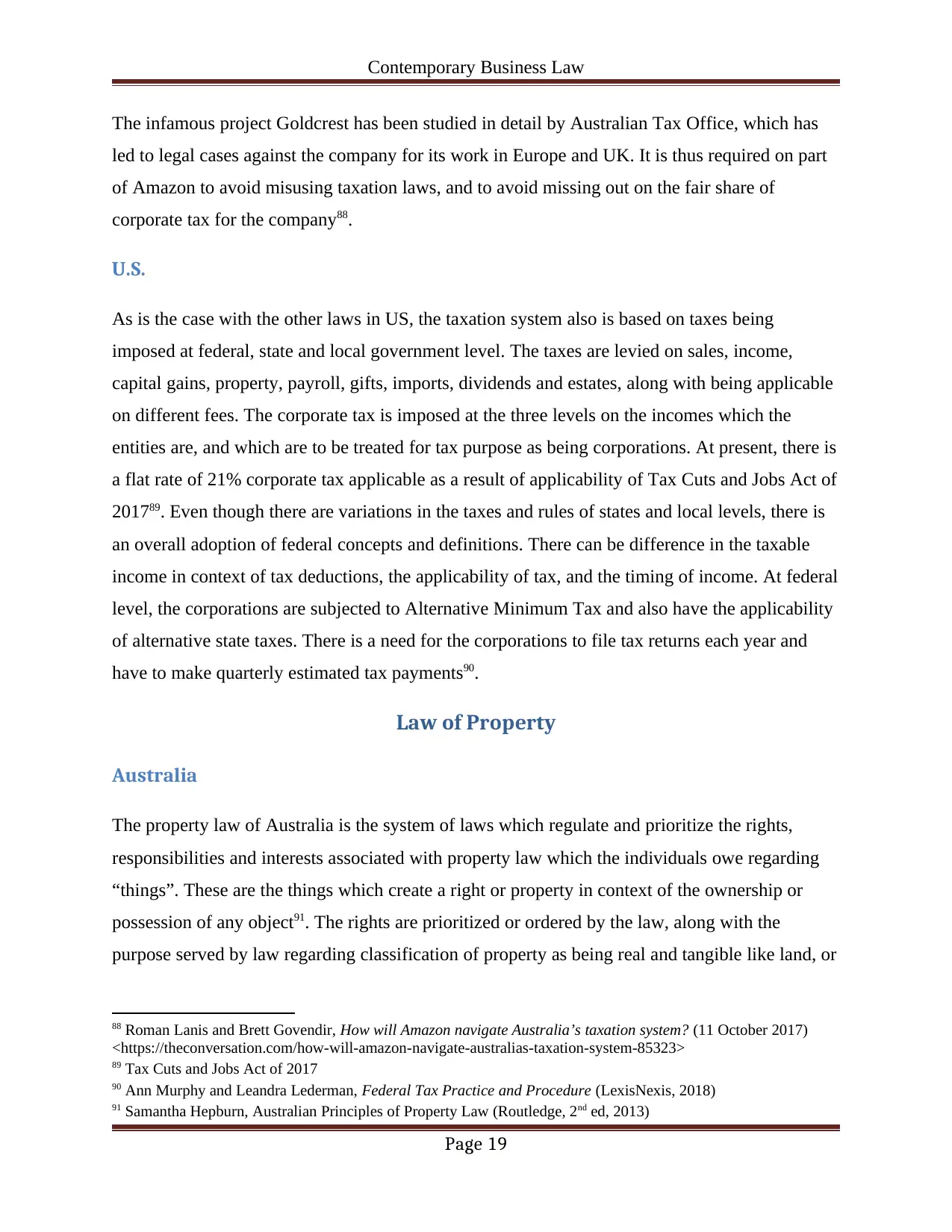
Contemporary Business Law
The infamous project Goldcrest has been studied in detail by Australian Tax Office, which has
led to legal cases against the company for its work in Europe and UK. It is thus required on part
of Amazon to avoid misusing taxation laws, and to avoid missing out on the fair share of
corporate tax for the company88.
U.S.
As is the case with the other laws in US, the taxation system also is based on taxes being
imposed at federal, state and local government level. The taxes are levied on sales, income,
capital gains, property, payroll, gifts, imports, dividends and estates, along with being applicable
on different fees. The corporate tax is imposed at the three levels on the incomes which the
entities are, and which are to be treated for tax purpose as being corporations. At present, there is
a flat rate of 21% corporate tax applicable as a result of applicability of Tax Cuts and Jobs Act of
201789. Even though there are variations in the taxes and rules of states and local levels, there is
an overall adoption of federal concepts and definitions. There can be difference in the taxable
income in context of tax deductions, the applicability of tax, and the timing of income. At federal
level, the corporations are subjected to Alternative Minimum Tax and also have the applicability
of alternative state taxes. There is a need for the corporations to file tax returns each year and
have to make quarterly estimated tax payments90.
Law of Property
Australia
The property law of Australia is the system of laws which regulate and prioritize the rights,
responsibilities and interests associated with property law which the individuals owe regarding
“things”. These are the things which create a right or property in context of the ownership or
possession of any object91. The rights are prioritized or ordered by the law, along with the
purpose served by law regarding classification of property as being real and tangible like land, or
88 Roman Lanis and Brett Govendir, How will Amazon navigate Australia’s taxation system? (11 October 2017)
<https://theconversation.com/how-will-amazon-navigate-australias-taxation-system-85323>
89 Tax Cuts and Jobs Act of 2017
90 Ann Murphy and Leandra Lederman, Federal Tax Practice and Procedure (LexisNexis, 2018)
91 Samantha Hepburn, Australian Principles of Property Law (Routledge, 2nd ed, 2013)
Page 19
The infamous project Goldcrest has been studied in detail by Australian Tax Office, which has
led to legal cases against the company for its work in Europe and UK. It is thus required on part
of Amazon to avoid misusing taxation laws, and to avoid missing out on the fair share of
corporate tax for the company88.
U.S.
As is the case with the other laws in US, the taxation system also is based on taxes being
imposed at federal, state and local government level. The taxes are levied on sales, income,
capital gains, property, payroll, gifts, imports, dividends and estates, along with being applicable
on different fees. The corporate tax is imposed at the three levels on the incomes which the
entities are, and which are to be treated for tax purpose as being corporations. At present, there is
a flat rate of 21% corporate tax applicable as a result of applicability of Tax Cuts and Jobs Act of
201789. Even though there are variations in the taxes and rules of states and local levels, there is
an overall adoption of federal concepts and definitions. There can be difference in the taxable
income in context of tax deductions, the applicability of tax, and the timing of income. At federal
level, the corporations are subjected to Alternative Minimum Tax and also have the applicability
of alternative state taxes. There is a need for the corporations to file tax returns each year and
have to make quarterly estimated tax payments90.
Law of Property
Australia
The property law of Australia is the system of laws which regulate and prioritize the rights,
responsibilities and interests associated with property law which the individuals owe regarding
“things”. These are the things which create a right or property in context of the ownership or
possession of any object91. The rights are prioritized or ordered by the law, along with the
purpose served by law regarding classification of property as being real and tangible like land, or
88 Roman Lanis and Brett Govendir, How will Amazon navigate Australia’s taxation system? (11 October 2017)
<https://theconversation.com/how-will-amazon-navigate-australias-taxation-system-85323>
89 Tax Cuts and Jobs Act of 2017
90 Ann Murphy and Leandra Lederman, Federal Tax Practice and Procedure (LexisNexis, 2018)
91 Samantha Hepburn, Australian Principles of Property Law (Routledge, 2nd ed, 2013)
Page 19
Paraphrase This Document
Need a fresh take? Get an instant paraphrase of this document with our AI Paraphraser
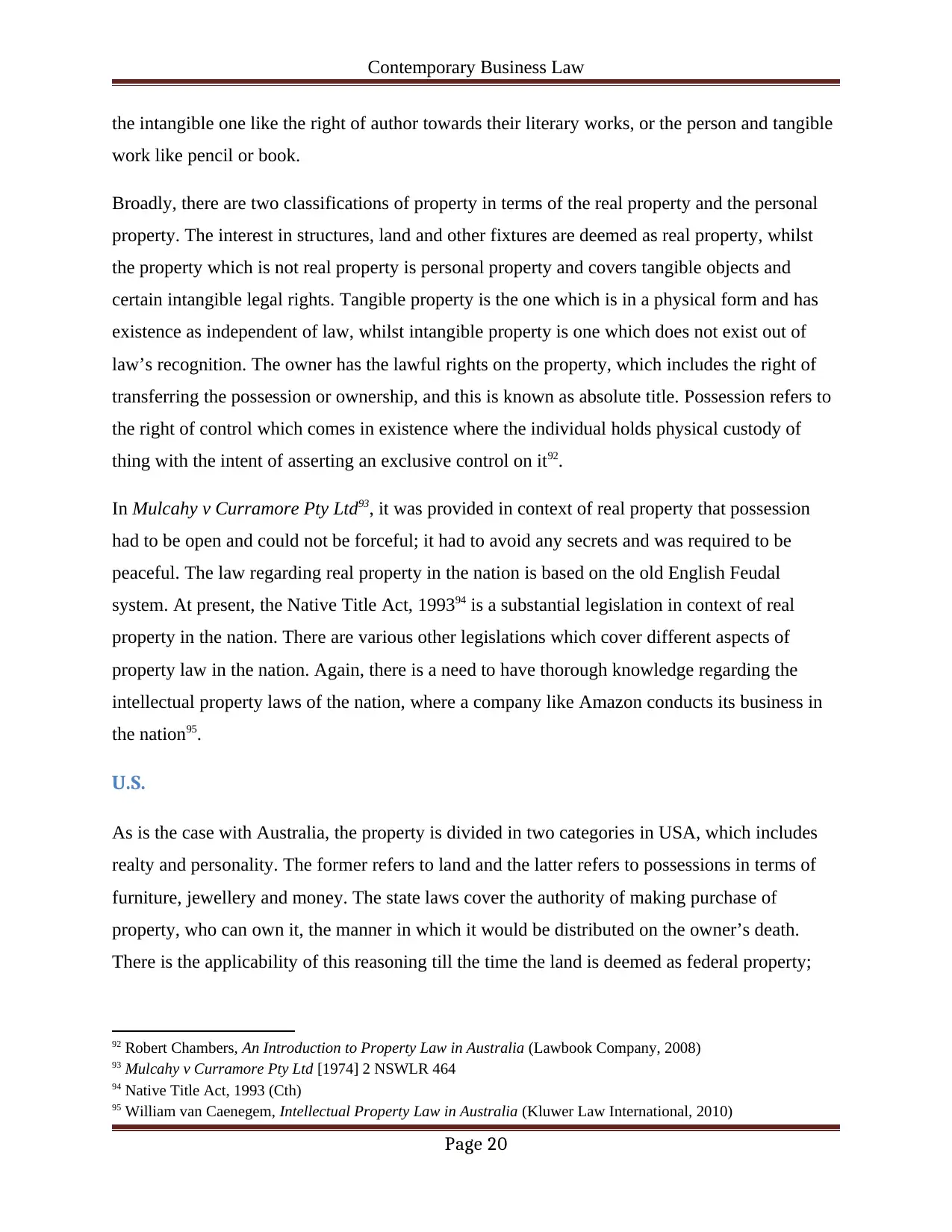
Contemporary Business Law
the intangible one like the right of author towards their literary works, or the person and tangible
work like pencil or book.
Broadly, there are two classifications of property in terms of the real property and the personal
property. The interest in structures, land and other fixtures are deemed as real property, whilst
the property which is not real property is personal property and covers tangible objects and
certain intangible legal rights. Tangible property is the one which is in a physical form and has
existence as independent of law, whilst intangible property is one which does not exist out of
law’s recognition. The owner has the lawful rights on the property, which includes the right of
transferring the possession or ownership, and this is known as absolute title. Possession refers to
the right of control which comes in existence where the individual holds physical custody of
thing with the intent of asserting an exclusive control on it92.
In Mulcahy v Curramore Pty Ltd93, it was provided in context of real property that possession
had to be open and could not be forceful; it had to avoid any secrets and was required to be
peaceful. The law regarding real property in the nation is based on the old English Feudal
system. At present, the Native Title Act, 199394 is a substantial legislation in context of real
property in the nation. There are various other legislations which cover different aspects of
property law in the nation. Again, there is a need to have thorough knowledge regarding the
intellectual property laws of the nation, where a company like Amazon conducts its business in
the nation95.
U.S.
As is the case with Australia, the property is divided in two categories in USA, which includes
realty and personality. The former refers to land and the latter refers to possessions in terms of
furniture, jewellery and money. The state laws cover the authority of making purchase of
property, who can own it, the manner in which it would be distributed on the owner’s death.
There is the applicability of this reasoning till the time the land is deemed as federal property;
92 Robert Chambers, An Introduction to Property Law in Australia (Lawbook Company, 2008)
93 Mulcahy v Curramore Pty Ltd [1974] 2 NSWLR 464
94 Native Title Act, 1993 (Cth)
95 William van Caenegem, Intellectual Property Law in Australia (Kluwer Law International, 2010)
Page 20
the intangible one like the right of author towards their literary works, or the person and tangible
work like pencil or book.
Broadly, there are two classifications of property in terms of the real property and the personal
property. The interest in structures, land and other fixtures are deemed as real property, whilst
the property which is not real property is personal property and covers tangible objects and
certain intangible legal rights. Tangible property is the one which is in a physical form and has
existence as independent of law, whilst intangible property is one which does not exist out of
law’s recognition. The owner has the lawful rights on the property, which includes the right of
transferring the possession or ownership, and this is known as absolute title. Possession refers to
the right of control which comes in existence where the individual holds physical custody of
thing with the intent of asserting an exclusive control on it92.
In Mulcahy v Curramore Pty Ltd93, it was provided in context of real property that possession
had to be open and could not be forceful; it had to avoid any secrets and was required to be
peaceful. The law regarding real property in the nation is based on the old English Feudal
system. At present, the Native Title Act, 199394 is a substantial legislation in context of real
property in the nation. There are various other legislations which cover different aspects of
property law in the nation. Again, there is a need to have thorough knowledge regarding the
intellectual property laws of the nation, where a company like Amazon conducts its business in
the nation95.
U.S.
As is the case with Australia, the property is divided in two categories in USA, which includes
realty and personality. The former refers to land and the latter refers to possessions in terms of
furniture, jewellery and money. The state laws cover the authority of making purchase of
property, who can own it, the manner in which it would be distributed on the owner’s death.
There is the applicability of this reasoning till the time the land is deemed as federal property;
92 Robert Chambers, An Introduction to Property Law in Australia (Lawbook Company, 2008)
93 Mulcahy v Curramore Pty Ltd [1974] 2 NSWLR 464
94 Native Title Act, 1993 (Cth)
95 William van Caenegem, Intellectual Property Law in Australia (Kluwer Law International, 2010)
Page 20
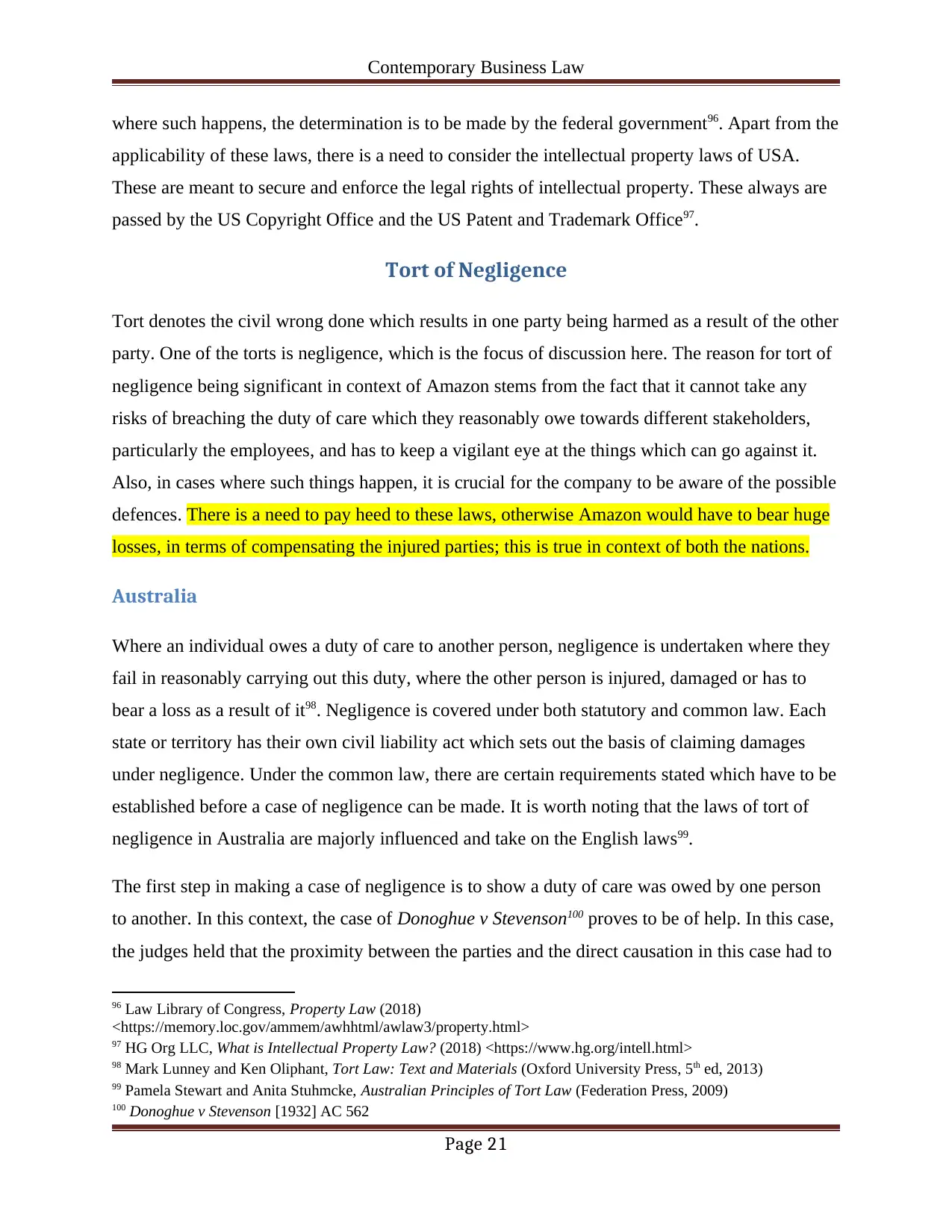
Contemporary Business Law
where such happens, the determination is to be made by the federal government96. Apart from the
applicability of these laws, there is a need to consider the intellectual property laws of USA.
These are meant to secure and enforce the legal rights of intellectual property. These always are
passed by the US Copyright Office and the US Patent and Trademark Office97.
Tort of Negligence
Tort denotes the civil wrong done which results in one party being harmed as a result of the other
party. One of the torts is negligence, which is the focus of discussion here. The reason for tort of
negligence being significant in context of Amazon stems from the fact that it cannot take any
risks of breaching the duty of care which they reasonably owe towards different stakeholders,
particularly the employees, and has to keep a vigilant eye at the things which can go against it.
Also, in cases where such things happen, it is crucial for the company to be aware of the possible
defences. There is a need to pay heed to these laws, otherwise Amazon would have to bear huge
losses, in terms of compensating the injured parties; this is true in context of both the nations.
Australia
Where an individual owes a duty of care to another person, negligence is undertaken where they
fail in reasonably carrying out this duty, where the other person is injured, damaged or has to
bear a loss as a result of it98. Negligence is covered under both statutory and common law. Each
state or territory has their own civil liability act which sets out the basis of claiming damages
under negligence. Under the common law, there are certain requirements stated which have to be
established before a case of negligence can be made. It is worth noting that the laws of tort of
negligence in Australia are majorly influenced and take on the English laws99.
The first step in making a case of negligence is to show a duty of care was owed by one person
to another. In this context, the case of Donoghue v Stevenson100 proves to be of help. In this case,
the judges held that the proximity between the parties and the direct causation in this case had to
96 Law Library of Congress, Property Law (2018)
<https://memory.loc.gov/ammem/awhhtml/awlaw3/property.html>
97 HG Org LLC, What is Intellectual Property Law? (2018) <https://www.hg.org/intell.html>
98 Mark Lunney and Ken Oliphant, Tort Law: Text and Materials (Oxford University Press, 5th ed, 2013)
99 Pamela Stewart and Anita Stuhmcke, Australian Principles of Tort Law (Federation Press, 2009)
100 Donoghue v Stevenson [1932] AC 562
Page 21
where such happens, the determination is to be made by the federal government96. Apart from the
applicability of these laws, there is a need to consider the intellectual property laws of USA.
These are meant to secure and enforce the legal rights of intellectual property. These always are
passed by the US Copyright Office and the US Patent and Trademark Office97.
Tort of Negligence
Tort denotes the civil wrong done which results in one party being harmed as a result of the other
party. One of the torts is negligence, which is the focus of discussion here. The reason for tort of
negligence being significant in context of Amazon stems from the fact that it cannot take any
risks of breaching the duty of care which they reasonably owe towards different stakeholders,
particularly the employees, and has to keep a vigilant eye at the things which can go against it.
Also, in cases where such things happen, it is crucial for the company to be aware of the possible
defences. There is a need to pay heed to these laws, otherwise Amazon would have to bear huge
losses, in terms of compensating the injured parties; this is true in context of both the nations.
Australia
Where an individual owes a duty of care to another person, negligence is undertaken where they
fail in reasonably carrying out this duty, where the other person is injured, damaged or has to
bear a loss as a result of it98. Negligence is covered under both statutory and common law. Each
state or territory has their own civil liability act which sets out the basis of claiming damages
under negligence. Under the common law, there are certain requirements stated which have to be
established before a case of negligence can be made. It is worth noting that the laws of tort of
negligence in Australia are majorly influenced and take on the English laws99.
The first step in making a case of negligence is to show a duty of care was owed by one person
to another. In this context, the case of Donoghue v Stevenson100 proves to be of help. In this case,
the judges held that the proximity between the parties and the direct causation in this case had to
96 Law Library of Congress, Property Law (2018)
<https://memory.loc.gov/ammem/awhhtml/awlaw3/property.html>
97 HG Org LLC, What is Intellectual Property Law? (2018) <https://www.hg.org/intell.html>
98 Mark Lunney and Ken Oliphant, Tort Law: Text and Materials (Oxford University Press, 5th ed, 2013)
99 Pamela Stewart and Anita Stuhmcke, Australian Principles of Tort Law (Federation Press, 2009)
100 Donoghue v Stevenson [1932] AC 562
Page 21
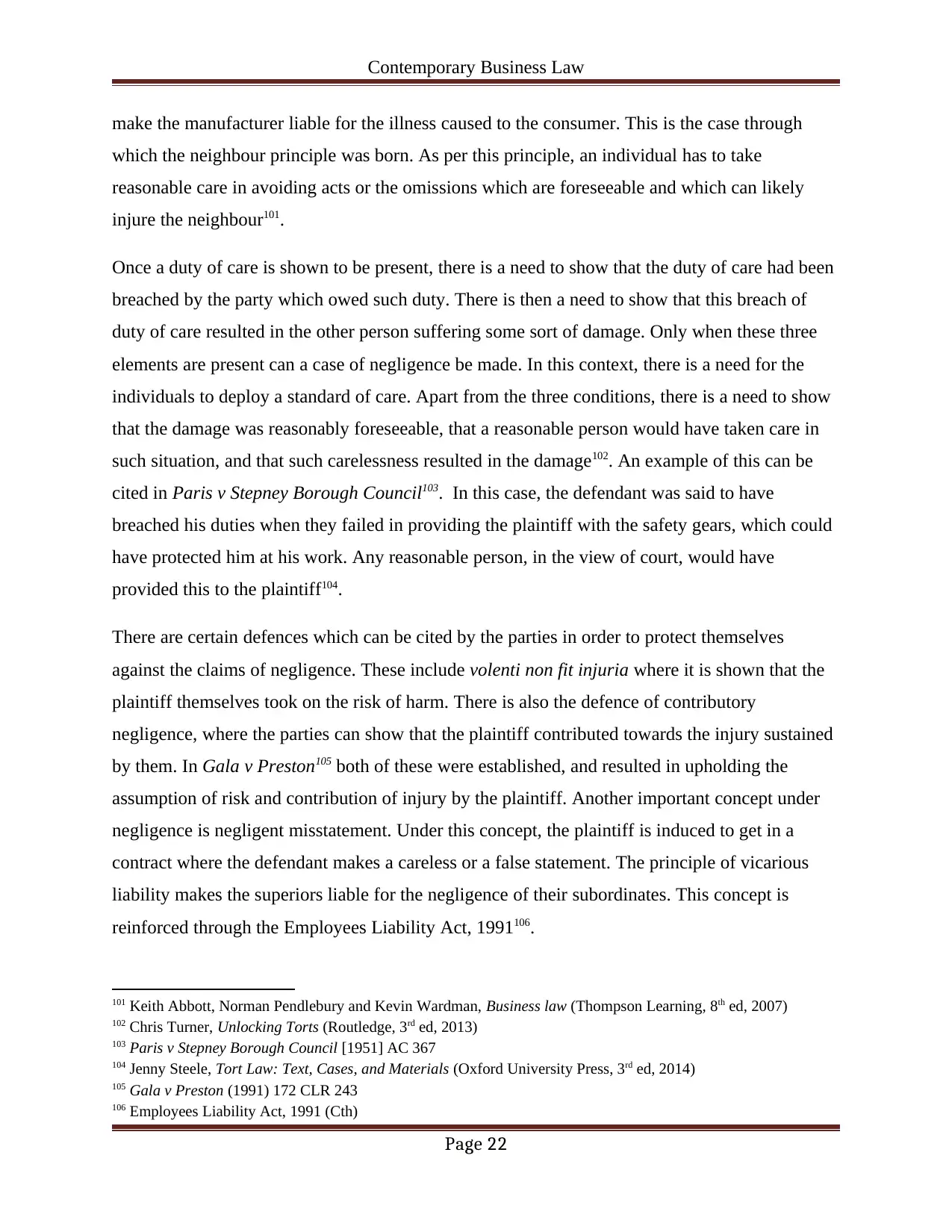
Contemporary Business Law
make the manufacturer liable for the illness caused to the consumer. This is the case through
which the neighbour principle was born. As per this principle, an individual has to take
reasonable care in avoiding acts or the omissions which are foreseeable and which can likely
injure the neighbour101.
Once a duty of care is shown to be present, there is a need to show that the duty of care had been
breached by the party which owed such duty. There is then a need to show that this breach of
duty of care resulted in the other person suffering some sort of damage. Only when these three
elements are present can a case of negligence be made. In this context, there is a need for the
individuals to deploy a standard of care. Apart from the three conditions, there is a need to show
that the damage was reasonably foreseeable, that a reasonable person would have taken care in
such situation, and that such carelessness resulted in the damage102. An example of this can be
cited in Paris v Stepney Borough Council103. In this case, the defendant was said to have
breached his duties when they failed in providing the plaintiff with the safety gears, which could
have protected him at his work. Any reasonable person, in the view of court, would have
provided this to the plaintiff104.
There are certain defences which can be cited by the parties in order to protect themselves
against the claims of negligence. These include volenti non fit injuria where it is shown that the
plaintiff themselves took on the risk of harm. There is also the defence of contributory
negligence, where the parties can show that the plaintiff contributed towards the injury sustained
by them. In Gala v Preston105 both of these were established, and resulted in upholding the
assumption of risk and contribution of injury by the plaintiff. Another important concept under
negligence is negligent misstatement. Under this concept, the plaintiff is induced to get in a
contract where the defendant makes a careless or a false statement. The principle of vicarious
liability makes the superiors liable for the negligence of their subordinates. This concept is
reinforced through the Employees Liability Act, 1991106.
101 Keith Abbott, Norman Pendlebury and Kevin Wardman, Business law (Thompson Learning, 8th ed, 2007)
102 Chris Turner, Unlocking Torts (Routledge, 3rd ed, 2013)
103 Paris v Stepney Borough Council [1951] AC 367
104 Jenny Steele, Tort Law: Text, Cases, and Materials (Oxford University Press, 3rd ed, 2014)
105 Gala v Preston (1991) 172 CLR 243
106 Employees Liability Act, 1991 (Cth)
Page 22
make the manufacturer liable for the illness caused to the consumer. This is the case through
which the neighbour principle was born. As per this principle, an individual has to take
reasonable care in avoiding acts or the omissions which are foreseeable and which can likely
injure the neighbour101.
Once a duty of care is shown to be present, there is a need to show that the duty of care had been
breached by the party which owed such duty. There is then a need to show that this breach of
duty of care resulted in the other person suffering some sort of damage. Only when these three
elements are present can a case of negligence be made. In this context, there is a need for the
individuals to deploy a standard of care. Apart from the three conditions, there is a need to show
that the damage was reasonably foreseeable, that a reasonable person would have taken care in
such situation, and that such carelessness resulted in the damage102. An example of this can be
cited in Paris v Stepney Borough Council103. In this case, the defendant was said to have
breached his duties when they failed in providing the plaintiff with the safety gears, which could
have protected him at his work. Any reasonable person, in the view of court, would have
provided this to the plaintiff104.
There are certain defences which can be cited by the parties in order to protect themselves
against the claims of negligence. These include volenti non fit injuria where it is shown that the
plaintiff themselves took on the risk of harm. There is also the defence of contributory
negligence, where the parties can show that the plaintiff contributed towards the injury sustained
by them. In Gala v Preston105 both of these were established, and resulted in upholding the
assumption of risk and contribution of injury by the plaintiff. Another important concept under
negligence is negligent misstatement. Under this concept, the plaintiff is induced to get in a
contract where the defendant makes a careless or a false statement. The principle of vicarious
liability makes the superiors liable for the negligence of their subordinates. This concept is
reinforced through the Employees Liability Act, 1991106.
101 Keith Abbott, Norman Pendlebury and Kevin Wardman, Business law (Thompson Learning, 8th ed, 2007)
102 Chris Turner, Unlocking Torts (Routledge, 3rd ed, 2013)
103 Paris v Stepney Borough Council [1951] AC 367
104 Jenny Steele, Tort Law: Text, Cases, and Materials (Oxford University Press, 3rd ed, 2014)
105 Gala v Preston (1991) 172 CLR 243
106 Employees Liability Act, 1991 (Cth)
Page 22
Secure Best Marks with AI Grader
Need help grading? Try our AI Grader for instant feedback on your assignments.
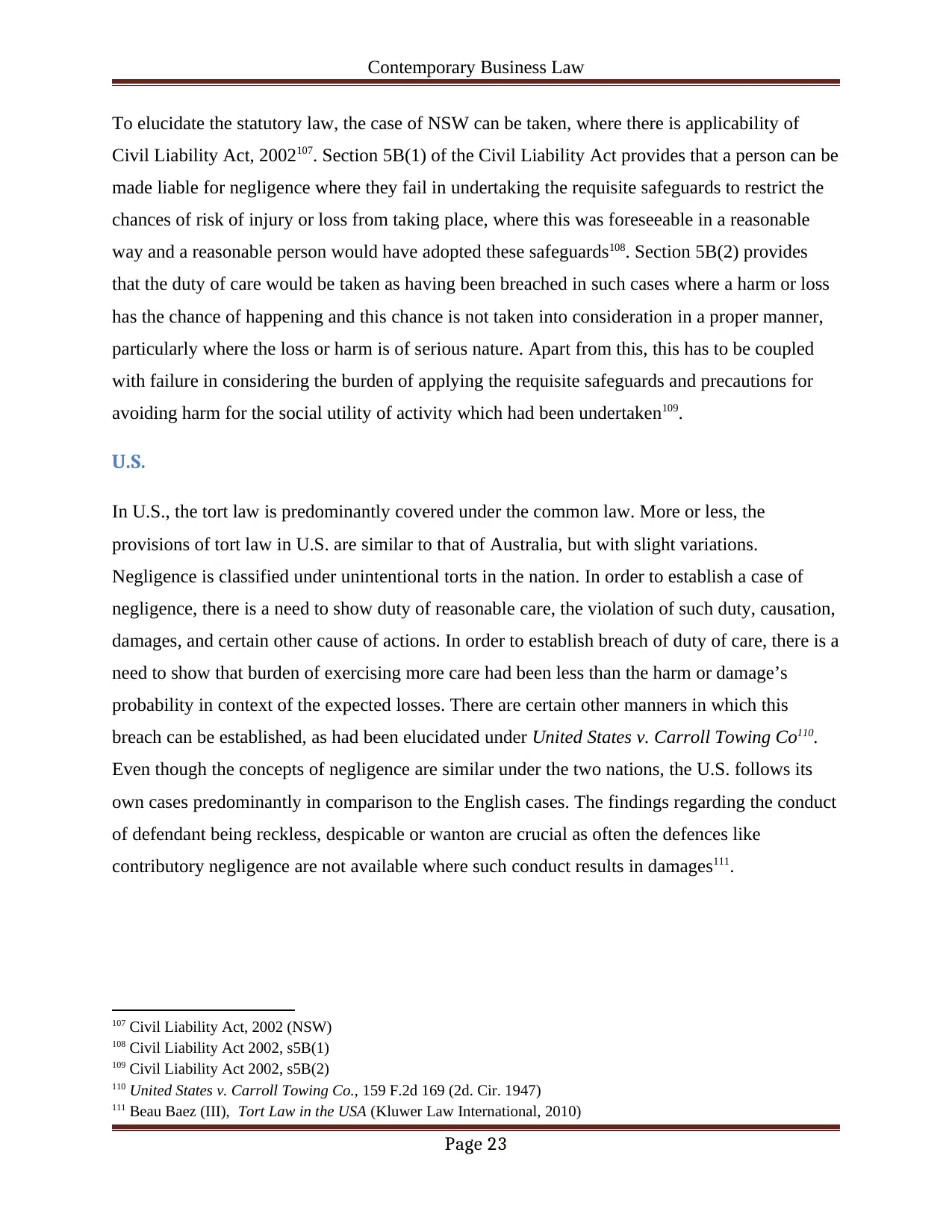
Contemporary Business Law
To elucidate the statutory law, the case of NSW can be taken, where there is applicability of
Civil Liability Act, 2002107. Section 5B(1) of the Civil Liability Act provides that a person can be
made liable for negligence where they fail in undertaking the requisite safeguards to restrict the
chances of risk of injury or loss from taking place, where this was foreseeable in a reasonable
way and a reasonable person would have adopted these safeguards108. Section 5B(2) provides
that the duty of care would be taken as having been breached in such cases where a harm or loss
has the chance of happening and this chance is not taken into consideration in a proper manner,
particularly where the loss or harm is of serious nature. Apart from this, this has to be coupled
with failure in considering the burden of applying the requisite safeguards and precautions for
avoiding harm for the social utility of activity which had been undertaken109.
U.S.
In U.S., the tort law is predominantly covered under the common law. More or less, the
provisions of tort law in U.S. are similar to that of Australia, but with slight variations.
Negligence is classified under unintentional torts in the nation. In order to establish a case of
negligence, there is a need to show duty of reasonable care, the violation of such duty, causation,
damages, and certain other cause of actions. In order to establish breach of duty of care, there is a
need to show that burden of exercising more care had been less than the harm or damage’s
probability in context of the expected losses. There are certain other manners in which this
breach can be established, as had been elucidated under United States v. Carroll Towing Co110.
Even though the concepts of negligence are similar under the two nations, the U.S. follows its
own cases predominantly in comparison to the English cases. The findings regarding the conduct
of defendant being reckless, despicable or wanton are crucial as often the defences like
contributory negligence are not available where such conduct results in damages111.
107 Civil Liability Act, 2002 (NSW)
108 Civil Liability Act 2002, s5B(1)
109 Civil Liability Act 2002, s5B(2)
110 United States v. Carroll Towing Co., 159 F.2d 169 (2d. Cir. 1947)
111 Beau Baez (III), Tort Law in the USA (Kluwer Law International, 2010)
Page 23
To elucidate the statutory law, the case of NSW can be taken, where there is applicability of
Civil Liability Act, 2002107. Section 5B(1) of the Civil Liability Act provides that a person can be
made liable for negligence where they fail in undertaking the requisite safeguards to restrict the
chances of risk of injury or loss from taking place, where this was foreseeable in a reasonable
way and a reasonable person would have adopted these safeguards108. Section 5B(2) provides
that the duty of care would be taken as having been breached in such cases where a harm or loss
has the chance of happening and this chance is not taken into consideration in a proper manner,
particularly where the loss or harm is of serious nature. Apart from this, this has to be coupled
with failure in considering the burden of applying the requisite safeguards and precautions for
avoiding harm for the social utility of activity which had been undertaken109.
U.S.
In U.S., the tort law is predominantly covered under the common law. More or less, the
provisions of tort law in U.S. are similar to that of Australia, but with slight variations.
Negligence is classified under unintentional torts in the nation. In order to establish a case of
negligence, there is a need to show duty of reasonable care, the violation of such duty, causation,
damages, and certain other cause of actions. In order to establish breach of duty of care, there is a
need to show that burden of exercising more care had been less than the harm or damage’s
probability in context of the expected losses. There are certain other manners in which this
breach can be established, as had been elucidated under United States v. Carroll Towing Co110.
Even though the concepts of negligence are similar under the two nations, the U.S. follows its
own cases predominantly in comparison to the English cases. The findings regarding the conduct
of defendant being reckless, despicable or wanton are crucial as often the defences like
contributory negligence are not available where such conduct results in damages111.
107 Civil Liability Act, 2002 (NSW)
108 Civil Liability Act 2002, s5B(1)
109 Civil Liability Act 2002, s5B(2)
110 United States v. Carroll Towing Co., 159 F.2d 169 (2d. Cir. 1947)
111 Beau Baez (III), Tort Law in the USA (Kluwer Law International, 2010)
Page 23
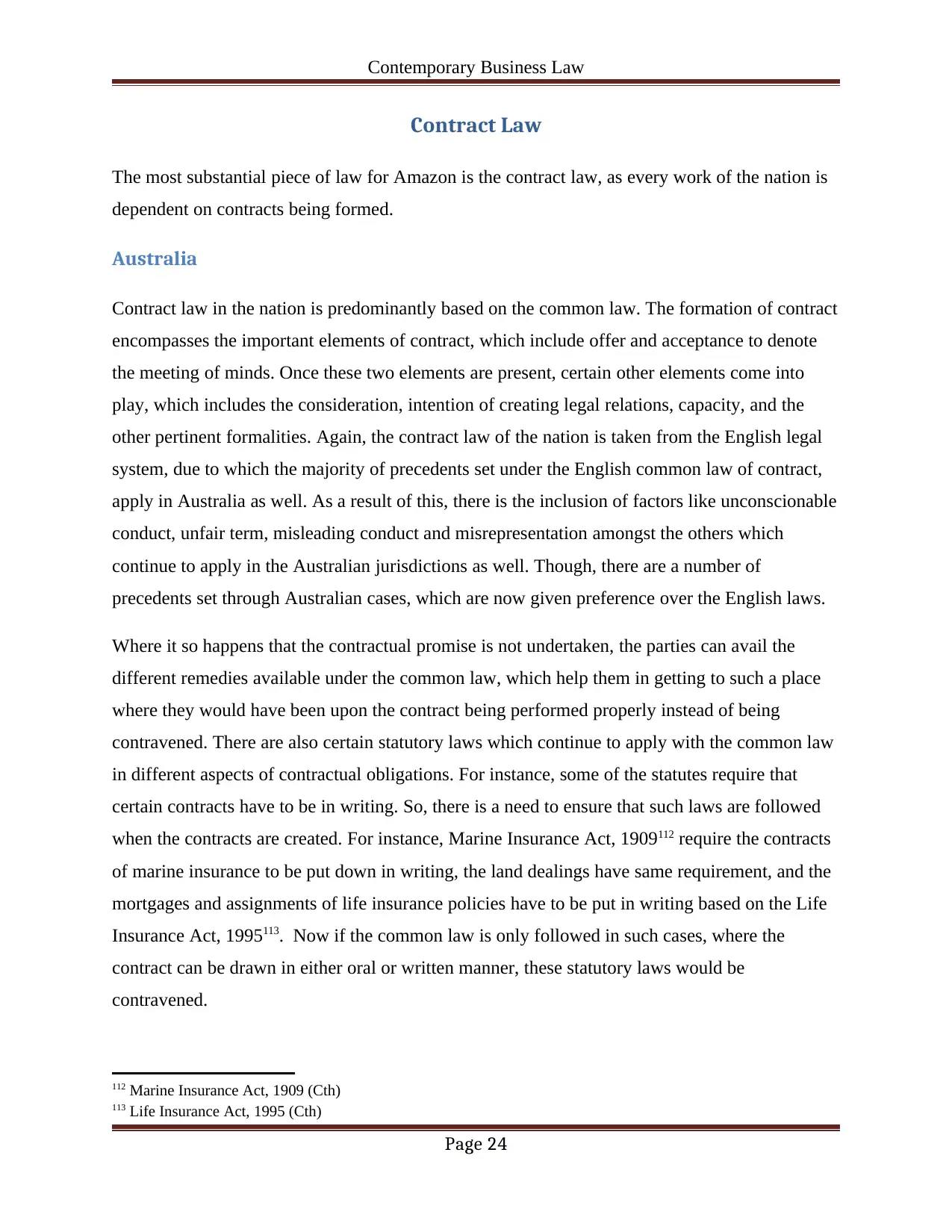
Contemporary Business Law
Contract Law
The most substantial piece of law for Amazon is the contract law, as every work of the nation is
dependent on contracts being formed.
Australia
Contract law in the nation is predominantly based on the common law. The formation of contract
encompasses the important elements of contract, which include offer and acceptance to denote
the meeting of minds. Once these two elements are present, certain other elements come into
play, which includes the consideration, intention of creating legal relations, capacity, and the
other pertinent formalities. Again, the contract law of the nation is taken from the English legal
system, due to which the majority of precedents set under the English common law of contract,
apply in Australia as well. As a result of this, there is the inclusion of factors like unconscionable
conduct, unfair term, misleading conduct and misrepresentation amongst the others which
continue to apply in the Australian jurisdictions as well. Though, there are a number of
precedents set through Australian cases, which are now given preference over the English laws.
Where it so happens that the contractual promise is not undertaken, the parties can avail the
different remedies available under the common law, which help them in getting to such a place
where they would have been upon the contract being performed properly instead of being
contravened. There are also certain statutory laws which continue to apply with the common law
in different aspects of contractual obligations. For instance, some of the statutes require that
certain contracts have to be in writing. So, there is a need to ensure that such laws are followed
when the contracts are created. For instance, Marine Insurance Act, 1909112 require the contracts
of marine insurance to be put down in writing, the land dealings have same requirement, and the
mortgages and assignments of life insurance policies have to be put in writing based on the Life
Insurance Act, 1995113. Now if the common law is only followed in such cases, where the
contract can be drawn in either oral or written manner, these statutory laws would be
contravened.
112 Marine Insurance Act, 1909 (Cth)
113 Life Insurance Act, 1995 (Cth)
Page 24
Contract Law
The most substantial piece of law for Amazon is the contract law, as every work of the nation is
dependent on contracts being formed.
Australia
Contract law in the nation is predominantly based on the common law. The formation of contract
encompasses the important elements of contract, which include offer and acceptance to denote
the meeting of minds. Once these two elements are present, certain other elements come into
play, which includes the consideration, intention of creating legal relations, capacity, and the
other pertinent formalities. Again, the contract law of the nation is taken from the English legal
system, due to which the majority of precedents set under the English common law of contract,
apply in Australia as well. As a result of this, there is the inclusion of factors like unconscionable
conduct, unfair term, misleading conduct and misrepresentation amongst the others which
continue to apply in the Australian jurisdictions as well. Though, there are a number of
precedents set through Australian cases, which are now given preference over the English laws.
Where it so happens that the contractual promise is not undertaken, the parties can avail the
different remedies available under the common law, which help them in getting to such a place
where they would have been upon the contract being performed properly instead of being
contravened. There are also certain statutory laws which continue to apply with the common law
in different aspects of contractual obligations. For instance, some of the statutes require that
certain contracts have to be in writing. So, there is a need to ensure that such laws are followed
when the contracts are created. For instance, Marine Insurance Act, 1909112 require the contracts
of marine insurance to be put down in writing, the land dealings have same requirement, and the
mortgages and assignments of life insurance policies have to be put in writing based on the Life
Insurance Act, 1995113. Now if the common law is only followed in such cases, where the
contract can be drawn in either oral or written manner, these statutory laws would be
contravened.
112 Marine Insurance Act, 1909 (Cth)
113 Life Insurance Act, 1995 (Cth)
Page 24
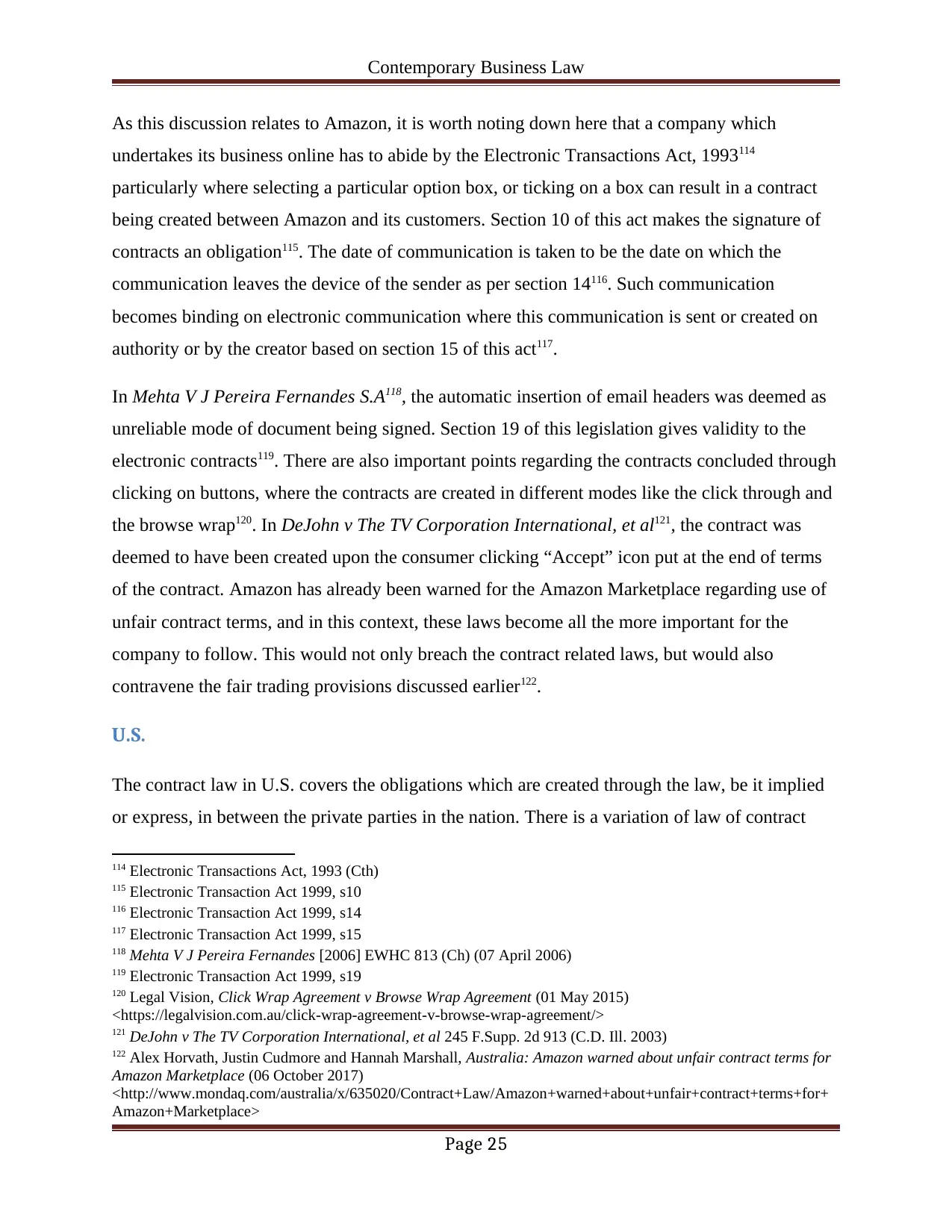
Contemporary Business Law
As this discussion relates to Amazon, it is worth noting down here that a company which
undertakes its business online has to abide by the Electronic Transactions Act, 1993114
particularly where selecting a particular option box, or ticking on a box can result in a contract
being created between Amazon and its customers. Section 10 of this act makes the signature of
contracts an obligation115. The date of communication is taken to be the date on which the
communication leaves the device of the sender as per section 14116. Such communication
becomes binding on electronic communication where this communication is sent or created on
authority or by the creator based on section 15 of this act117.
In Mehta V J Pereira Fernandes S.A118, the automatic insertion of email headers was deemed as
unreliable mode of document being signed. Section 19 of this legislation gives validity to the
electronic contracts119. There are also important points regarding the contracts concluded through
clicking on buttons, where the contracts are created in different modes like the click through and
the browse wrap120. In DeJohn v The TV Corporation International, et al121, the contract was
deemed to have been created upon the consumer clicking “Accept” icon put at the end of terms
of the contract. Amazon has already been warned for the Amazon Marketplace regarding use of
unfair contract terms, and in this context, these laws become all the more important for the
company to follow. This would not only breach the contract related laws, but would also
contravene the fair trading provisions discussed earlier122.
U.S.
The contract law in U.S. covers the obligations which are created through the law, be it implied
or express, in between the private parties in the nation. There is a variation of law of contract
114 Electronic Transactions Act, 1993 (Cth)
115 Electronic Transaction Act 1999, s10
116 Electronic Transaction Act 1999, s14
117 Electronic Transaction Act 1999, s15
118 Mehta V J Pereira Fernandes [2006] EWHC 813 (Ch) (07 April 2006)
119 Electronic Transaction Act 1999, s19
120 Legal Vision, Click Wrap Agreement v Browse Wrap Agreement (01 May 2015)
<https://legalvision.com.au/click-wrap-agreement-v-browse-wrap-agreement/>
121 DeJohn v The TV Corporation International, et al 245 F.Supp. 2d 913 (C.D. Ill. 2003)
122 Alex Horvath, Justin Cudmore and Hannah Marshall, Australia: Amazon warned about unfair contract terms for
Amazon Marketplace (06 October 2017)
<http://www.mondaq.com/australia/x/635020/Contract+Law/Amazon+warned+about+unfair+contract+terms+for+
Amazon+Marketplace>
Page 25
As this discussion relates to Amazon, it is worth noting down here that a company which
undertakes its business online has to abide by the Electronic Transactions Act, 1993114
particularly where selecting a particular option box, or ticking on a box can result in a contract
being created between Amazon and its customers. Section 10 of this act makes the signature of
contracts an obligation115. The date of communication is taken to be the date on which the
communication leaves the device of the sender as per section 14116. Such communication
becomes binding on electronic communication where this communication is sent or created on
authority or by the creator based on section 15 of this act117.
In Mehta V J Pereira Fernandes S.A118, the automatic insertion of email headers was deemed as
unreliable mode of document being signed. Section 19 of this legislation gives validity to the
electronic contracts119. There are also important points regarding the contracts concluded through
clicking on buttons, where the contracts are created in different modes like the click through and
the browse wrap120. In DeJohn v The TV Corporation International, et al121, the contract was
deemed to have been created upon the consumer clicking “Accept” icon put at the end of terms
of the contract. Amazon has already been warned for the Amazon Marketplace regarding use of
unfair contract terms, and in this context, these laws become all the more important for the
company to follow. This would not only breach the contract related laws, but would also
contravene the fair trading provisions discussed earlier122.
U.S.
The contract law in U.S. covers the obligations which are created through the law, be it implied
or express, in between the private parties in the nation. There is a variation of law of contract
114 Electronic Transactions Act, 1993 (Cth)
115 Electronic Transaction Act 1999, s10
116 Electronic Transaction Act 1999, s14
117 Electronic Transaction Act 1999, s15
118 Mehta V J Pereira Fernandes [2006] EWHC 813 (Ch) (07 April 2006)
119 Electronic Transaction Act 1999, s19
120 Legal Vision, Click Wrap Agreement v Browse Wrap Agreement (01 May 2015)
<https://legalvision.com.au/click-wrap-agreement-v-browse-wrap-agreement/>
121 DeJohn v The TV Corporation International, et al 245 F.Supp. 2d 913 (C.D. Ill. 2003)
122 Alex Horvath, Justin Cudmore and Hannah Marshall, Australia: Amazon warned about unfair contract terms for
Amazon Marketplace (06 October 2017)
<http://www.mondaq.com/australia/x/635020/Contract+Law/Amazon+warned+about+unfair+contract+terms+for+
Amazon+Marketplace>
Page 25
Paraphrase This Document
Need a fresh take? Get an instant paraphrase of this document with our AI Paraphraser
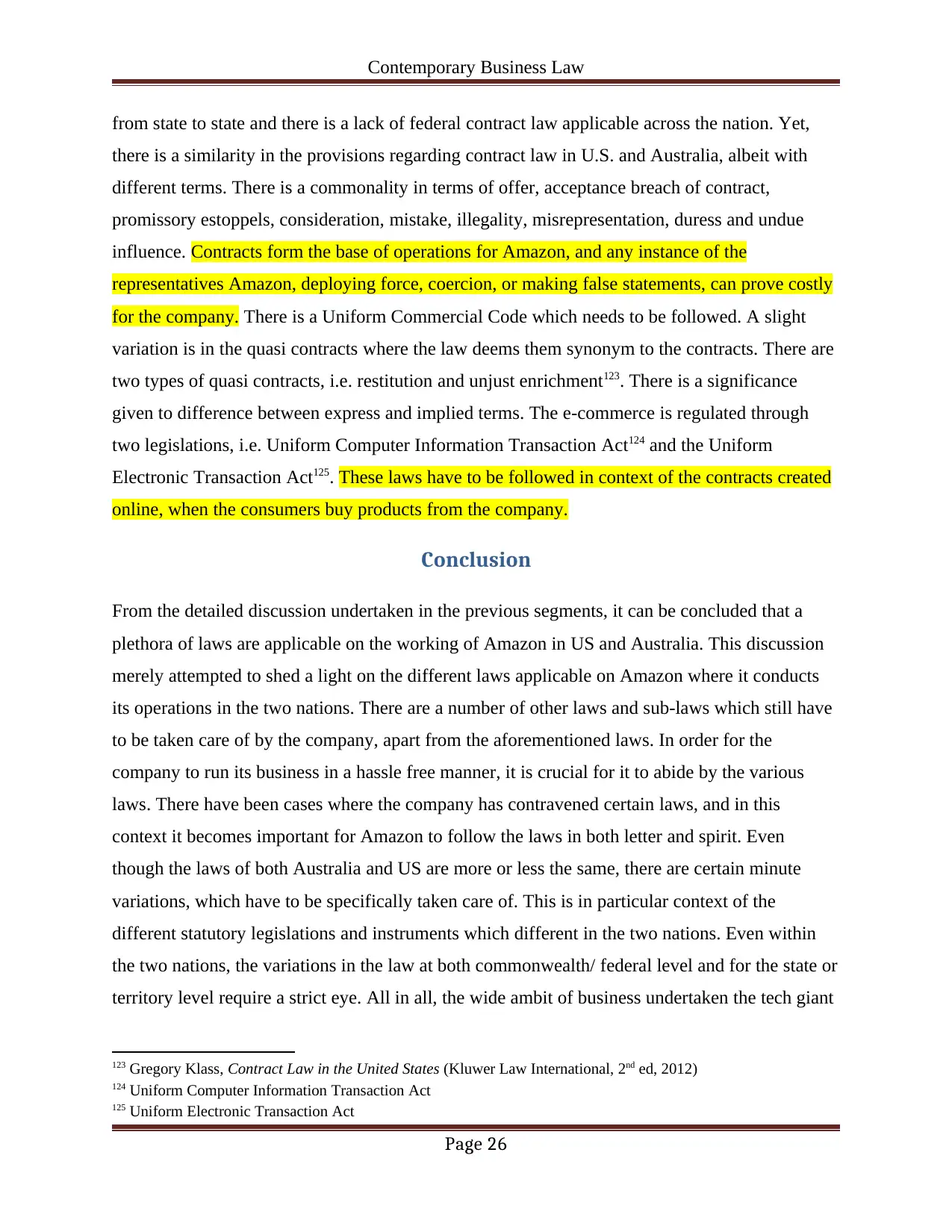
Contemporary Business Law
from state to state and there is a lack of federal contract law applicable across the nation. Yet,
there is a similarity in the provisions regarding contract law in U.S. and Australia, albeit with
different terms. There is a commonality in terms of offer, acceptance breach of contract,
promissory estoppels, consideration, mistake, illegality, misrepresentation, duress and undue
influence. Contracts form the base of operations for Amazon, and any instance of the
representatives Amazon, deploying force, coercion, or making false statements, can prove costly
for the company. There is a Uniform Commercial Code which needs to be followed. A slight
variation is in the quasi contracts where the law deems them synonym to the contracts. There are
two types of quasi contracts, i.e. restitution and unjust enrichment123. There is a significance
given to difference between express and implied terms. The e-commerce is regulated through
two legislations, i.e. Uniform Computer Information Transaction Act124 and the Uniform
Electronic Transaction Act125. These laws have to be followed in context of the contracts created
online, when the consumers buy products from the company.
Conclusion
From the detailed discussion undertaken in the previous segments, it can be concluded that a
plethora of laws are applicable on the working of Amazon in US and Australia. This discussion
merely attempted to shed a light on the different laws applicable on Amazon where it conducts
its operations in the two nations. There are a number of other laws and sub-laws which still have
to be taken care of by the company, apart from the aforementioned laws. In order for the
company to run its business in a hassle free manner, it is crucial for it to abide by the various
laws. There have been cases where the company has contravened certain laws, and in this
context it becomes important for Amazon to follow the laws in both letter and spirit. Even
though the laws of both Australia and US are more or less the same, there are certain minute
variations, which have to be specifically taken care of. This is in particular context of the
different statutory legislations and instruments which different in the two nations. Even within
the two nations, the variations in the law at both commonwealth/ federal level and for the state or
territory level require a strict eye. All in all, the wide ambit of business undertaken the tech giant
123 Gregory Klass, Contract Law in the United States (Kluwer Law International, 2nd ed, 2012)
124 Uniform Computer Information Transaction Act
125 Uniform Electronic Transaction Act
Page 26
from state to state and there is a lack of federal contract law applicable across the nation. Yet,
there is a similarity in the provisions regarding contract law in U.S. and Australia, albeit with
different terms. There is a commonality in terms of offer, acceptance breach of contract,
promissory estoppels, consideration, mistake, illegality, misrepresentation, duress and undue
influence. Contracts form the base of operations for Amazon, and any instance of the
representatives Amazon, deploying force, coercion, or making false statements, can prove costly
for the company. There is a Uniform Commercial Code which needs to be followed. A slight
variation is in the quasi contracts where the law deems them synonym to the contracts. There are
two types of quasi contracts, i.e. restitution and unjust enrichment123. There is a significance
given to difference between express and implied terms. The e-commerce is regulated through
two legislations, i.e. Uniform Computer Information Transaction Act124 and the Uniform
Electronic Transaction Act125. These laws have to be followed in context of the contracts created
online, when the consumers buy products from the company.
Conclusion
From the detailed discussion undertaken in the previous segments, it can be concluded that a
plethora of laws are applicable on the working of Amazon in US and Australia. This discussion
merely attempted to shed a light on the different laws applicable on Amazon where it conducts
its operations in the two nations. There are a number of other laws and sub-laws which still have
to be taken care of by the company, apart from the aforementioned laws. In order for the
company to run its business in a hassle free manner, it is crucial for it to abide by the various
laws. There have been cases where the company has contravened certain laws, and in this
context it becomes important for Amazon to follow the laws in both letter and spirit. Even
though the laws of both Australia and US are more or less the same, there are certain minute
variations, which have to be specifically taken care of. This is in particular context of the
different statutory legislations and instruments which different in the two nations. Even within
the two nations, the variations in the law at both commonwealth/ federal level and for the state or
territory level require a strict eye. All in all, the wide ambit of business undertaken the tech giant
123 Gregory Klass, Contract Law in the United States (Kluwer Law International, 2nd ed, 2012)
124 Uniform Computer Information Transaction Act
125 Uniform Electronic Transaction Act
Page 26
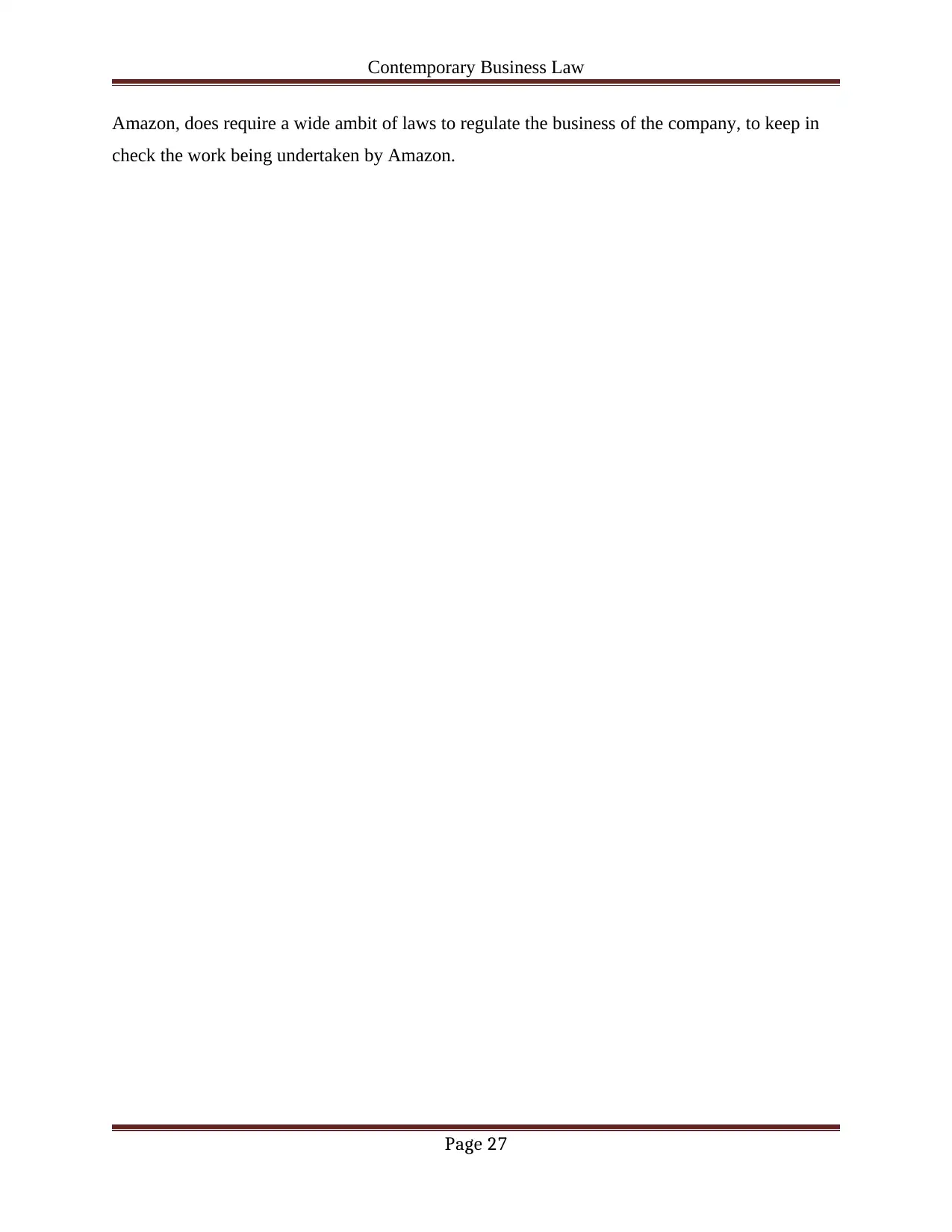
Contemporary Business Law
Amazon, does require a wide ambit of laws to regulate the business of the company, to keep in
check the work being undertaken by Amazon.
Page 27
Amazon, does require a wide ambit of laws to regulate the business of the company, to keep in
check the work being undertaken by Amazon.
Page 27
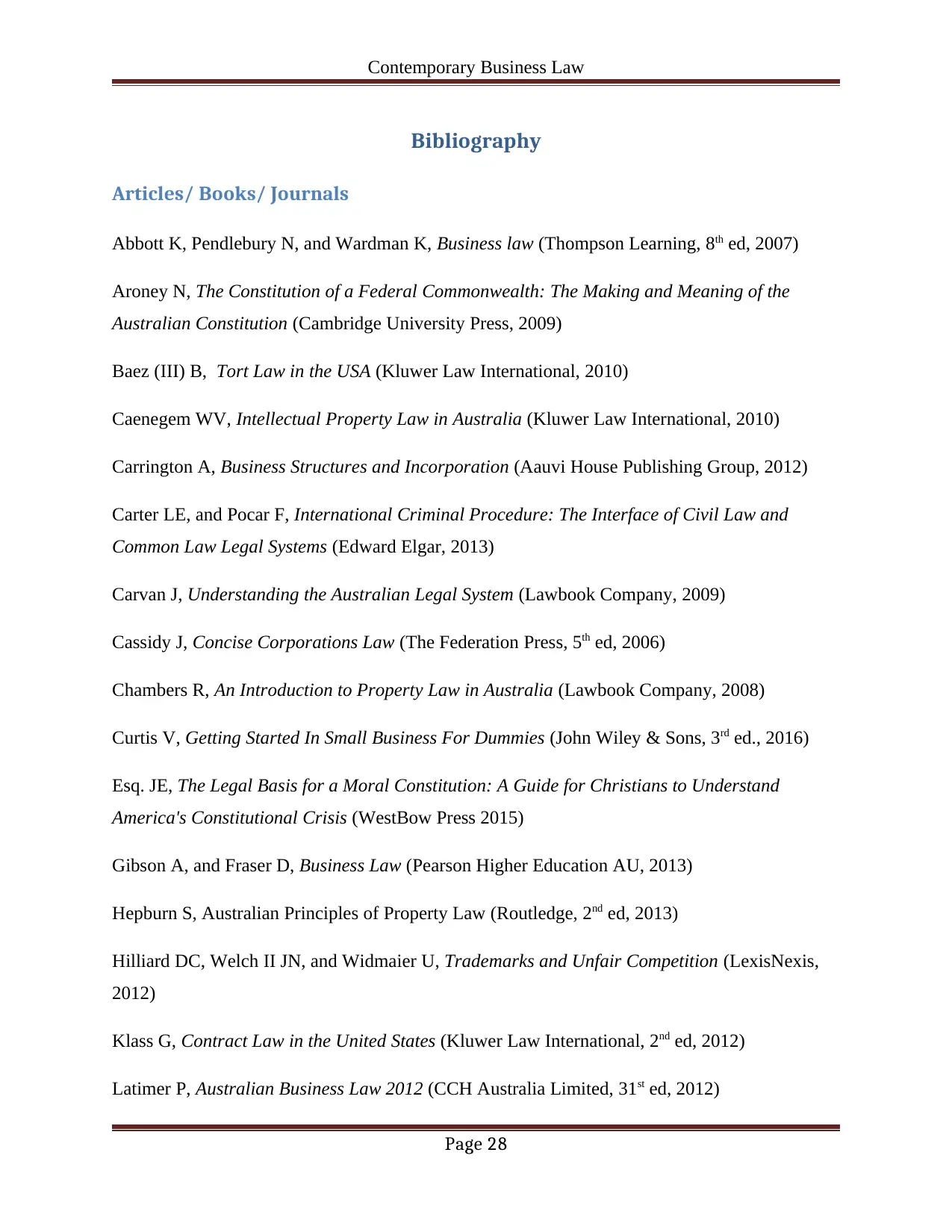
Contemporary Business Law
Bibliography
Articles/ Books/ Journals
Abbott K, Pendlebury N, and Wardman K, Business law (Thompson Learning, 8th ed, 2007)
Aroney N, The Constitution of a Federal Commonwealth: The Making and Meaning of the
Australian Constitution (Cambridge University Press, 2009)
Baez (III) B, Tort Law in the USA (Kluwer Law International, 2010)
Caenegem WV, Intellectual Property Law in Australia (Kluwer Law International, 2010)
Carrington A, Business Structures and Incorporation (Aauvi House Publishing Group, 2012)
Carter LE, and Pocar F, International Criminal Procedure: The Interface of Civil Law and
Common Law Legal Systems (Edward Elgar, 2013)
Carvan J, Understanding the Australian Legal System (Lawbook Company, 2009)
Cassidy J, Concise Corporations Law (The Federation Press, 5th ed, 2006)
Chambers R, An Introduction to Property Law in Australia (Lawbook Company, 2008)
Curtis V, Getting Started In Small Business For Dummies (John Wiley & Sons, 3rd ed., 2016)
Esq. JE, The Legal Basis for a Moral Constitution: A Guide for Christians to Understand
America's Constitutional Crisis (WestBow Press 2015)
Gibson A, and Fraser D, Business Law (Pearson Higher Education AU, 2013)
Hepburn S, Australian Principles of Property Law (Routledge, 2nd ed, 2013)
Hilliard DC, Welch II JN, and Widmaier U, Trademarks and Unfair Competition (LexisNexis,
2012)
Klass G, Contract Law in the United States (Kluwer Law International, 2nd ed, 2012)
Latimer P, Australian Business Law 2012 (CCH Australia Limited, 31st ed, 2012)
Page 28
Bibliography
Articles/ Books/ Journals
Abbott K, Pendlebury N, and Wardman K, Business law (Thompson Learning, 8th ed, 2007)
Aroney N, The Constitution of a Federal Commonwealth: The Making and Meaning of the
Australian Constitution (Cambridge University Press, 2009)
Baez (III) B, Tort Law in the USA (Kluwer Law International, 2010)
Caenegem WV, Intellectual Property Law in Australia (Kluwer Law International, 2010)
Carrington A, Business Structures and Incorporation (Aauvi House Publishing Group, 2012)
Carter LE, and Pocar F, International Criminal Procedure: The Interface of Civil Law and
Common Law Legal Systems (Edward Elgar, 2013)
Carvan J, Understanding the Australian Legal System (Lawbook Company, 2009)
Cassidy J, Concise Corporations Law (The Federation Press, 5th ed, 2006)
Chambers R, An Introduction to Property Law in Australia (Lawbook Company, 2008)
Curtis V, Getting Started In Small Business For Dummies (John Wiley & Sons, 3rd ed., 2016)
Esq. JE, The Legal Basis for a Moral Constitution: A Guide for Christians to Understand
America's Constitutional Crisis (WestBow Press 2015)
Gibson A, and Fraser D, Business Law (Pearson Higher Education AU, 2013)
Hepburn S, Australian Principles of Property Law (Routledge, 2nd ed, 2013)
Hilliard DC, Welch II JN, and Widmaier U, Trademarks and Unfair Competition (LexisNexis,
2012)
Klass G, Contract Law in the United States (Kluwer Law International, 2nd ed, 2012)
Latimer P, Australian Business Law 2012 (CCH Australia Limited, 31st ed, 2012)
Page 28
Secure Best Marks with AI Grader
Need help grading? Try our AI Grader for instant feedback on your assignments.
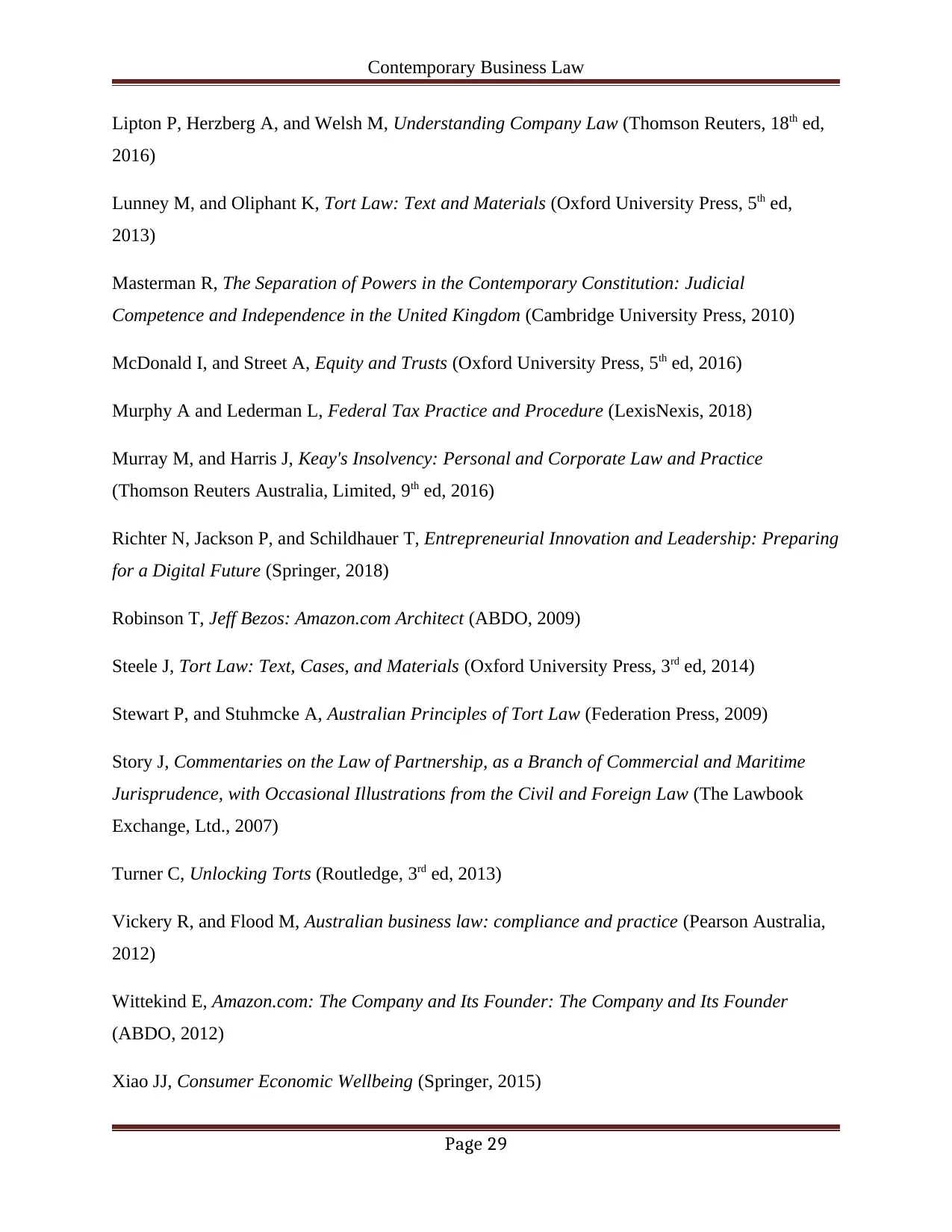
Contemporary Business Law
Lipton P, Herzberg A, and Welsh M, Understanding Company Law (Thomson Reuters, 18th ed,
2016)
Lunney M, and Oliphant K, Tort Law: Text and Materials (Oxford University Press, 5th ed,
2013)
Masterman R, The Separation of Powers in the Contemporary Constitution: Judicial
Competence and Independence in the United Kingdom (Cambridge University Press, 2010)
McDonald I, and Street A, Equity and Trusts (Oxford University Press, 5th ed, 2016)
Murphy A and Lederman L, Federal Tax Practice and Procedure (LexisNexis, 2018)
Murray M, and Harris J, Keay's Insolvency: Personal and Corporate Law and Practice
(Thomson Reuters Australia, Limited, 9th ed, 2016)
Richter N, Jackson P, and Schildhauer T, Entrepreneurial Innovation and Leadership: Preparing
for a Digital Future (Springer, 2018)
Robinson T, Jeff Bezos: Amazon.com Architect (ABDO, 2009)
Steele J, Tort Law: Text, Cases, and Materials (Oxford University Press, 3rd ed, 2014)
Stewart P, and Stuhmcke A, Australian Principles of Tort Law (Federation Press, 2009)
Story J, Commentaries on the Law of Partnership, as a Branch of Commercial and Maritime
Jurisprudence, with Occasional Illustrations from the Civil and Foreign Law (The Lawbook
Exchange, Ltd., 2007)
Turner C, Unlocking Torts (Routledge, 3rd ed, 2013)
Vickery R, and Flood M, Australian business law: compliance and practice (Pearson Australia,
2012)
Wittekind E, Amazon.com: The Company and Its Founder: The Company and Its Founder
(ABDO, 2012)
Xiao JJ, Consumer Economic Wellbeing (Springer, 2015)
Page 29
Lipton P, Herzberg A, and Welsh M, Understanding Company Law (Thomson Reuters, 18th ed,
2016)
Lunney M, and Oliphant K, Tort Law: Text and Materials (Oxford University Press, 5th ed,
2013)
Masterman R, The Separation of Powers in the Contemporary Constitution: Judicial
Competence and Independence in the United Kingdom (Cambridge University Press, 2010)
McDonald I, and Street A, Equity and Trusts (Oxford University Press, 5th ed, 2016)
Murphy A and Lederman L, Federal Tax Practice and Procedure (LexisNexis, 2018)
Murray M, and Harris J, Keay's Insolvency: Personal and Corporate Law and Practice
(Thomson Reuters Australia, Limited, 9th ed, 2016)
Richter N, Jackson P, and Schildhauer T, Entrepreneurial Innovation and Leadership: Preparing
for a Digital Future (Springer, 2018)
Robinson T, Jeff Bezos: Amazon.com Architect (ABDO, 2009)
Steele J, Tort Law: Text, Cases, and Materials (Oxford University Press, 3rd ed, 2014)
Stewart P, and Stuhmcke A, Australian Principles of Tort Law (Federation Press, 2009)
Story J, Commentaries on the Law of Partnership, as a Branch of Commercial and Maritime
Jurisprudence, with Occasional Illustrations from the Civil and Foreign Law (The Lawbook
Exchange, Ltd., 2007)
Turner C, Unlocking Torts (Routledge, 3rd ed, 2013)
Vickery R, and Flood M, Australian business law: compliance and practice (Pearson Australia,
2012)
Wittekind E, Amazon.com: The Company and Its Founder: The Company and Its Founder
(ABDO, 2012)
Xiao JJ, Consumer Economic Wellbeing (Springer, 2015)
Page 29
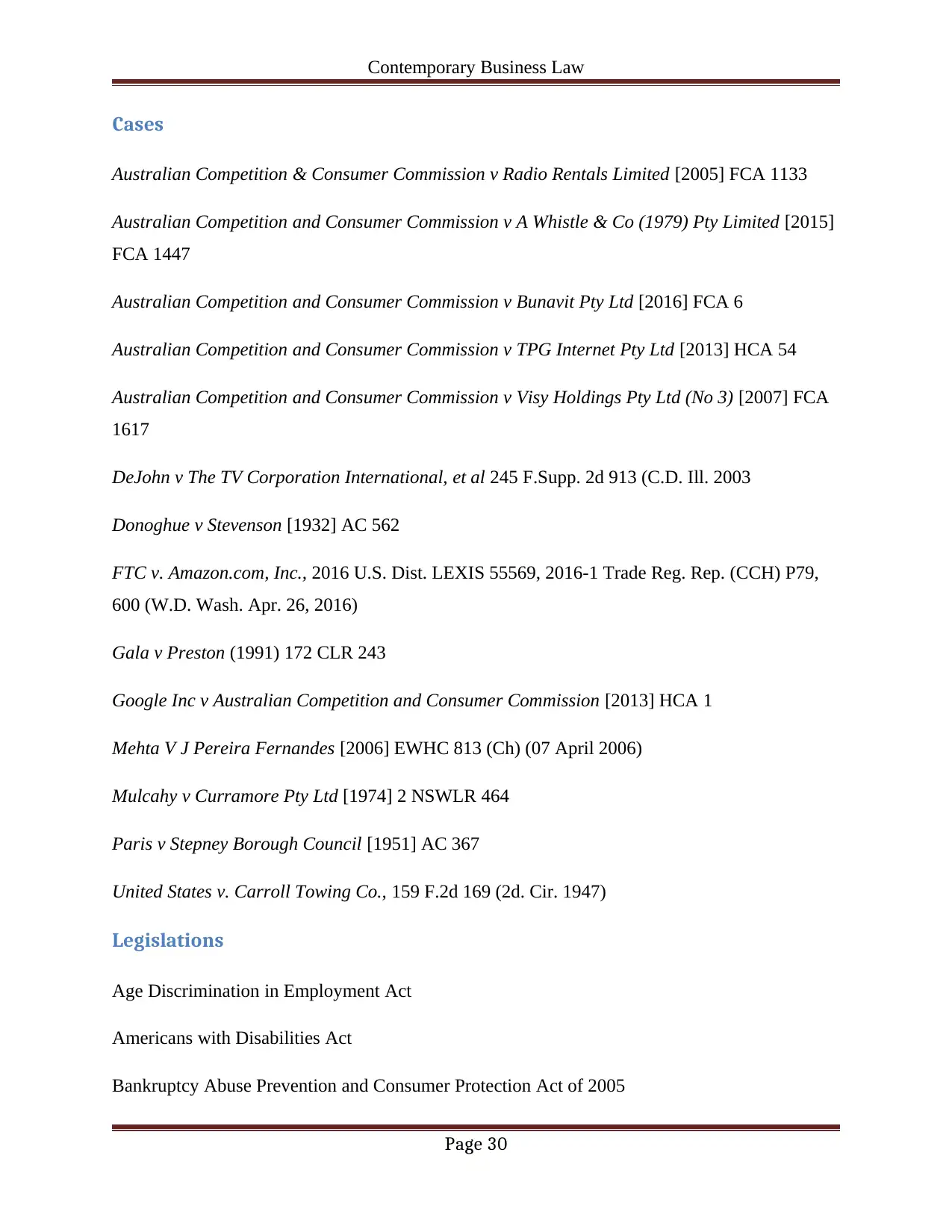
Contemporary Business Law
Cases
Australian Competition & Consumer Commission v Radio Rentals Limited [2005] FCA 1133
Australian Competition and Consumer Commission v A Whistle & Co (1979) Pty Limited [2015]
FCA 1447
Australian Competition and Consumer Commission v Bunavit Pty Ltd [2016] FCA 6
Australian Competition and Consumer Commission v TPG Internet Pty Ltd [2013] HCA 54
Australian Competition and Consumer Commission v Visy Holdings Pty Ltd (No 3) [2007] FCA
1617
DeJohn v The TV Corporation International, et al 245 F.Supp. 2d 913 (C.D. Ill. 2003
Donoghue v Stevenson [1932] AC 562
FTC v. Amazon.com, Inc., 2016 U.S. Dist. LEXIS 55569, 2016-1 Trade Reg. Rep. (CCH) P79,
600 (W.D. Wash. Apr. 26, 2016)
Gala v Preston (1991) 172 CLR 243
Google Inc v Australian Competition and Consumer Commission [2013] HCA 1
Mehta V J Pereira Fernandes [2006] EWHC 813 (Ch) (07 April 2006)
Mulcahy v Curramore Pty Ltd [1974] 2 NSWLR 464
Paris v Stepney Borough Council [1951] AC 367
United States v. Carroll Towing Co., 159 F.2d 169 (2d. Cir. 1947)
Legislations
Age Discrimination in Employment Act
Americans with Disabilities Act
Bankruptcy Abuse Prevention and Consumer Protection Act of 2005
Page 30
Cases
Australian Competition & Consumer Commission v Radio Rentals Limited [2005] FCA 1133
Australian Competition and Consumer Commission v A Whistle & Co (1979) Pty Limited [2015]
FCA 1447
Australian Competition and Consumer Commission v Bunavit Pty Ltd [2016] FCA 6
Australian Competition and Consumer Commission v TPG Internet Pty Ltd [2013] HCA 54
Australian Competition and Consumer Commission v Visy Holdings Pty Ltd (No 3) [2007] FCA
1617
DeJohn v The TV Corporation International, et al 245 F.Supp. 2d 913 (C.D. Ill. 2003
Donoghue v Stevenson [1932] AC 562
FTC v. Amazon.com, Inc., 2016 U.S. Dist. LEXIS 55569, 2016-1 Trade Reg. Rep. (CCH) P79,
600 (W.D. Wash. Apr. 26, 2016)
Gala v Preston (1991) 172 CLR 243
Google Inc v Australian Competition and Consumer Commission [2013] HCA 1
Mehta V J Pereira Fernandes [2006] EWHC 813 (Ch) (07 April 2006)
Mulcahy v Curramore Pty Ltd [1974] 2 NSWLR 464
Paris v Stepney Borough Council [1951] AC 367
United States v. Carroll Towing Co., 159 F.2d 169 (2d. Cir. 1947)
Legislations
Age Discrimination in Employment Act
Americans with Disabilities Act
Bankruptcy Abuse Prevention and Consumer Protection Act of 2005
Page 30
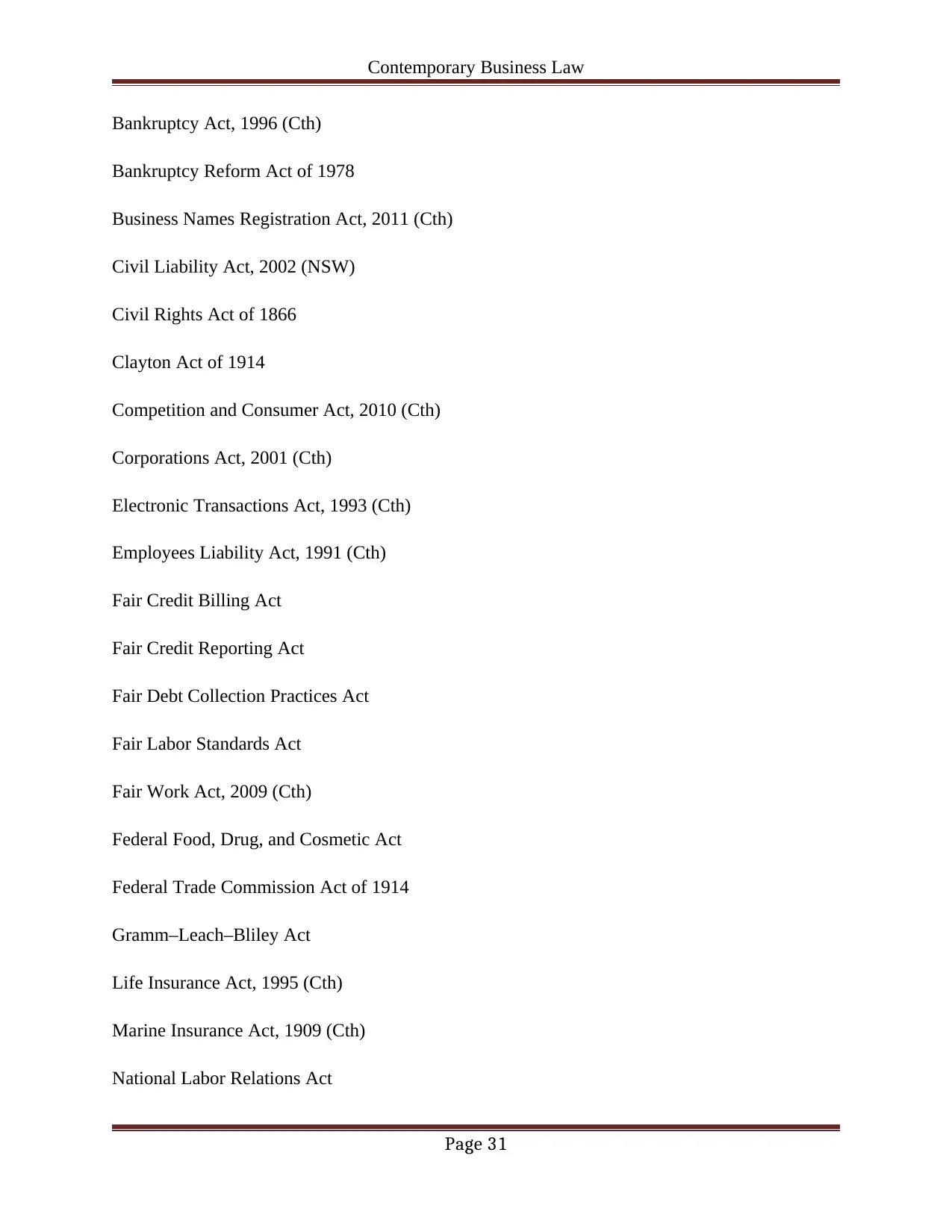
Contemporary Business Law
Bankruptcy Act, 1996 (Cth)
Bankruptcy Reform Act of 1978
Business Names Registration Act, 2011 (Cth)
Civil Liability Act, 2002 (NSW)
Civil Rights Act of 1866
Clayton Act of 1914
Competition and Consumer Act, 2010 (Cth)
Corporations Act, 2001 (Cth)
Electronic Transactions Act, 1993 (Cth)
Employees Liability Act, 1991 (Cth)
Fair Credit Billing Act
Fair Credit Reporting Act
Fair Debt Collection Practices Act
Fair Labor Standards Act
Fair Work Act, 2009 (Cth)
Federal Food, Drug, and Cosmetic Act
Federal Trade Commission Act of 1914
Gramm–Leach–Bliley Act
Life Insurance Act, 1995 (Cth)
Marine Insurance Act, 1909 (Cth)
National Labor Relations Act
Page 31
Bankruptcy Act, 1996 (Cth)
Bankruptcy Reform Act of 1978
Business Names Registration Act, 2011 (Cth)
Civil Liability Act, 2002 (NSW)
Civil Rights Act of 1866
Clayton Act of 1914
Competition and Consumer Act, 2010 (Cth)
Corporations Act, 2001 (Cth)
Electronic Transactions Act, 1993 (Cth)
Employees Liability Act, 1991 (Cth)
Fair Credit Billing Act
Fair Credit Reporting Act
Fair Debt Collection Practices Act
Fair Labor Standards Act
Fair Work Act, 2009 (Cth)
Federal Food, Drug, and Cosmetic Act
Federal Trade Commission Act of 1914
Gramm–Leach–Bliley Act
Life Insurance Act, 1995 (Cth)
Marine Insurance Act, 1909 (Cth)
National Labor Relations Act
Page 31
Paraphrase This Document
Need a fresh take? Get an instant paraphrase of this document with our AI Paraphraser
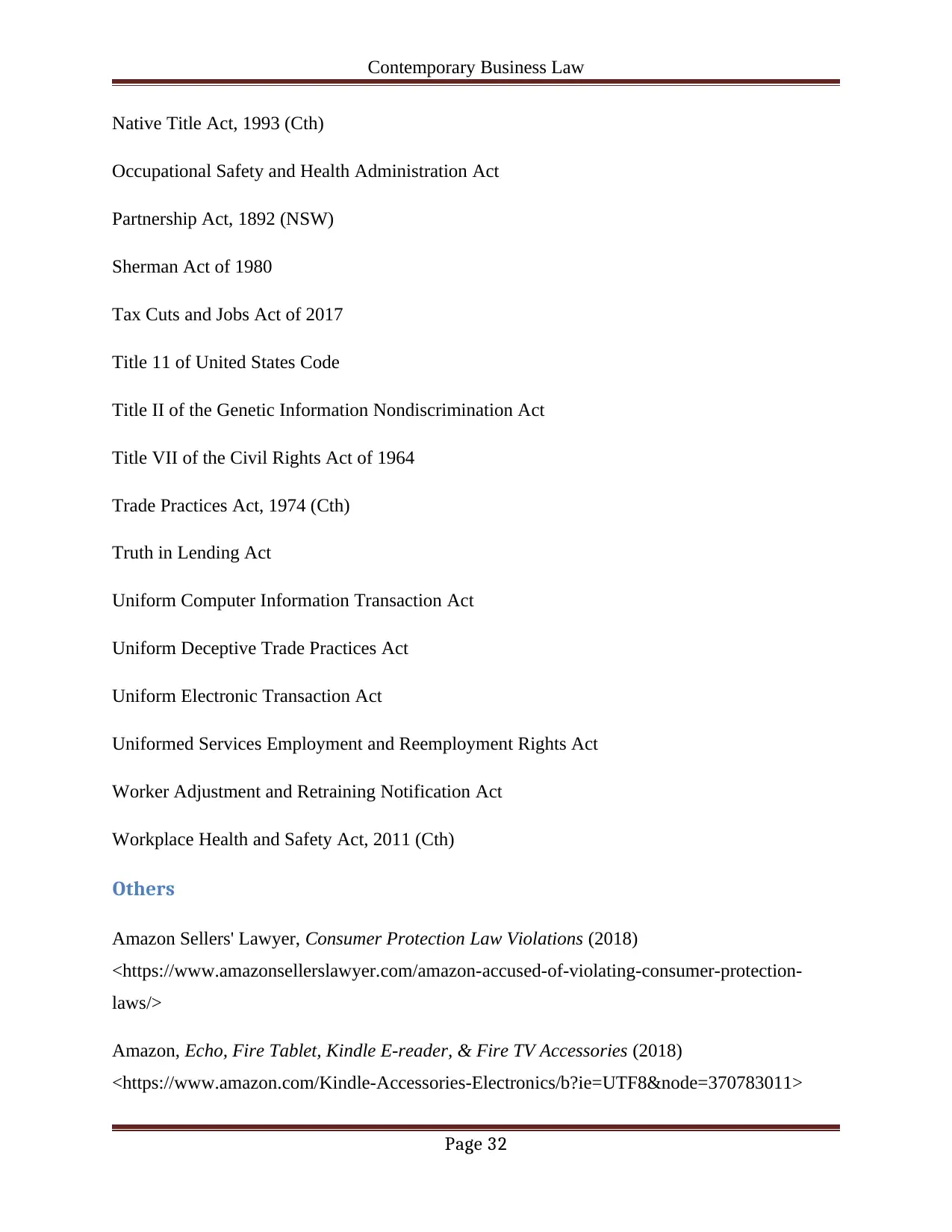
Contemporary Business Law
Native Title Act, 1993 (Cth)
Occupational Safety and Health Administration Act
Partnership Act, 1892 (NSW)
Sherman Act of 1980
Tax Cuts and Jobs Act of 2017
Title 11 of United States Code
Title II of the Genetic Information Nondiscrimination Act
Title VII of the Civil Rights Act of 1964
Trade Practices Act, 1974 (Cth)
Truth in Lending Act
Uniform Computer Information Transaction Act
Uniform Deceptive Trade Practices Act
Uniform Electronic Transaction Act
Uniformed Services Employment and Reemployment Rights Act
Worker Adjustment and Retraining Notification Act
Workplace Health and Safety Act, 2011 (Cth)
Others
Amazon Sellers' Lawyer, Consumer Protection Law Violations (2018)
<https://www.amazonsellerslawyer.com/amazon-accused-of-violating-consumer-protection-
laws/>
Amazon, Echo, Fire Tablet, Kindle E-reader, & Fire TV Accessories (2018)
<https://www.amazon.com/Kindle-Accessories-Electronics/b?ie=UTF8&node=370783011>
Page 32
Native Title Act, 1993 (Cth)
Occupational Safety and Health Administration Act
Partnership Act, 1892 (NSW)
Sherman Act of 1980
Tax Cuts and Jobs Act of 2017
Title 11 of United States Code
Title II of the Genetic Information Nondiscrimination Act
Title VII of the Civil Rights Act of 1964
Trade Practices Act, 1974 (Cth)
Truth in Lending Act
Uniform Computer Information Transaction Act
Uniform Deceptive Trade Practices Act
Uniform Electronic Transaction Act
Uniformed Services Employment and Reemployment Rights Act
Worker Adjustment and Retraining Notification Act
Workplace Health and Safety Act, 2011 (Cth)
Others
Amazon Sellers' Lawyer, Consumer Protection Law Violations (2018)
<https://www.amazonsellerslawyer.com/amazon-accused-of-violating-consumer-protection-
laws/>
Amazon, Echo, Fire Tablet, Kindle E-reader, & Fire TV Accessories (2018)
<https://www.amazon.com/Kindle-Accessories-Electronics/b?ie=UTF8&node=370783011>
Page 32
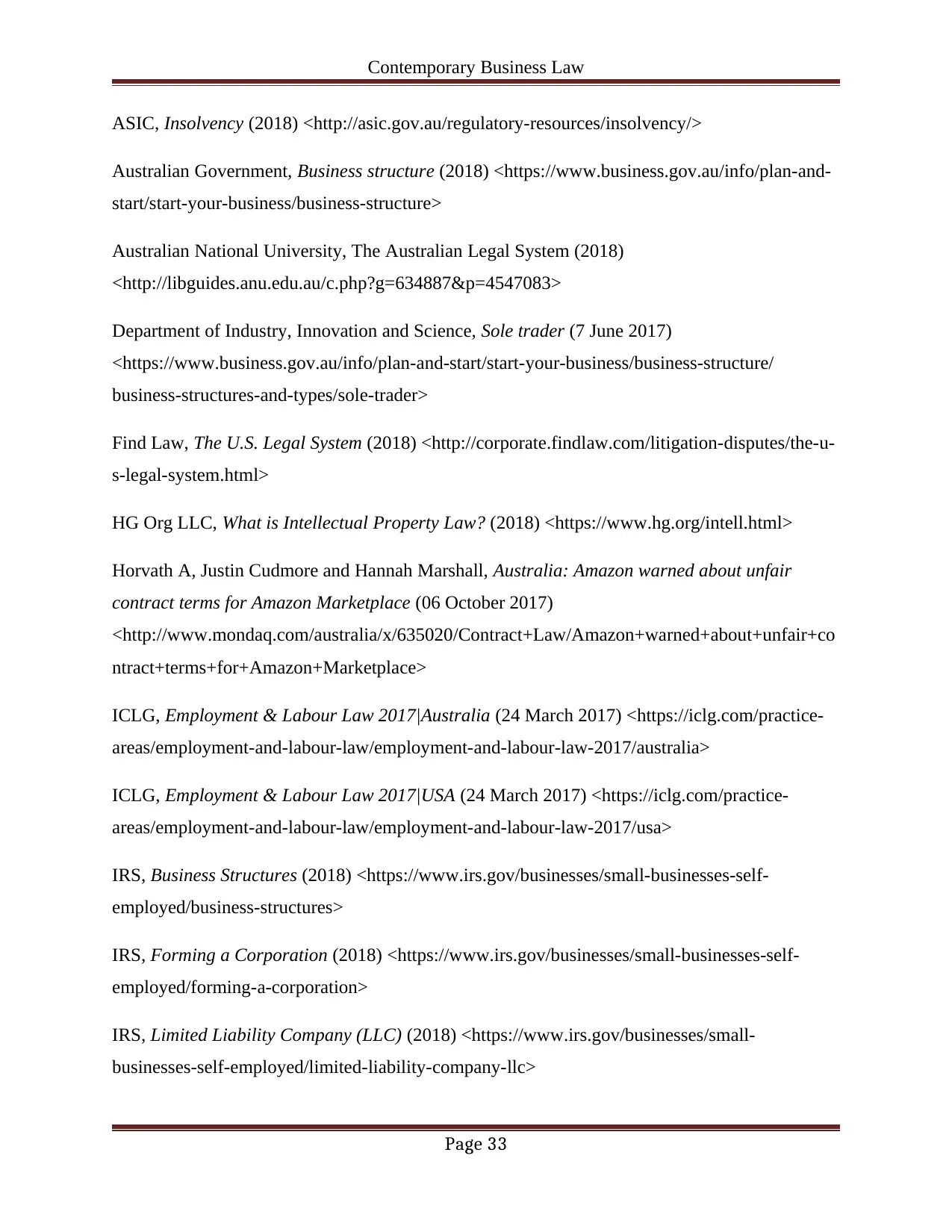
Contemporary Business Law
ASIC, Insolvency (2018) <http://asic.gov.au/regulatory-resources/insolvency/>
Australian Government, Business structure (2018) <https://www.business.gov.au/info/plan-and-
start/start-your-business/business-structure>
Australian National University, The Australian Legal System (2018)
<http://libguides.anu.edu.au/c.php?g=634887&p=4547083>
Department of Industry, Innovation and Science, Sole trader (7 June 2017)
<https://www.business.gov.au/info/plan-and-start/start-your-business/business-structure/
business-structures-and-types/sole-trader>
Find Law, The U.S. Legal System (2018) <http://corporate.findlaw.com/litigation-disputes/the-u-
s-legal-system.html>
HG Org LLC, What is Intellectual Property Law? (2018) <https://www.hg.org/intell.html>
Horvath A, Justin Cudmore and Hannah Marshall, Australia: Amazon warned about unfair
contract terms for Amazon Marketplace (06 October 2017)
<http://www.mondaq.com/australia/x/635020/Contract+Law/Amazon+warned+about+unfair+co
ntract+terms+for+Amazon+Marketplace>
ICLG, Employment & Labour Law 2017|Australia (24 March 2017) <https://iclg.com/practice-
areas/employment-and-labour-law/employment-and-labour-law-2017/australia>
ICLG, Employment & Labour Law 2017|USA (24 March 2017) <https://iclg.com/practice-
areas/employment-and-labour-law/employment-and-labour-law-2017/usa>
IRS, Business Structures (2018) <https://www.irs.gov/businesses/small-businesses-self-
employed/business-structures>
IRS, Forming a Corporation (2018) <https://www.irs.gov/businesses/small-businesses-self-
employed/forming-a-corporation>
IRS, Limited Liability Company (LLC) (2018) <https://www.irs.gov/businesses/small-
businesses-self-employed/limited-liability-company-llc>
Page 33
ASIC, Insolvency (2018) <http://asic.gov.au/regulatory-resources/insolvency/>
Australian Government, Business structure (2018) <https://www.business.gov.au/info/plan-and-
start/start-your-business/business-structure>
Australian National University, The Australian Legal System (2018)
<http://libguides.anu.edu.au/c.php?g=634887&p=4547083>
Department of Industry, Innovation and Science, Sole trader (7 June 2017)
<https://www.business.gov.au/info/plan-and-start/start-your-business/business-structure/
business-structures-and-types/sole-trader>
Find Law, The U.S. Legal System (2018) <http://corporate.findlaw.com/litigation-disputes/the-u-
s-legal-system.html>
HG Org LLC, What is Intellectual Property Law? (2018) <https://www.hg.org/intell.html>
Horvath A, Justin Cudmore and Hannah Marshall, Australia: Amazon warned about unfair
contract terms for Amazon Marketplace (06 October 2017)
<http://www.mondaq.com/australia/x/635020/Contract+Law/Amazon+warned+about+unfair+co
ntract+terms+for+Amazon+Marketplace>
ICLG, Employment & Labour Law 2017|Australia (24 March 2017) <https://iclg.com/practice-
areas/employment-and-labour-law/employment-and-labour-law-2017/australia>
ICLG, Employment & Labour Law 2017|USA (24 March 2017) <https://iclg.com/practice-
areas/employment-and-labour-law/employment-and-labour-law-2017/usa>
IRS, Business Structures (2018) <https://www.irs.gov/businesses/small-businesses-self-
employed/business-structures>
IRS, Forming a Corporation (2018) <https://www.irs.gov/businesses/small-businesses-self-
employed/forming-a-corporation>
IRS, Limited Liability Company (LLC) (2018) <https://www.irs.gov/businesses/small-
businesses-self-employed/limited-liability-company-llc>
Page 33
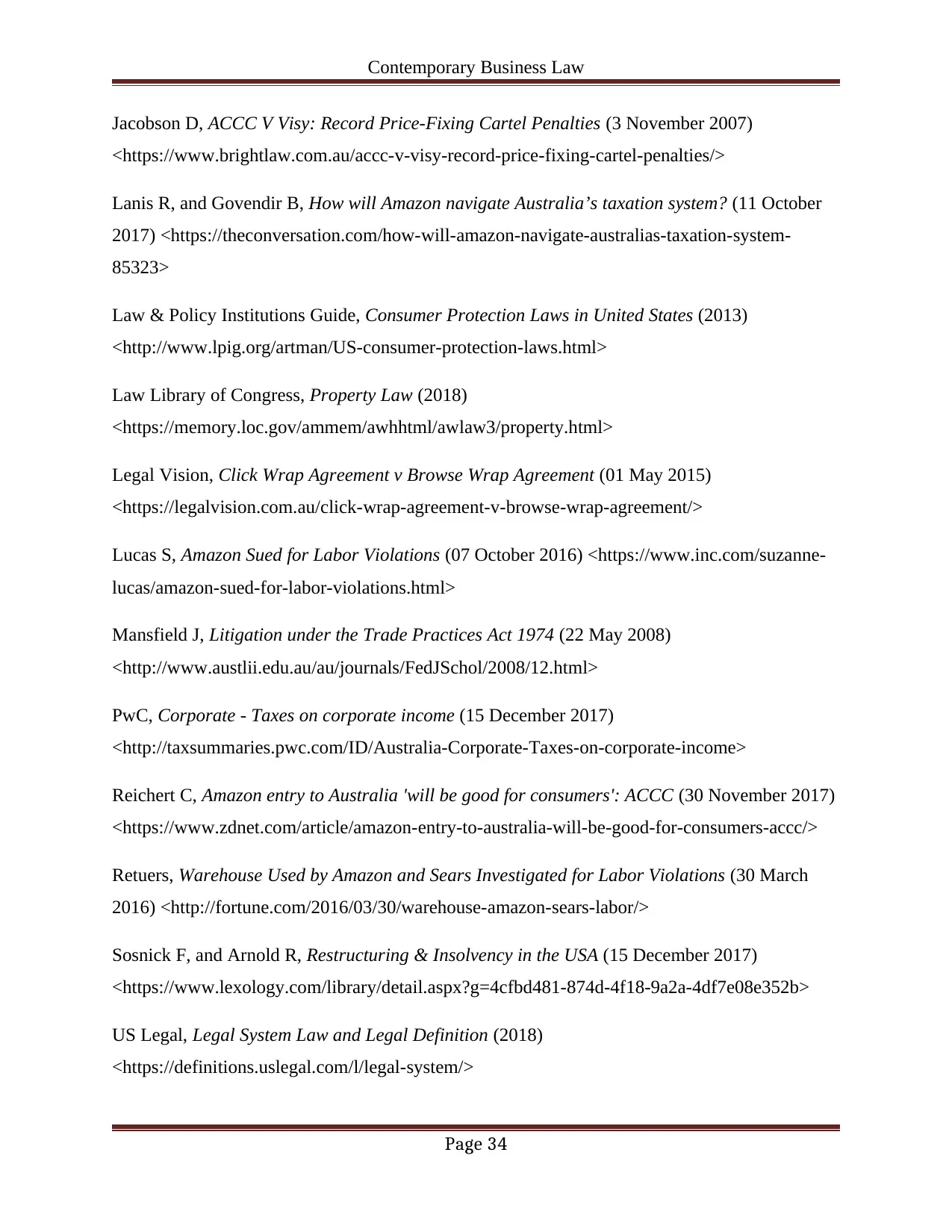
Contemporary Business Law
Jacobson D, ACCC V Visy: Record Price-Fixing Cartel Penalties (3 November 2007)
<https://www.brightlaw.com.au/accc-v-visy-record-price-fixing-cartel-penalties/>
Lanis R, and Govendir B, How will Amazon navigate Australia’s taxation system? (11 October
2017) <https://theconversation.com/how-will-amazon-navigate-australias-taxation-system-
85323>
Law & Policy Institutions Guide, Consumer Protection Laws in United States (2013)
<http://www.lpig.org/artman/US-consumer-protection-laws.html>
Law Library of Congress, Property Law (2018)
<https://memory.loc.gov/ammem/awhhtml/awlaw3/property.html>
Legal Vision, Click Wrap Agreement v Browse Wrap Agreement (01 May 2015)
<https://legalvision.com.au/click-wrap-agreement-v-browse-wrap-agreement/>
Lucas S, Amazon Sued for Labor Violations (07 October 2016) <https://www.inc.com/suzanne-
lucas/amazon-sued-for-labor-violations.html>
Mansfield J, Litigation under the Trade Practices Act 1974 (22 May 2008)
<http://www.austlii.edu.au/au/journals/FedJSchol/2008/12.html>
PwC, Corporate - Taxes on corporate income (15 December 2017)
<http://taxsummaries.pwc.com/ID/Australia-Corporate-Taxes-on-corporate-income>
Reichert C, Amazon entry to Australia 'will be good for consumers': ACCC (30 November 2017)
<https://www.zdnet.com/article/amazon-entry-to-australia-will-be-good-for-consumers-accc/>
Retuers, Warehouse Used by Amazon and Sears Investigated for Labor Violations (30 March
2016) <http://fortune.com/2016/03/30/warehouse-amazon-sears-labor/>
Sosnick F, and Arnold R, Restructuring & Insolvency in the USA (15 December 2017)
<https://www.lexology.com/library/detail.aspx?g=4cfbd481-874d-4f18-9a2a-4df7e08e352b>
US Legal, Legal System Law and Legal Definition (2018)
<https://definitions.uslegal.com/l/legal-system/>
Page 34
Jacobson D, ACCC V Visy: Record Price-Fixing Cartel Penalties (3 November 2007)
<https://www.brightlaw.com.au/accc-v-visy-record-price-fixing-cartel-penalties/>
Lanis R, and Govendir B, How will Amazon navigate Australia’s taxation system? (11 October
2017) <https://theconversation.com/how-will-amazon-navigate-australias-taxation-system-
85323>
Law & Policy Institutions Guide, Consumer Protection Laws in United States (2013)
<http://www.lpig.org/artman/US-consumer-protection-laws.html>
Law Library of Congress, Property Law (2018)
<https://memory.loc.gov/ammem/awhhtml/awlaw3/property.html>
Legal Vision, Click Wrap Agreement v Browse Wrap Agreement (01 May 2015)
<https://legalvision.com.au/click-wrap-agreement-v-browse-wrap-agreement/>
Lucas S, Amazon Sued for Labor Violations (07 October 2016) <https://www.inc.com/suzanne-
lucas/amazon-sued-for-labor-violations.html>
Mansfield J, Litigation under the Trade Practices Act 1974 (22 May 2008)
<http://www.austlii.edu.au/au/journals/FedJSchol/2008/12.html>
PwC, Corporate - Taxes on corporate income (15 December 2017)
<http://taxsummaries.pwc.com/ID/Australia-Corporate-Taxes-on-corporate-income>
Reichert C, Amazon entry to Australia 'will be good for consumers': ACCC (30 November 2017)
<https://www.zdnet.com/article/amazon-entry-to-australia-will-be-good-for-consumers-accc/>
Retuers, Warehouse Used by Amazon and Sears Investigated for Labor Violations (30 March
2016) <http://fortune.com/2016/03/30/warehouse-amazon-sears-labor/>
Sosnick F, and Arnold R, Restructuring & Insolvency in the USA (15 December 2017)
<https://www.lexology.com/library/detail.aspx?g=4cfbd481-874d-4f18-9a2a-4df7e08e352b>
US Legal, Legal System Law and Legal Definition (2018)
<https://definitions.uslegal.com/l/legal-system/>
Page 34
Secure Best Marks with AI Grader
Need help grading? Try our AI Grader for instant feedback on your assignments.

Contemporary Business Law
US Legal, US Legal System (2018) <https://system.uslegal.com/>
White S, Sacramento Amazon Employee Sues Company, Alleging Illegal Working Conditions
(13 December 2017) <https://libertylaw.com/blog/sacramento-amazon-employee-sues-company-
alleging-illegal-working-conditions/>
Page 35
US Legal, US Legal System (2018) <https://system.uslegal.com/>
White S, Sacramento Amazon Employee Sues Company, Alleging Illegal Working Conditions
(13 December 2017) <https://libertylaw.com/blog/sacramento-amazon-employee-sues-company-
alleging-illegal-working-conditions/>
Page 35
1 out of 35
Related Documents
Your All-in-One AI-Powered Toolkit for Academic Success.
+13062052269
info@desklib.com
Available 24*7 on WhatsApp / Email
![[object Object]](/_next/static/media/star-bottom.7253800d.svg)
Unlock your academic potential
© 2024 | Zucol Services PVT LTD | All rights reserved.




